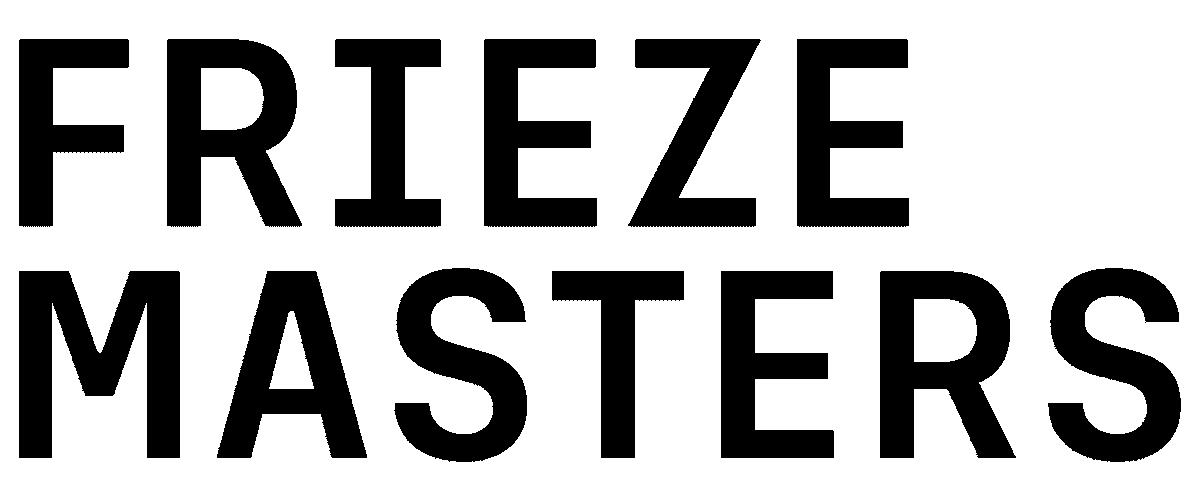
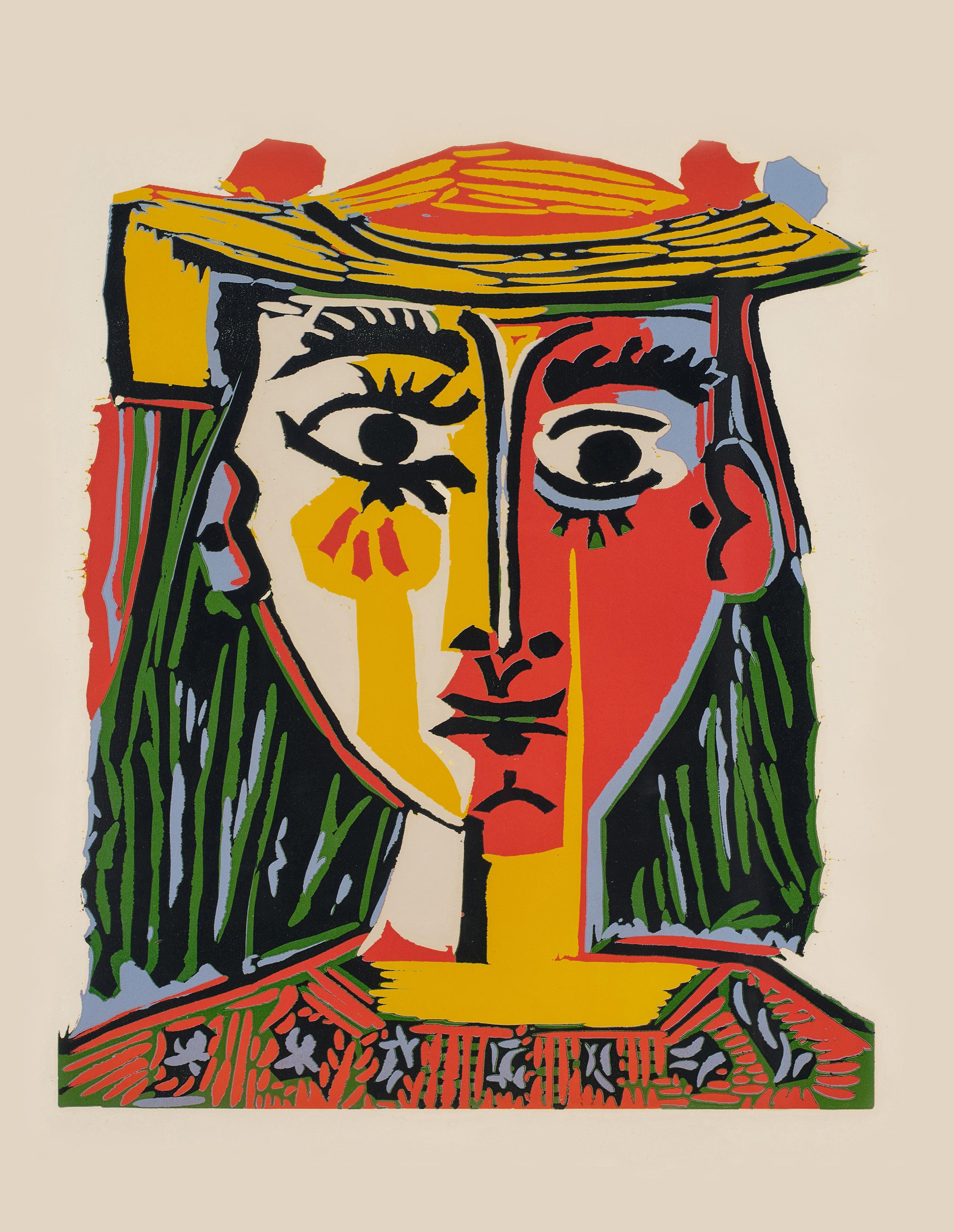



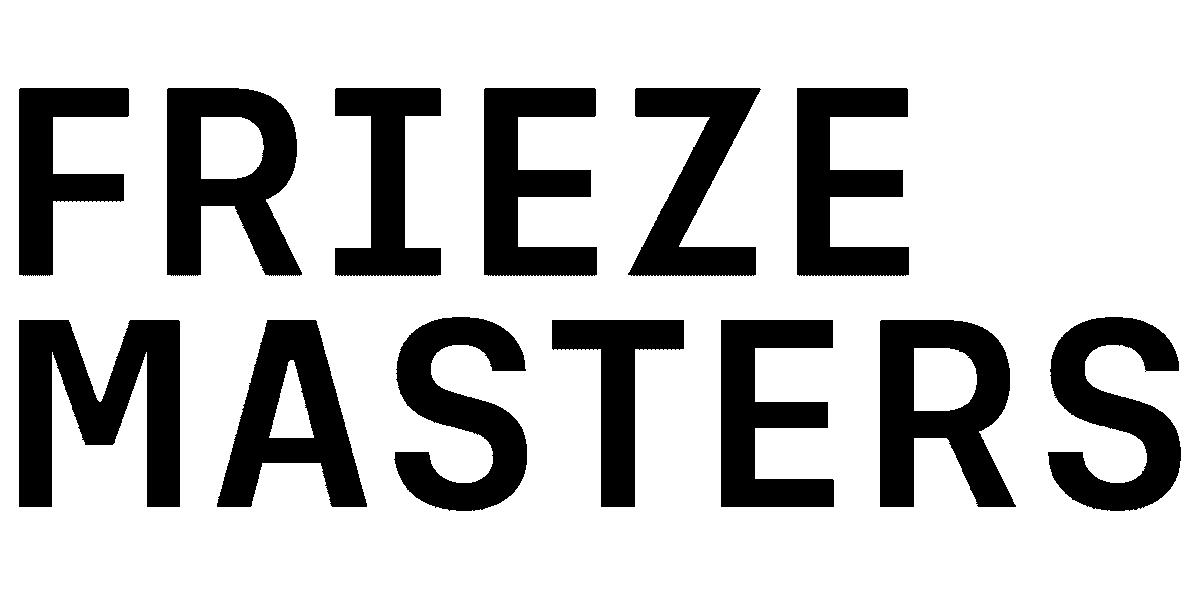
OCTOBER 15TH (BY INVITATION)
OCTOBER 16TH-19TH (PUBLIC DAYS)
LOCATION:
GLOUCESTER GREEN, AT THE NORTHEAST CORNER THE REGENT’S PARK LONDON NW1 4HA FOR SHOW INFORMATION: https://www.frieze.com/fairs/frieze-masters
146 Greene Street
New York, NY 10012
212-489-3331
info@susansheehangallery.com www.susansheehangallery.com
Pablo Picasso’s immense body of work is often understood through chronological periodization, with distinct eras such as the early Blue and Rose periods, African art and Primitivism, Synthetic Cubism, Neoclassicism, and Surrealism. Transformations between creative eras were often catalyzed by the emergence of a new lover and muse. Picasso loved in the same way he worked—prolifically and intensely, marked by dramatic highs and lows.
His relationship with his last great love, Jacqueline Roque, was different. Jacqueline devoted herself entirely to the artist, and Picasso created more portraits of her than of any muse before.
Two masterful linocuts from 1962, Buste de Femme au Chapeau and Portrait de Jacqueline au Chapeau de Paille, embody the artist’s unfettered joy during this period.
In the 1940s, Picasso moved to the village of Vallauris in southern France with his then-partner, Françoise Gilot, and their children, Claude and Paloma. The artist immersed himself in the town’s culture and became particularly entranced by the region’s rich history of pottery, dating back to Roman times. He soon began creating ceramic editions with Suzanne and Georges Ramié at the Madoura workshop. It was there that he met Jacqueline, a young relative of Suzanne, who worked as a saleswoman at the shop. Shortly afterward (though with considerable overlap), his relationship with Françoise came to an end.
During the 1950s, Picasso also created a series of posters for ceramic exhibitions and bullfights to promote tourism in Vallauris. Irritated by the production delays he faced while working with Paris print shops from afar, Picasso turned to local printer Hidalgo Arnera, who specialized in linocut—a form of relief printmaking that was considerably more direct than intaglio or lithography. Picasso’s initial forays into the medium were relatively simple, but the ever-ambitious artist soon sought to create more complex compositions.
In the traditional linocut technique, each color is carved and printed on a separate block of linoleum, which must be perfectly aligned during the printing process. Picasso quickly grew weary of the tediousness and, in collaboration with Arnera, developed a new method known as “reduction linocut.” In this groundbreaking technique, the artist could print multiple colors from the same block through successive rounds of carving. The stakes were high—a single mistake at any stage could ruin the entire composition—but the results were extraordinary.
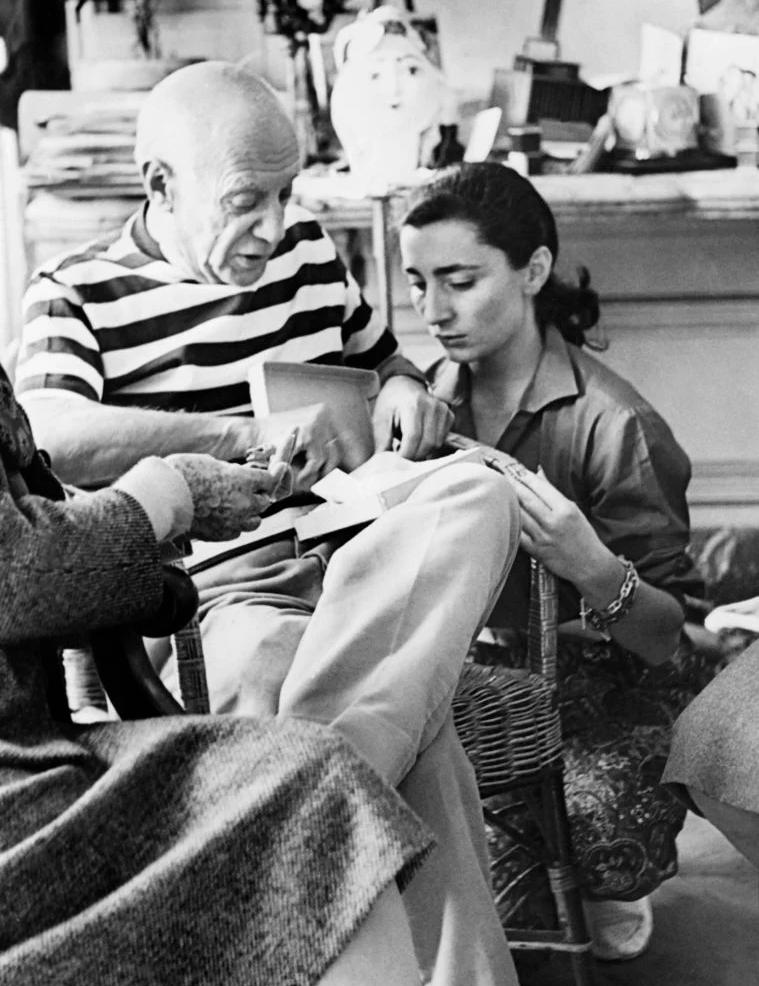
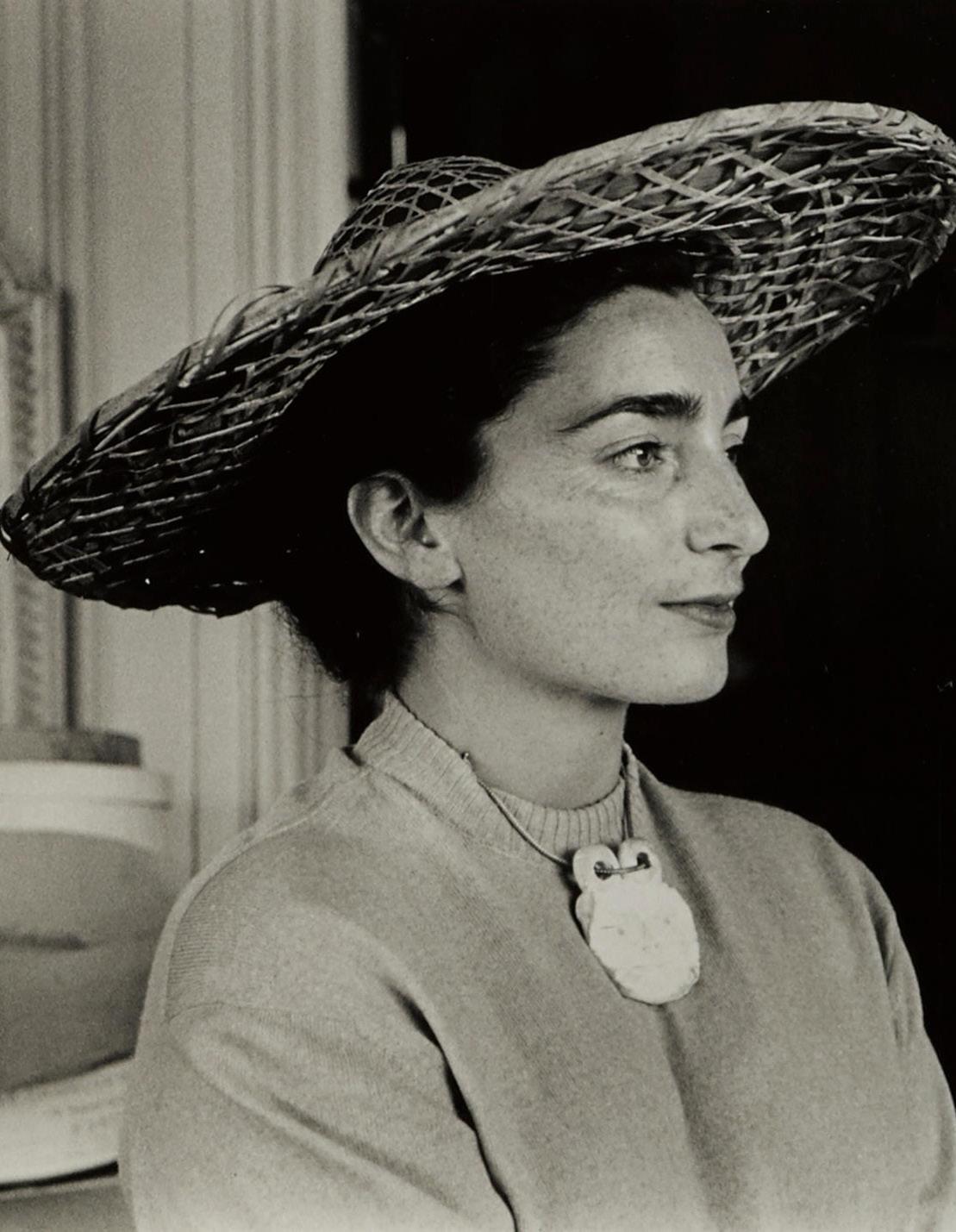
Since early childhood, Picasso had been lauded for his singular talent as a draftsman and painter. In Buste de Femme au Chapeau, this exceptional skill manifests in a new medium. The larger-than-life image of Jacqueline’s face is rendered in vibrant hues of red, yellow, green, and blue—a new development for the artist, whose previous printmaking endeavors had not focused on color. The composition is remarkably well balanced: Jacqueline’s nose and hair are transformed into rigid vertical elements, offset by the horizontal lines of her patterned dress and festive straw hat. The latter element can be interpreted as a cordobés hat, a cultural symbol of the exiled artist’s home region of Andalusia.
Portrait de Jacqueline au Chapeau de Paille was created at the same time as Buste de Femme au Chapeau, and the two works are nearly identical in subject matter and color scheme. Both notably lack any background, directing all attention to the muse. However, the thickly layered ink of the former is replaced by a simplified, Cubist composition in Portrait de Jacqueline au Chapeau de Paille. Despite the reduction of forms, the work is charged with motion and symbolism. Jacqueline’s features are presented in both frontal and profile orientation, refusing to submit to either perspective.
Picasso once claimed that “all good portraits are in some degree caricatures.” In Portrait de Jacqueline au Chapeau de Paille, he renders Jacqueline’s distinctive profile—marked by a stately, patrician nose—in exaggerated proportion and vibrant crimson. In the same striking red, Picasso includes an unmistakable symbol of female fertility in place of a blushing cheek. His use of dual perspective gives rise to his iconic “double-face” motif, in which the muse’s public and private selves are presented simultaneously. The sunny, passionate left side partially obscures the darker portion of her visage on the right.
The nineteen years Picasso spent with Jacqueline were undoubtedly among the happiest of his life. For Jacqueline, however, their age difference proved tragic in the end. Despite the artist’s resistance to his own mortality, Picasso passed away at his home in Mougins, France, in 1973. Jacqueline was never able to truly accept his death, eventually taking her own life in 1986.
Buste de Femme au Chapeau and Portrait de Jacqueline au Chapeau de Paille offer a glimpse of the good times—Picasso’s relationship and artistic practice at the peak of emotional and creative fervor.
Buste de Femme au Chapeau, 1962
Sheet size: 29 3/8 x 24 1/4 inches (74.6 x 61.6 centimeters)
Printer: Imprimerie Arnéra, Vallauris, France
Edition size: 50, plus proofs
Catalogue Raisonné: Bloch 1072, Baer 1318
Signed and inscribed “pour Arnera père”
This impression was dedicated to Hidalgo Arnera, the master printed who introduced Picasso to linocut printmaking in Vallauris, France in the late 1950s.
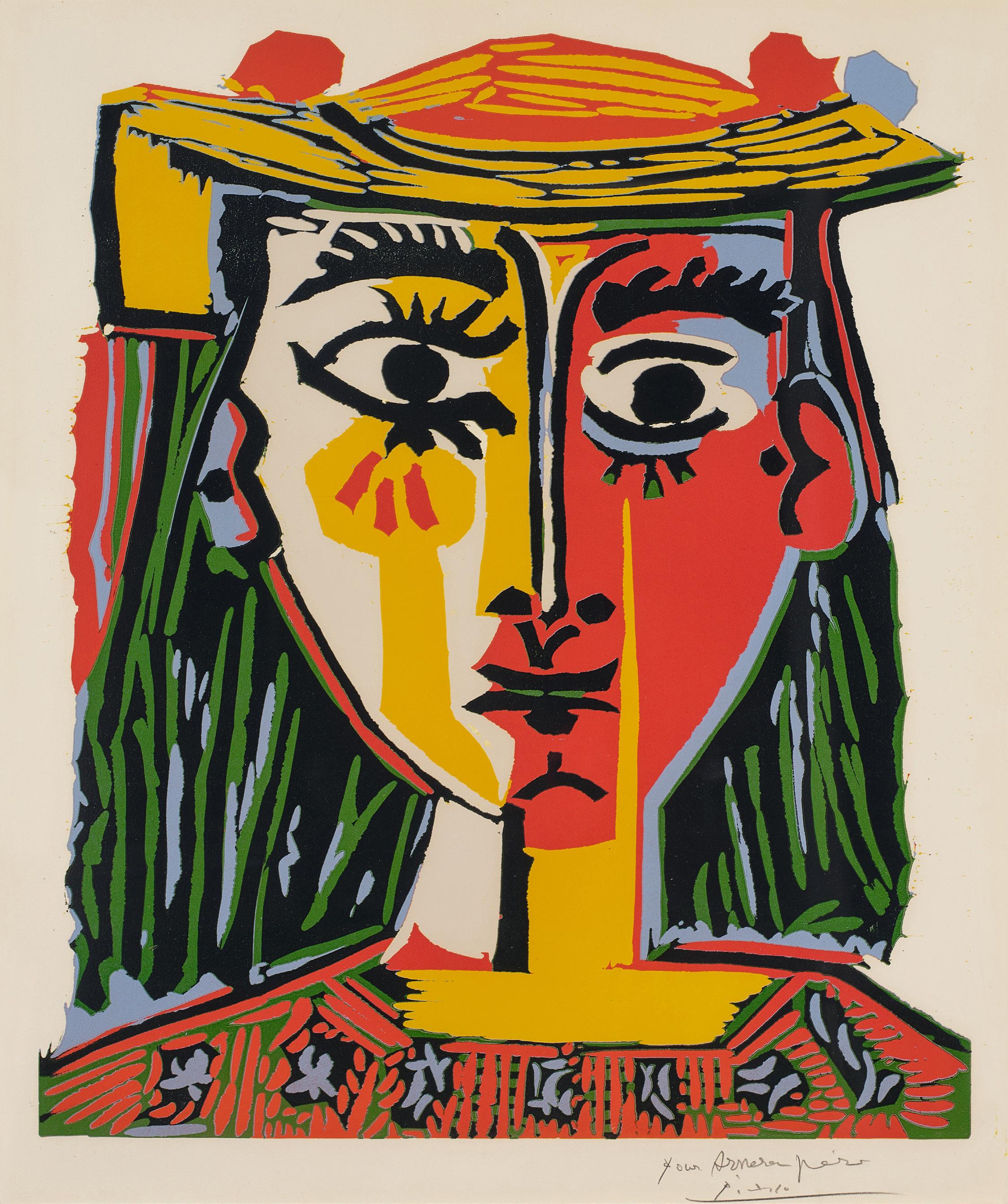
Portrait de Jacqueline au Chapeau de Paille, 1962
Sheet size: 29 1/2 x 24 3/8 inches
(57.2 x 61.9 centimeters)
Printer: Imprimerie Arnéra, Vallauris, France
Publisher: Galerie Louise Leiris, Paris
Edition size: 50, plus proofs
Catalogue Raisonné: Bloch 1067, Baer 1279 Signed
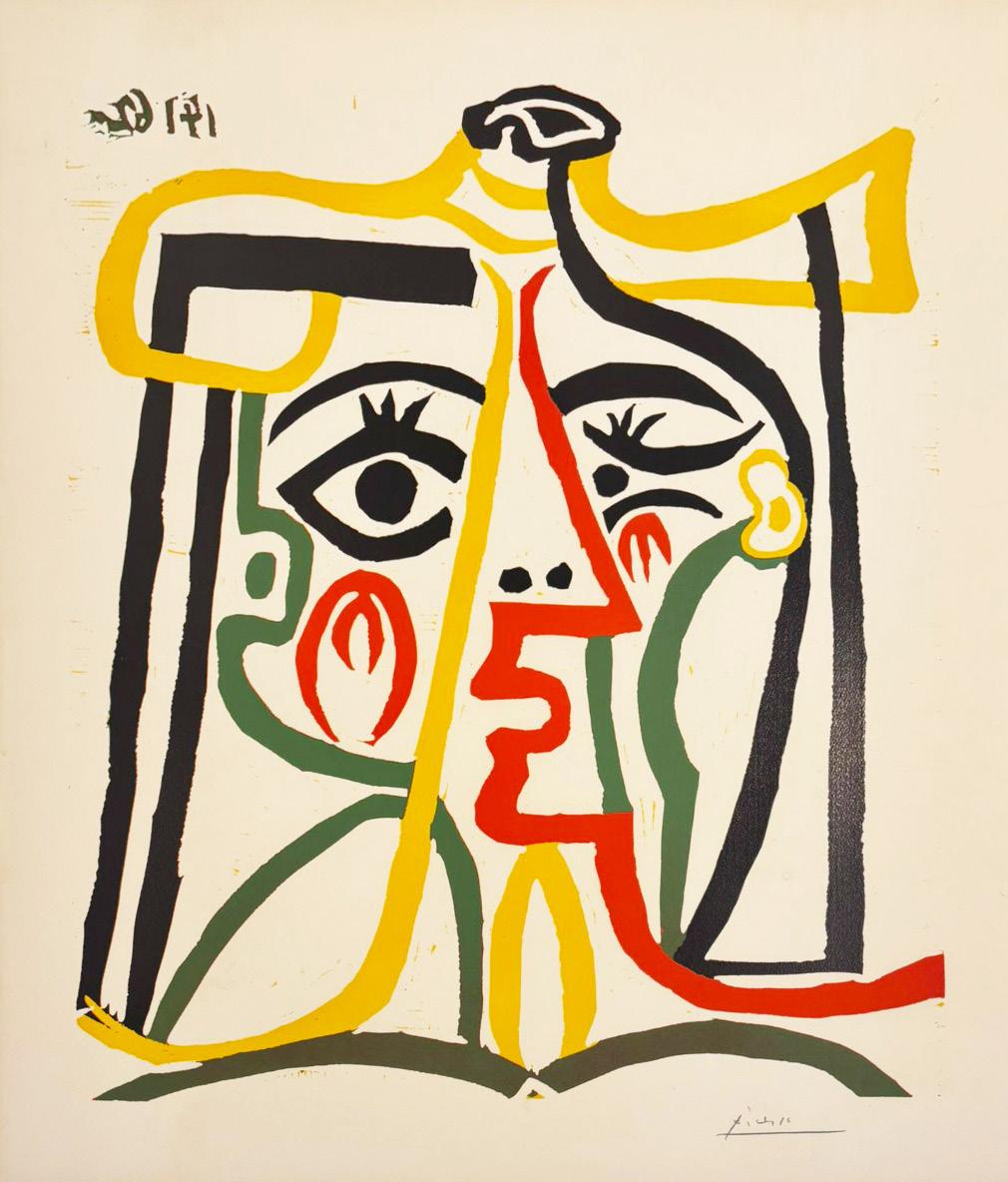
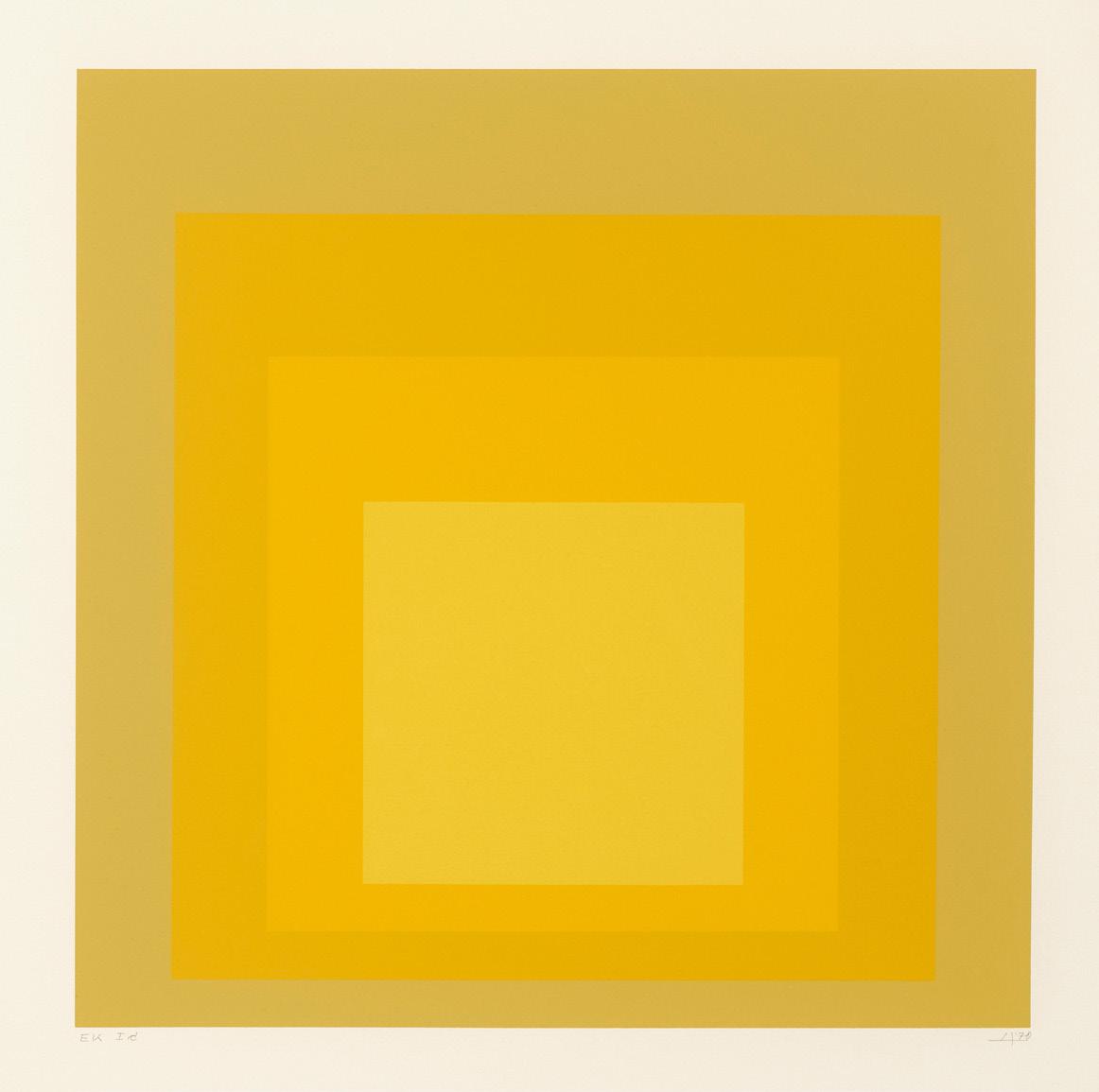
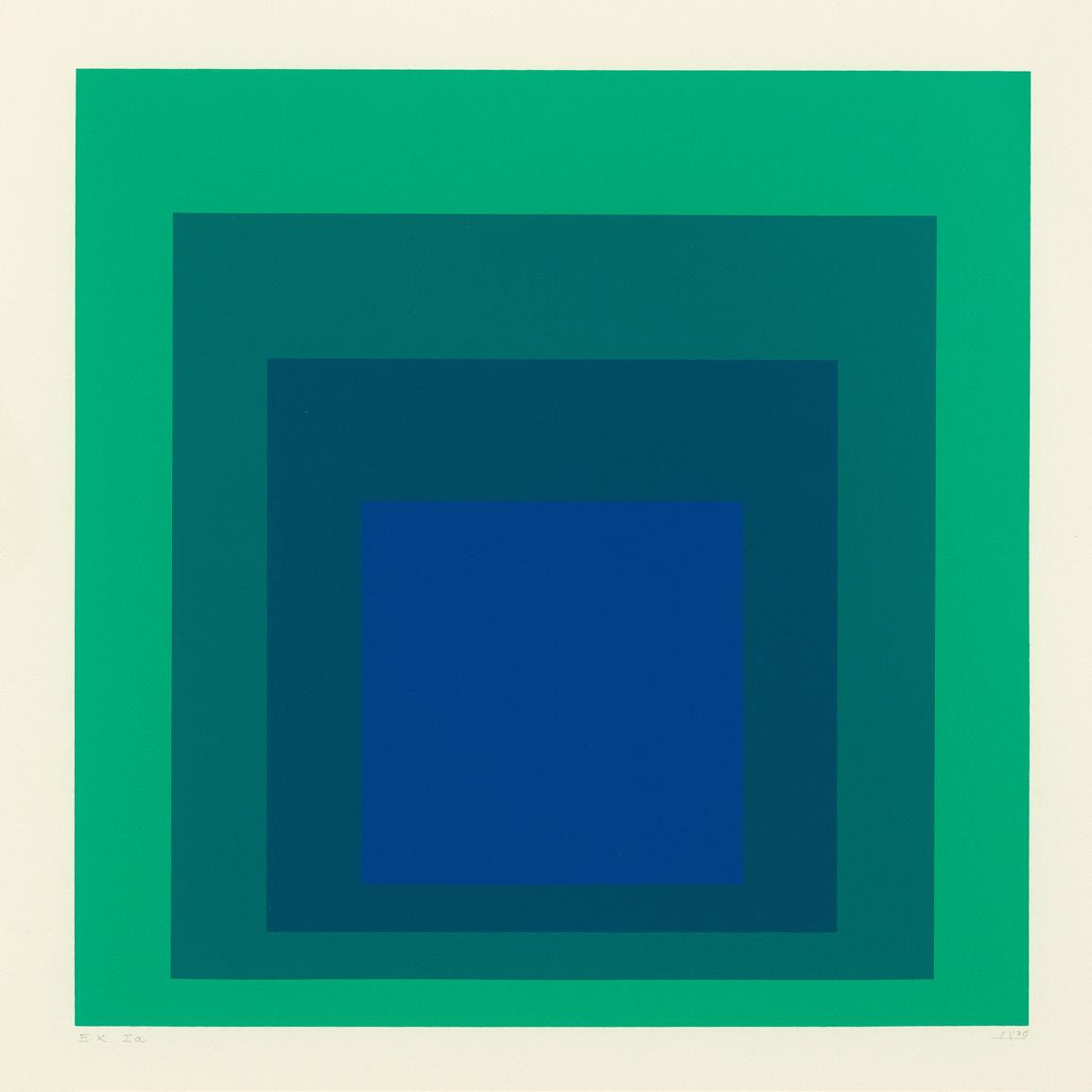
Albers
Homage to the Square: Edition Keller Ia-Ik, 1970
Screenprints
Sheet size: 21 5/8 x 21 5/8 inches, each (54.9 x 54.9 centimeters, each)
Printer: Herbert Geier, Ingolstadt, Germany
Publisher: Josef Keller Verlag, Starnberg, Germany
Edition size: 125
Catalogue Raisonné: Danilowitz 203.1-203.10
Each print is initialed, dated, numbered, and titled sequentially ‘EK la’ through ‘EK Ik’
The rare complete portfolio of ten screenprints that retains its original black linen-covered portfolio box, colophon, and interleaving sheets.
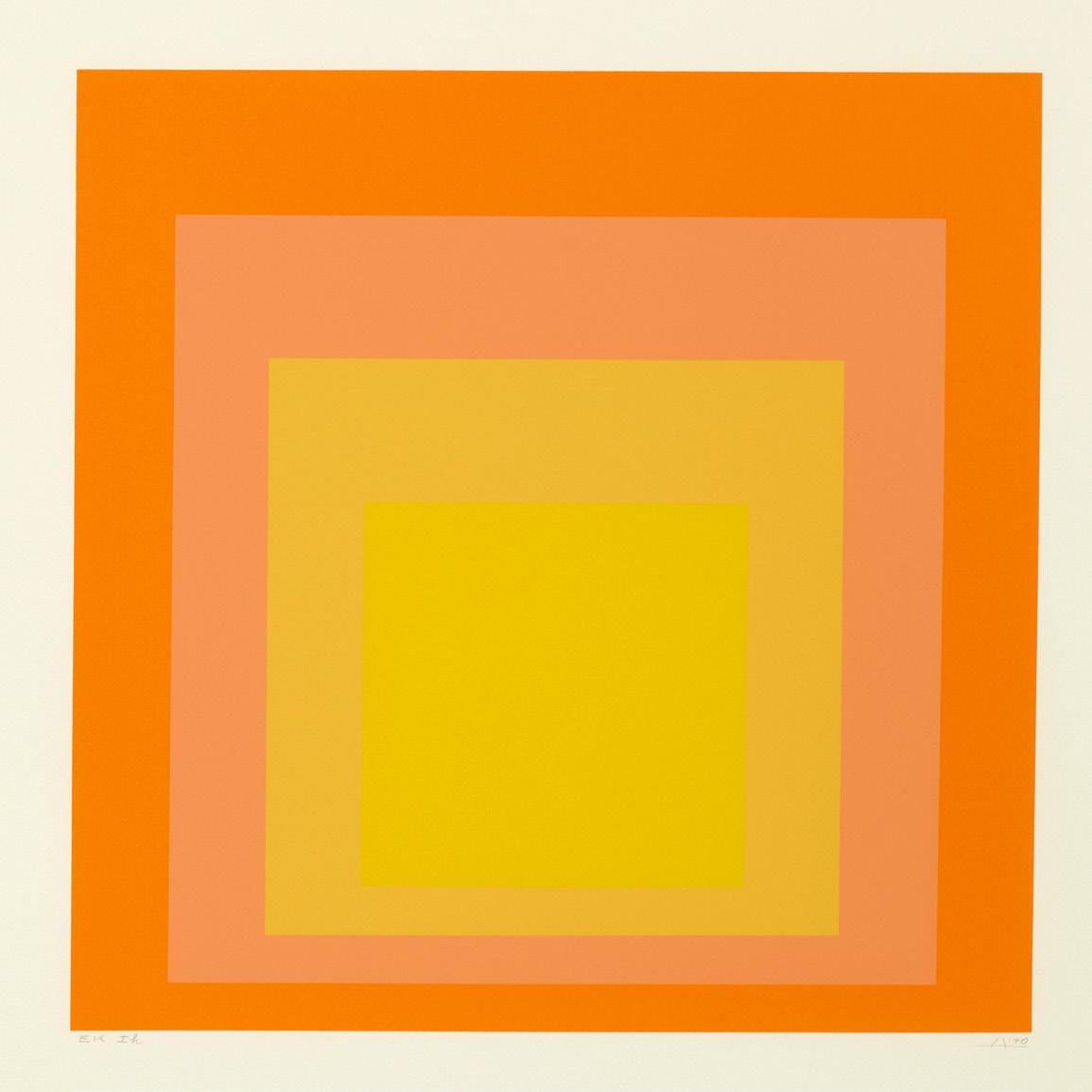
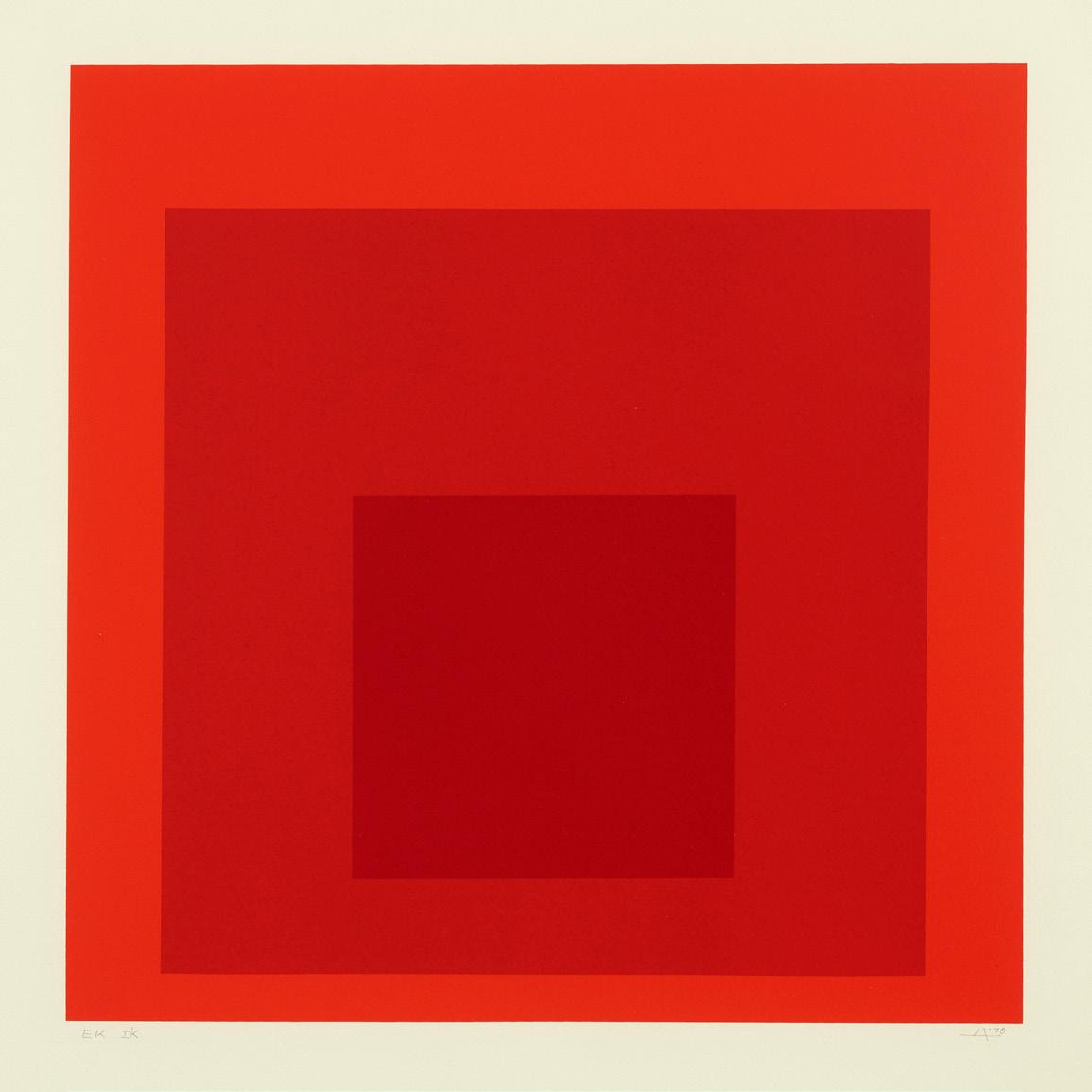
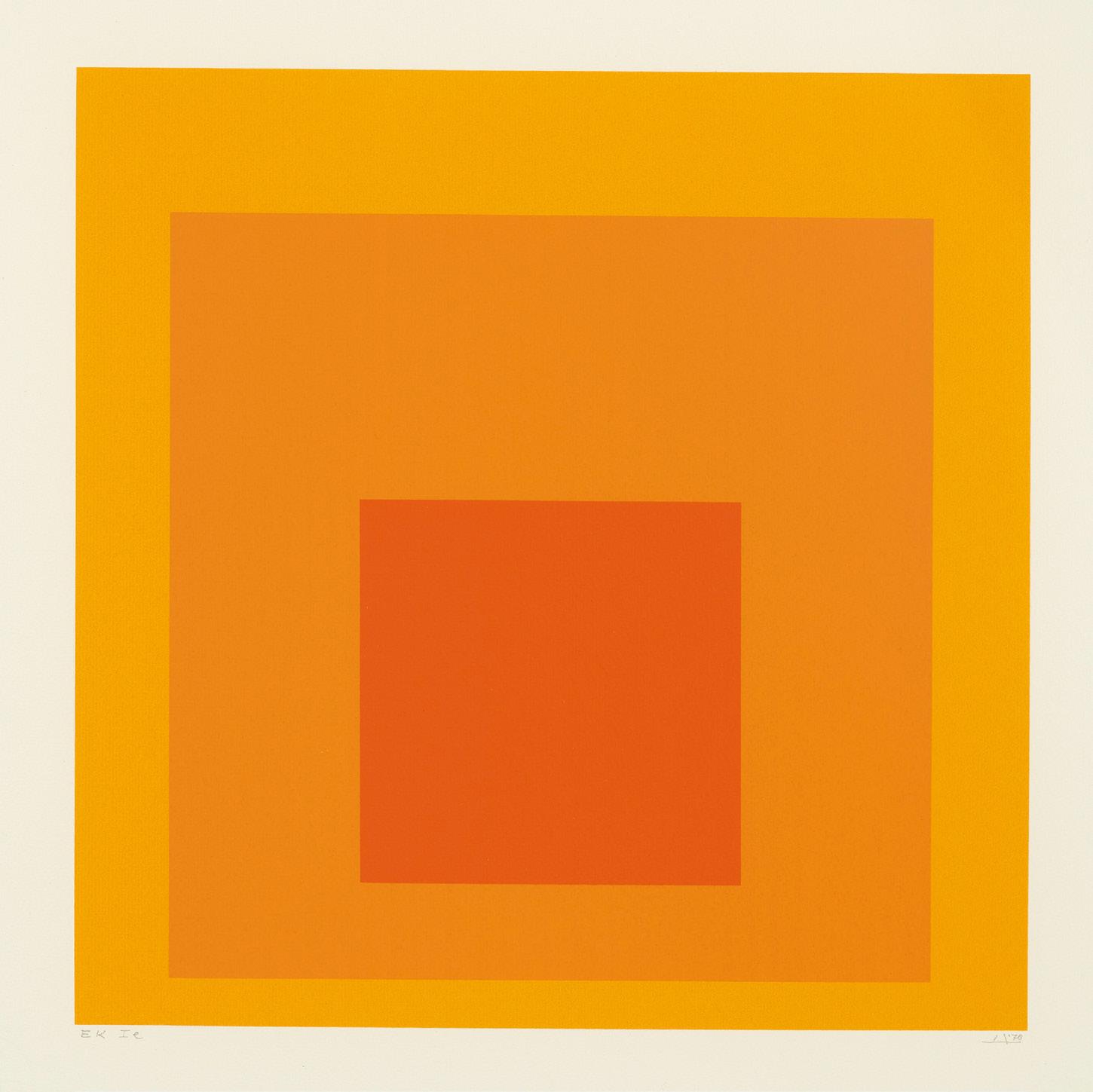

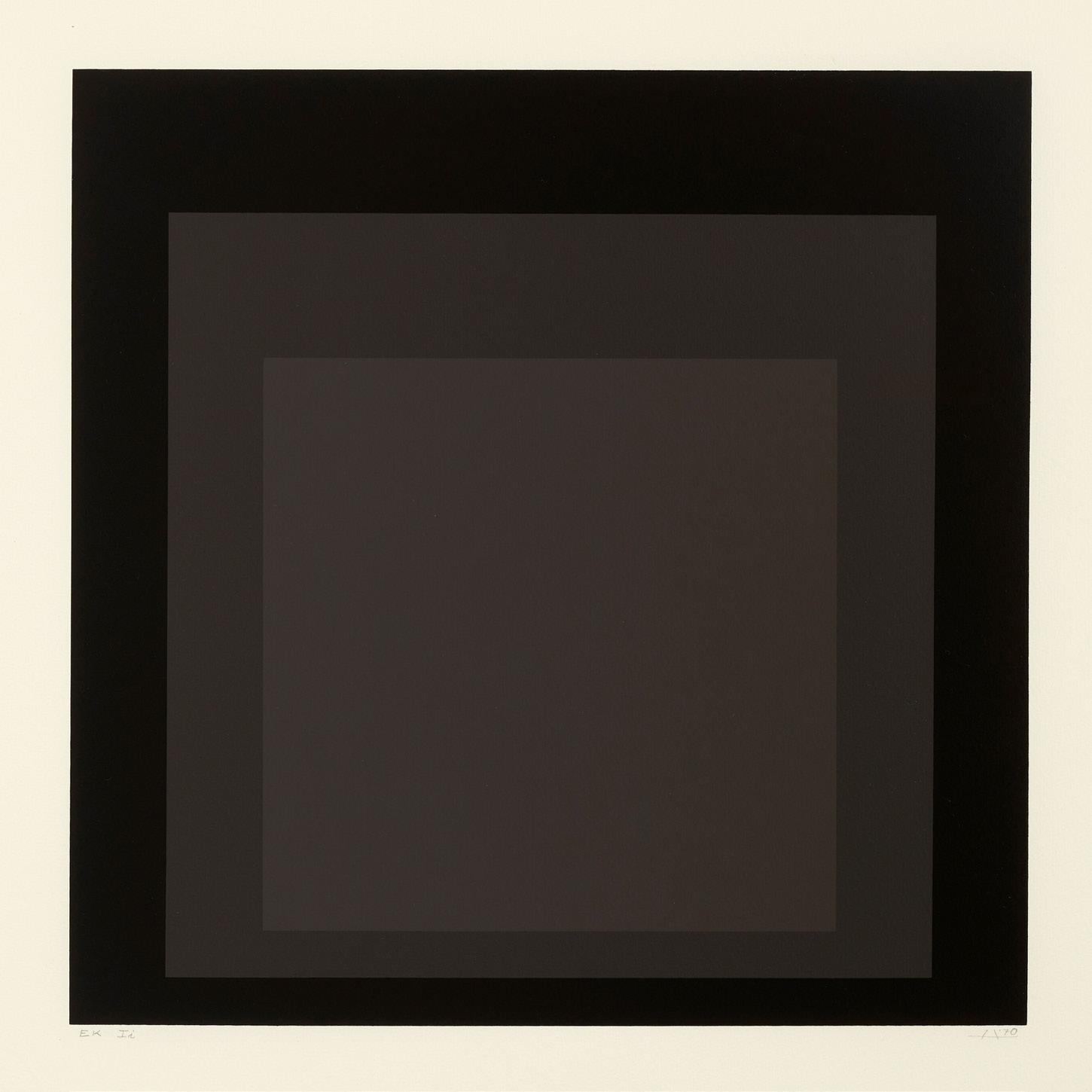
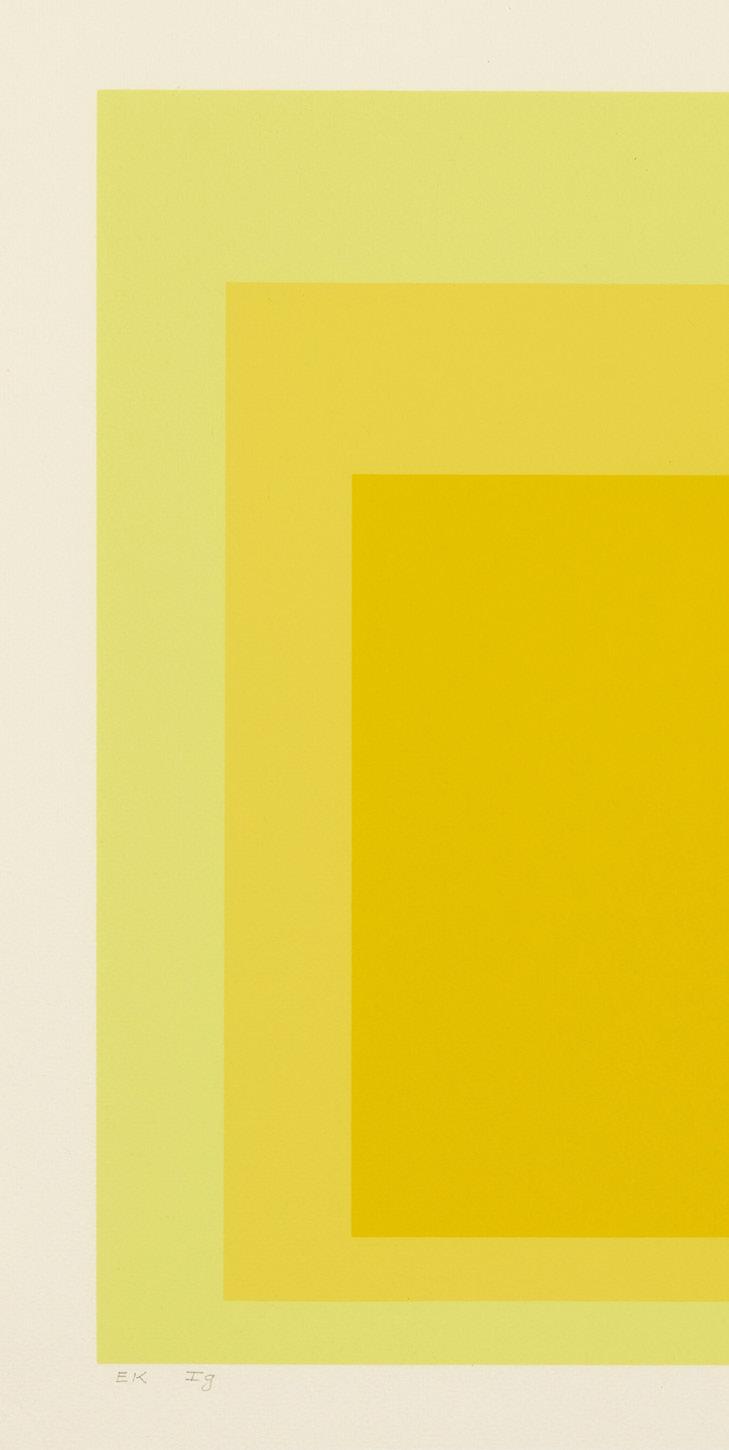
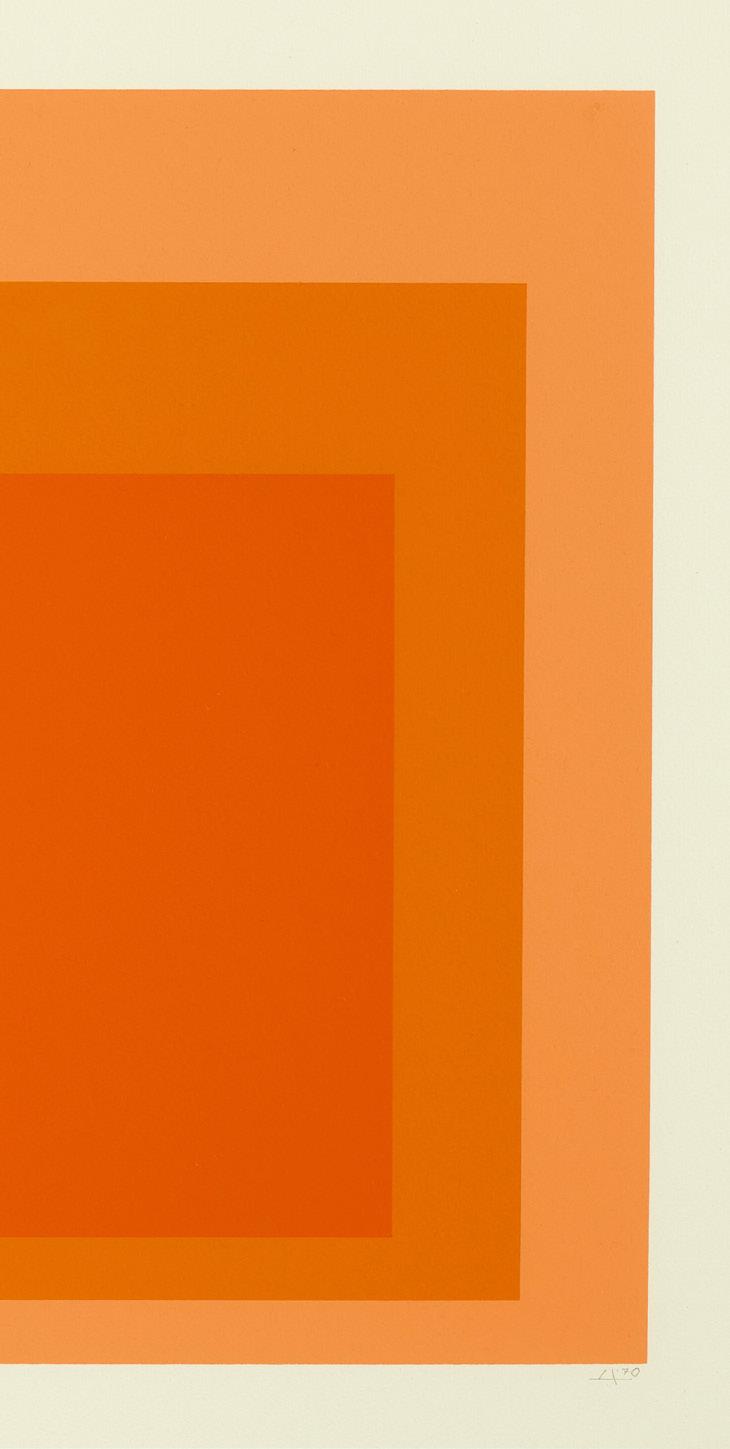
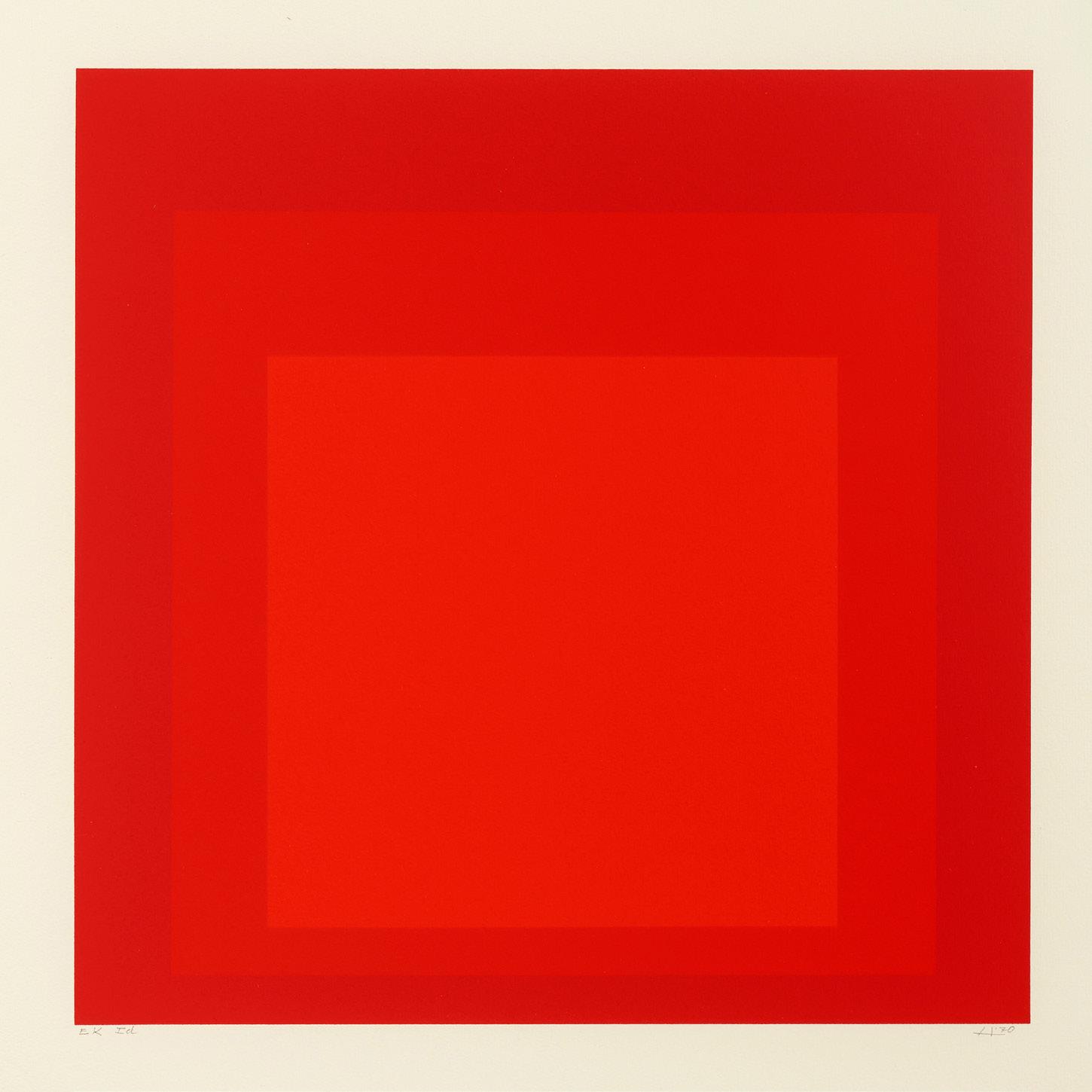
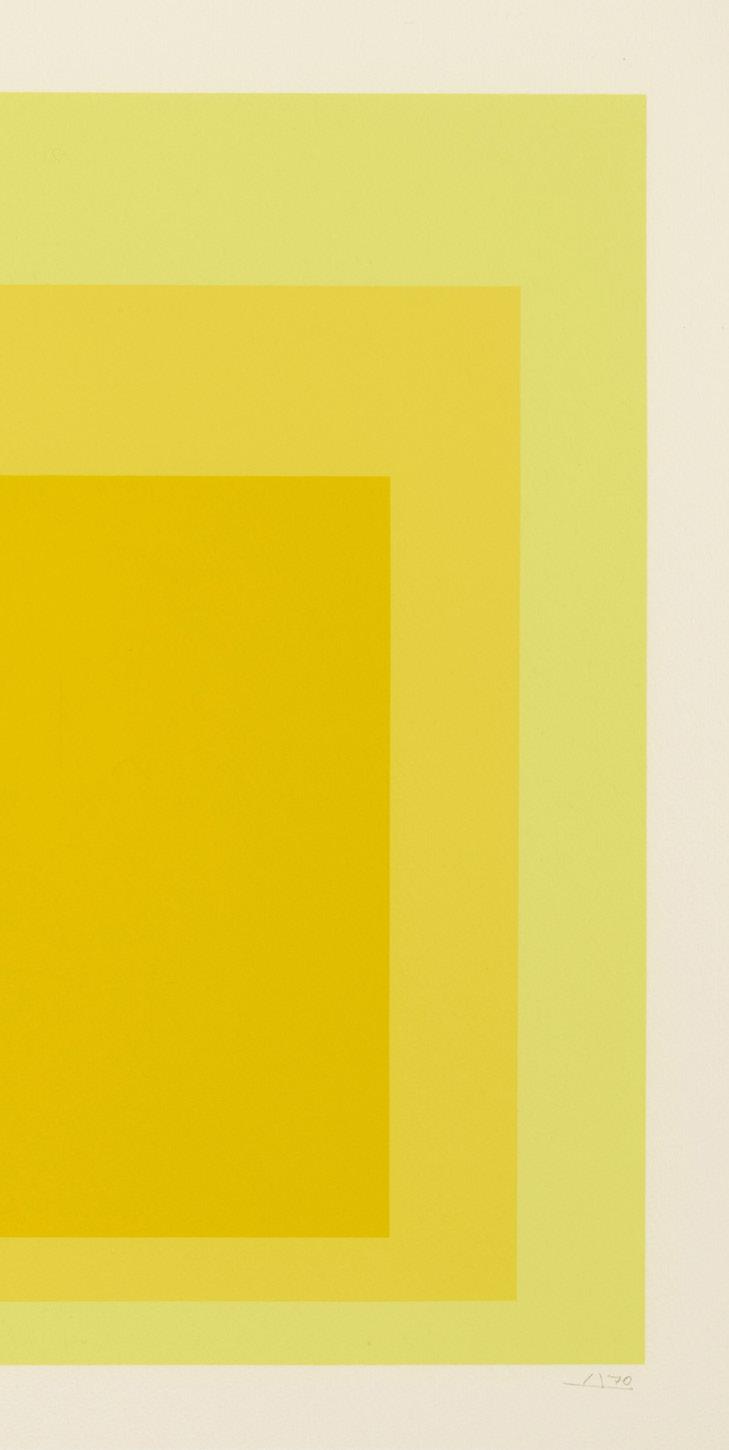
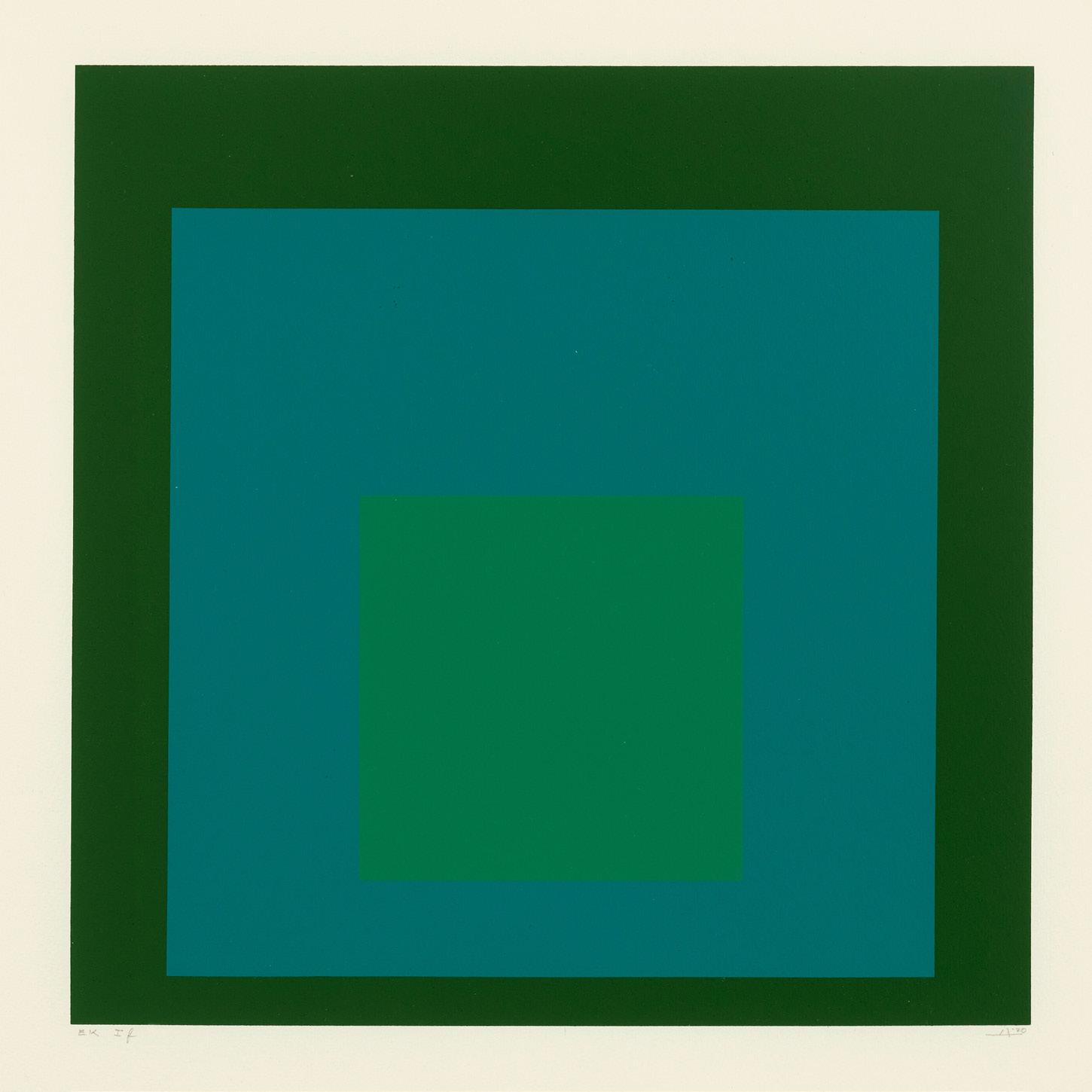
David Hockney

Lithographic Water Made of Lines, Crayon, and a Blue Wash, 1978-80
Lithograph
Sheet size: 29 x 33 7/8 inches (73.7 x 86 centimeters)
Printer and Publisher: Tyler Graphics Ltd., Bedford, New York
Edition size: 48, plus proofs
Catalogue Raisonné: MCAT 212
Signed, dated, and numbered
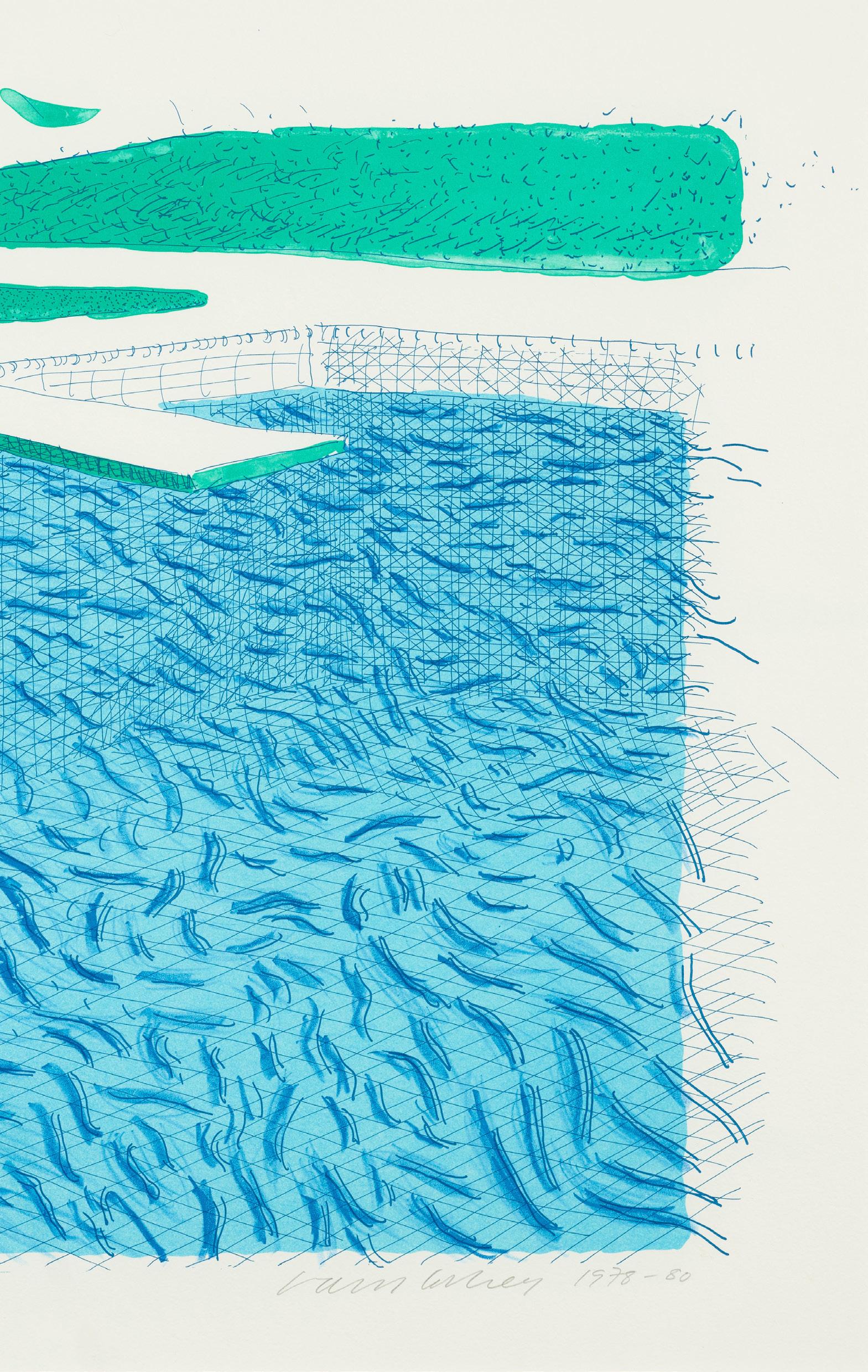
Flag I, 1960
Lithograph
Sheet size: 22 x 30 inches
(55.9 x 76.2 centimeters)
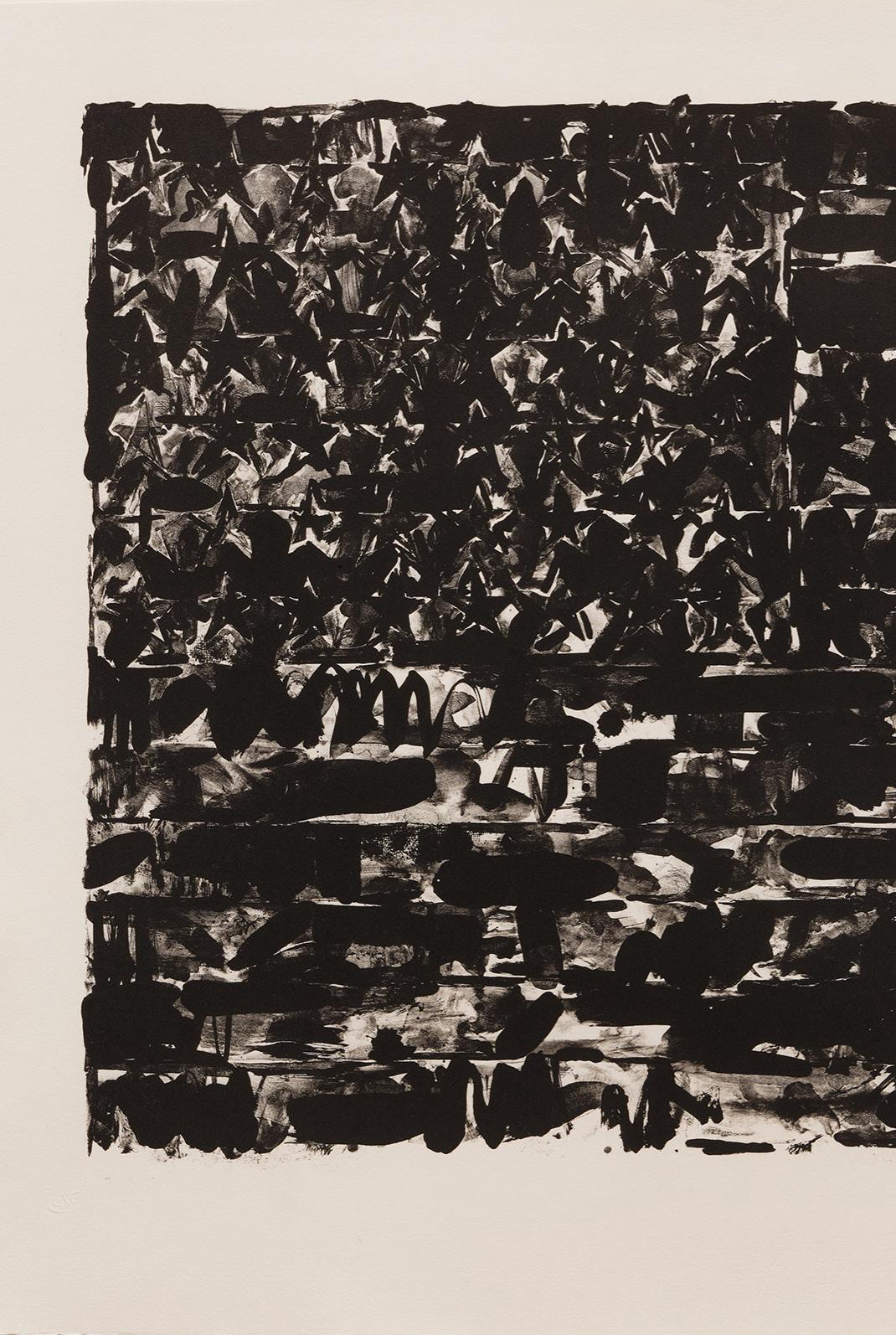
Printer and Publisher: ULAE, West Islip, New York
Edition size: 23, plus proofs
Catalogue Raisonné: ULAE 4
Signed, dated, and numbered
Provenance:
David Whitney, New York
David Whitney (1939-2005) was an American curator and collector. The long-time partner of renowned architect Philip Johnson, Whitney established close friendships with leading artists including Jasper Johns. He organized several important exhibitions at the Whitney Museum of American Art featuring the artist’s work.
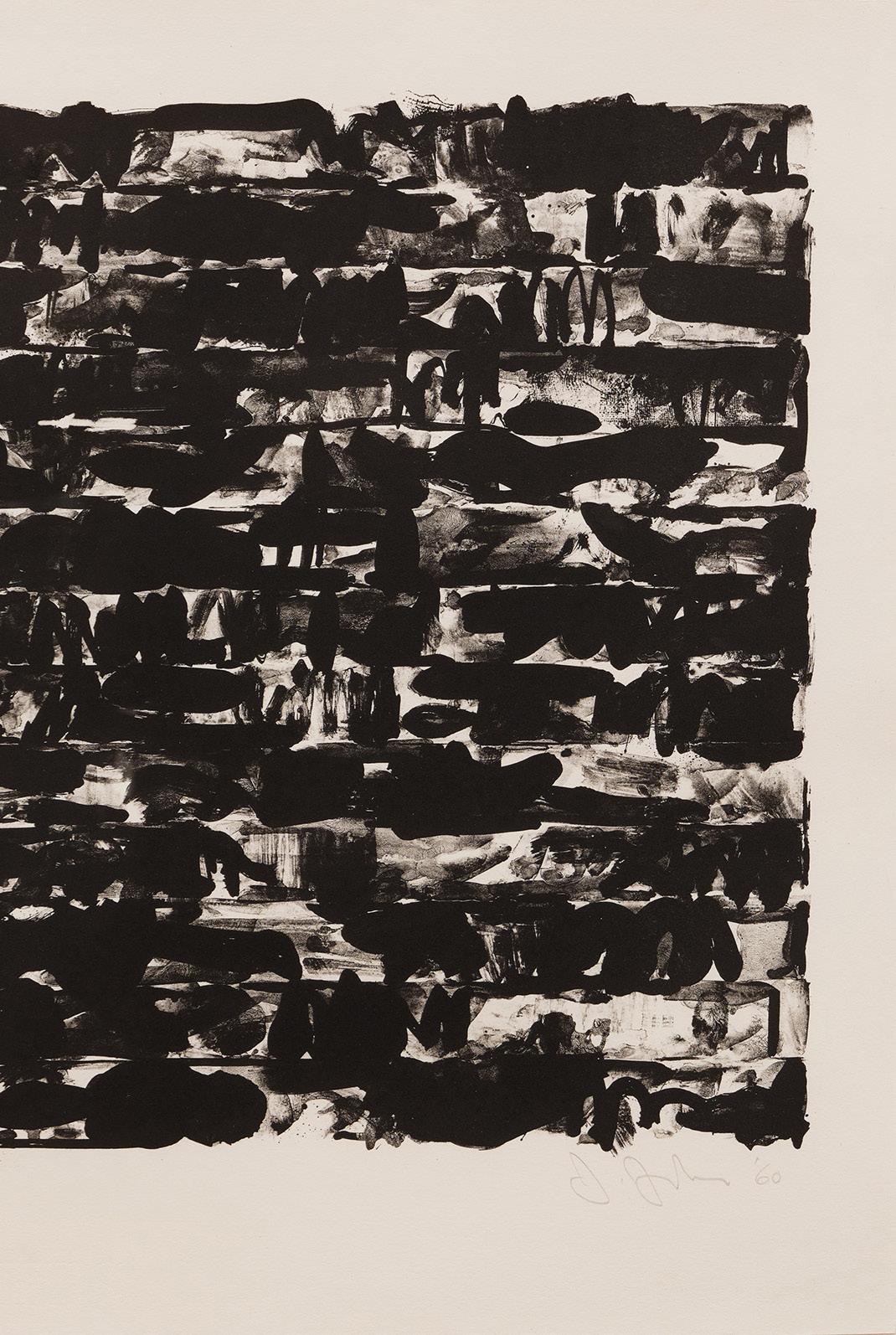

Robert Rauschenberg’s Booster and Joseph Beuys’s La Rivoluzione siamo Noi engage the personal and the political through life-sized self-portraits. For Rauschenberg, politics had long been integral to his visual language. He achieved international acclaim with works such as Buffalo II, presented at the 1964 Venice Biennale, which features an assemblage of iconic images of American identity including John F. Kennedy, space travel, and a bald eagle. Prior to Booster, however, Rauschenberg resisted biographical interpretations of his work.
This changed in February 1967, when Rauschenberg arrived at Gemini G.E.L. and announced his intention to “create a self-portrait of an inner man.” The timing was not incidental. The previous years had been marked by difficulties in both his career and personal life. Despite the solidification of his status as one of the leading artists of his generation, Rauschenberg faced lukewarm gallery sales, struggles with substance abuse, and a breakup with his partner. Leo Castelli encouraged Rauschenberg to work with the experimental printer Kenneth Tyler, in hopes that the collaborative nature of the process would reinvigorate the artist’s creativity.
The project began with a complete X-ray of Rauschenberg’s body. Taken in six segments (X-ray machines were then limited to one-foot images), the process literalized his desire to self-examine. Additional elements include an astrological chart for 1967, silkscreened over the lithograph, and imagery of athletes, power drills, car crashes, and a solitary chair, which Rauschenberg transferred through photolithographic plates.
Situated in the context of postwar “big science,” a period marked by unprecedented government investment in scientific research, Booster reads as an inquiry into humanity’s evolving relationship with technology. In the context of concurrent NASA Apollo missions, the title is often interpreted as a reference to a rocket booster; through the lens of the X-ray machine, Rauschenberg’s body becomes data to be analyzed. Yet personal references abound: the astrological chart reflects Rauschenberg’s reliance on an astrologer for life advice— one such piece of which prompted his move to Captiva Island, Florida, in 1970—while the chair may allude to his former partner Steve Paxton, a dancer who used a similar prop in performance.
As Gemini G.E.L. co-founder Sidney Felson recalled, Rauschenberg “was always recording the feelings of the moment.” In Booster, that moment is both historic and intimate—a self-portrait shaped by personal crisis as much as by the outward forces impressing upon postwar American culture.
For Joseph Beuys, the circumstances were reversed. The artist’s work had long drawn from a self-stylized mythology of his personal history. Beuys joined the Luftwaffe as a gunner during World War II, stationed in Crimea and the Balkans. In March of 1944, his plane crashed along the frozen steppes of the Russian front. According to the artist, he was rescued by a group of nomadic Tartar tribesmen who wrapped his semi-conscious body in felt and animal fat to keep him warm as he healed. Although this epic tale has never been verified, fat and felt became central to Beuys’s identity and were recurring materials in his work.
Though always philosophically charged, Beuys’s work became increasingly political as his career progressed. He engaged with materialist critiques of capitalism and came to view art as a vehicle for sociopolitical change, coining the term “social sculpture” to describe art that spurred political action and organization.
Beuys first began creating multiples in the mid-1960s, and they soon became integral to his practice. The artist produced more than 500 editioned objects and prints throughout his career. For Beuys, these works were politically charged—he considered each to be an “antenna” capable of reaching a broader audience than a sculpture, performance, or lecture. A single edition might be the catalyst for change, as it possessed, in the artist’s own words, “the character of a kernel of condensation upon which many things may accumulate.”
The photograph featured in La Rivoluzione siamo Noi (We Are the Revolution) was originally used as a poster for an exhibition of Beuys’s work at Lucio Amelio Gallery in Naples in 1971. The artist presents himself mid-stride, his posture strong and upright with his gaze directed squarely at the viewer. The translation of the title and the composition of the image embody Beuys’s politically oriented practice, challenging the viewer to press forward in the fight for change.
Beuys co-founded the German Green Party, which integrated politics with environmentalism, and the Free International University, which rejected traditional educational frameworks that conflicted with the artist’s democratic ideals for learning and teaching spaces. As a professor at the Kunstakademie Düsseldorf in the 1960s and early 1970s, Beuys grew increasingly frustrated by the institution’s restrictions on his teaching methods. He intentionally overenrolled his classes with students who had been rejected and organized an occupation of the administrative offices. These actions led to his dismissal from the academy, an event that only intensified his political convictions.
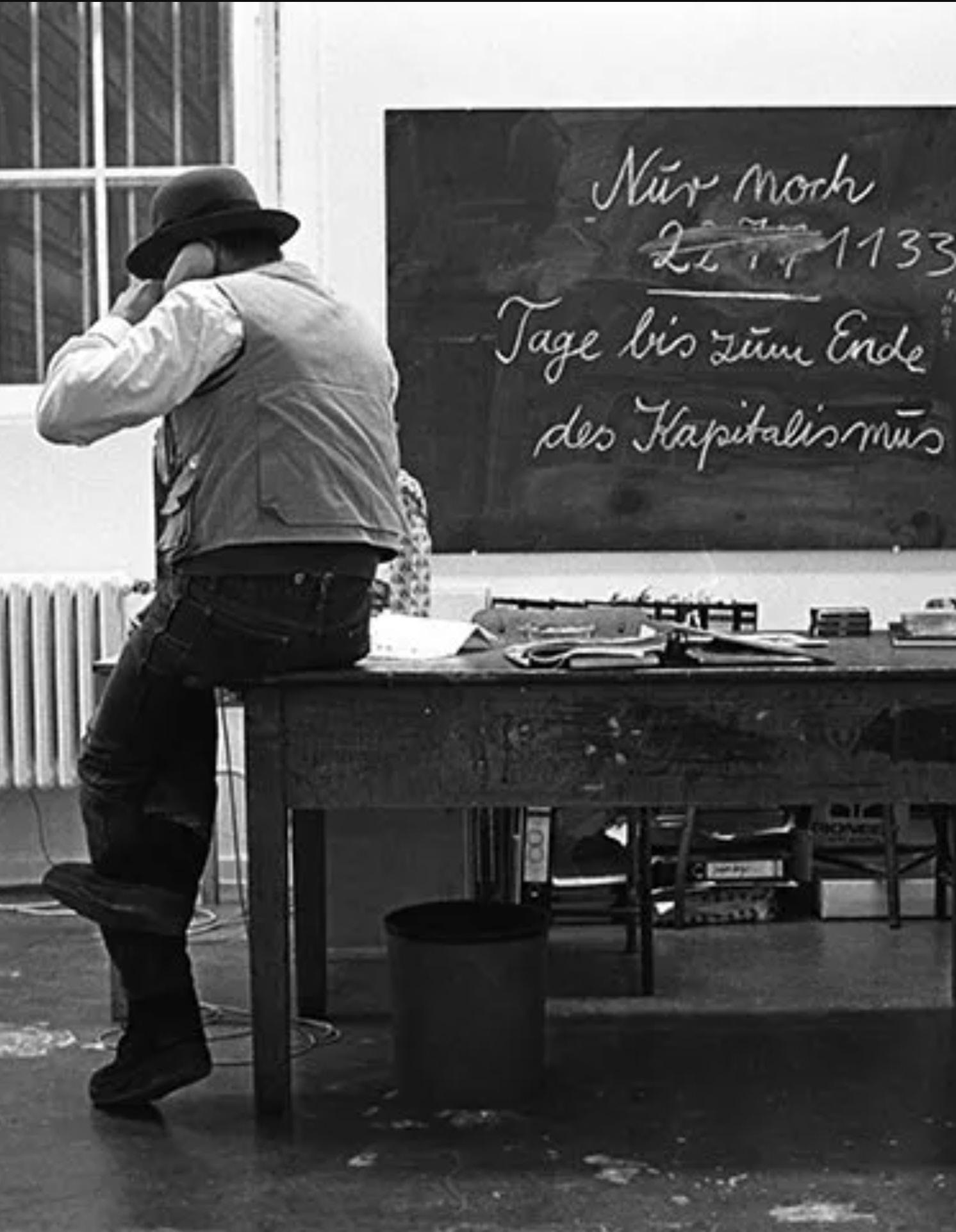
Robert Rauschenberg
Booster, 1967
Lithograph with screenprint
Sheet size: 71 3/4 x 35 1/2 inches (182.3 x 90.2 centimeters)
Printer and Publisher: Gemini G.E.L., Los Angeles
Edition size: 38, plus proofs
Catalogue Raisonné: Gemini 41.9
Signed, dated, and numbered
Other known impressions of this rare print can be found in the collections of The Museum of Modern Art, New York, the National Academy of Design, New York, the Buffalo AKG Art Museum, the Philadelphia Museum of Art, the National Gallery of Art, Washington D.C., the Los Angeles County Museum of Art, the Fine Arts Museum (De Young), San Francisco, The British Museum, and the National Gallery of Australia.
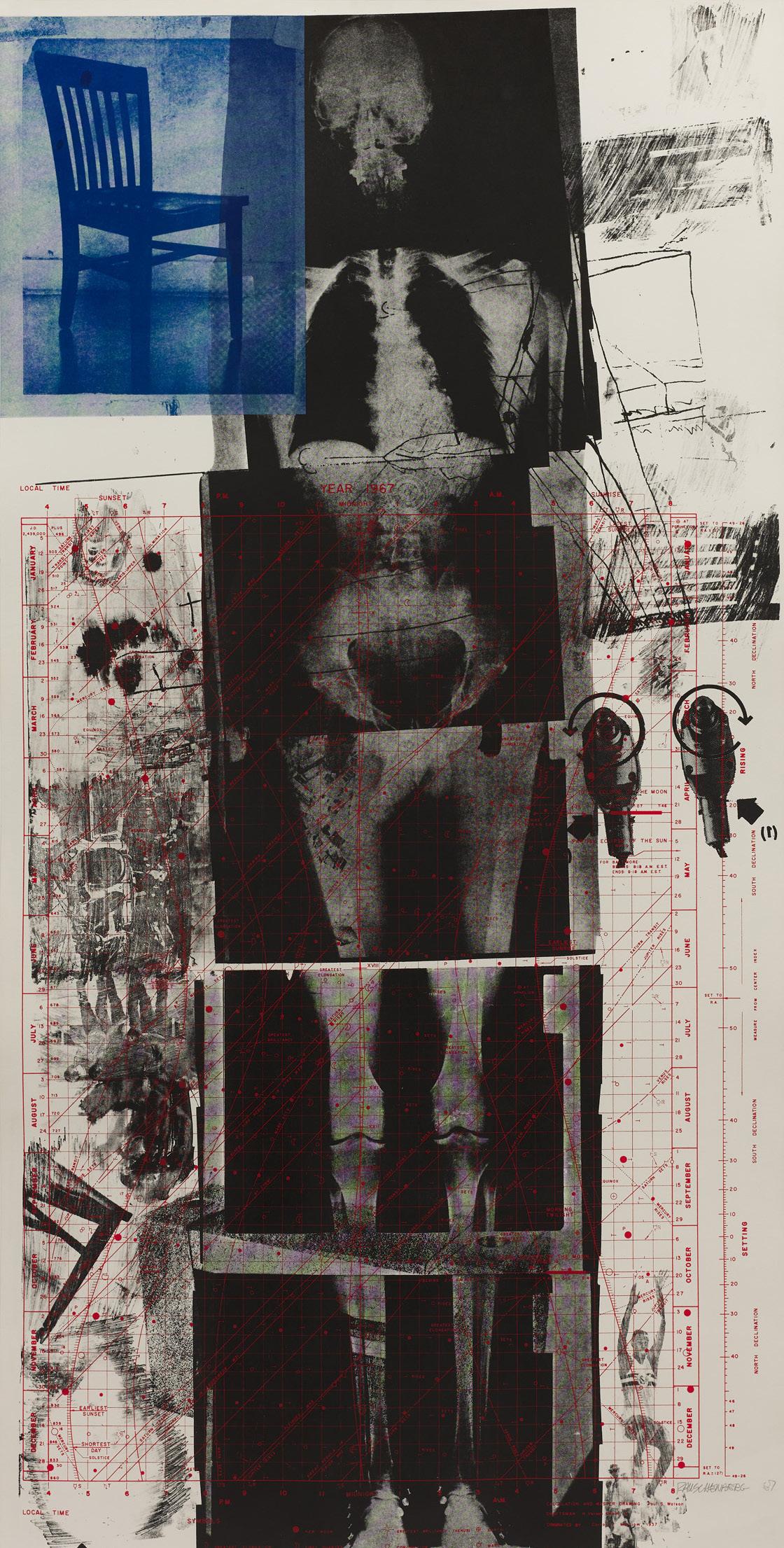
Joseph Beuys
La rivoluzione siamo Noi, 1972
Silkscreen with handwritten text
Sheet size: 75 3/8 x 39 5/8 inches (191.5 x 100.7 centimeters)
Publisher: Edition Staeck, Heidelberg and Edizioni Lucio Amelio, Naples
Edition size: 180, plus proofs
Catalogue Raisonné: Schellmann 47
Signed, titled, numbered, and stamped Hauptstrom (Mainstream)
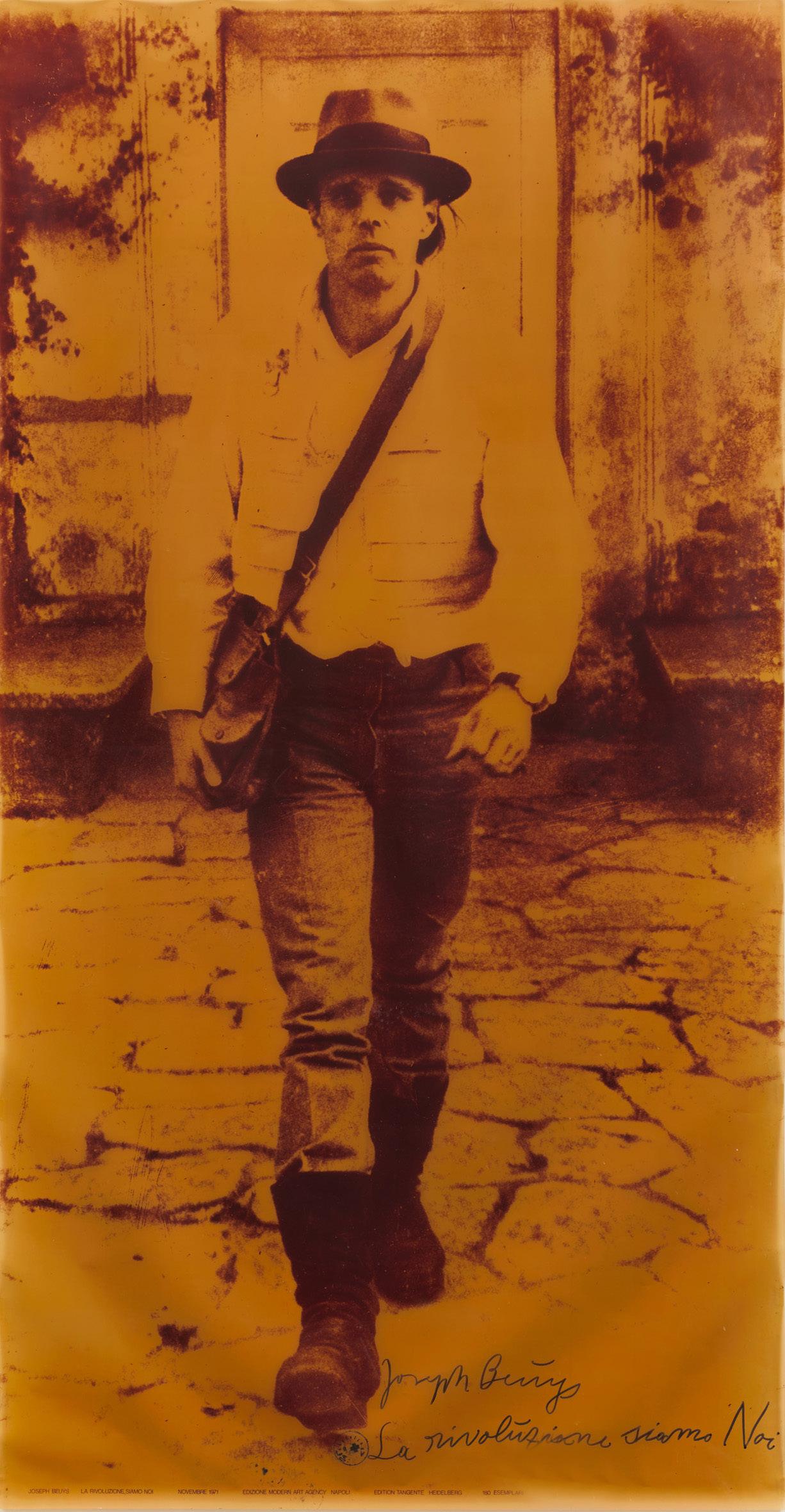
Litho #1 (Waves #1), 1960
Lithograph
Sheet size: 45 3/4 x 31 3/4 inches (116.2 x 80.6 centimeters)
Printer: Nathan Oliviera and George Miyasaki, University of California, Berkeley
Edition size: Approximately 8
Catalogue Raisonné: Graham 2
Signed and dated
Provenance:
The Artist
By descent to a family member of the artist
Exceedingly rare. Other known impressions of this print can be found in the collections of the Yale University Art Gallery, the Museum of Fine Arts, Boston, the Fine Arts Museums of San Francisco, Legion of Honor, and the Staatliche Museen zu Berlin (Kupferstichkabinett).
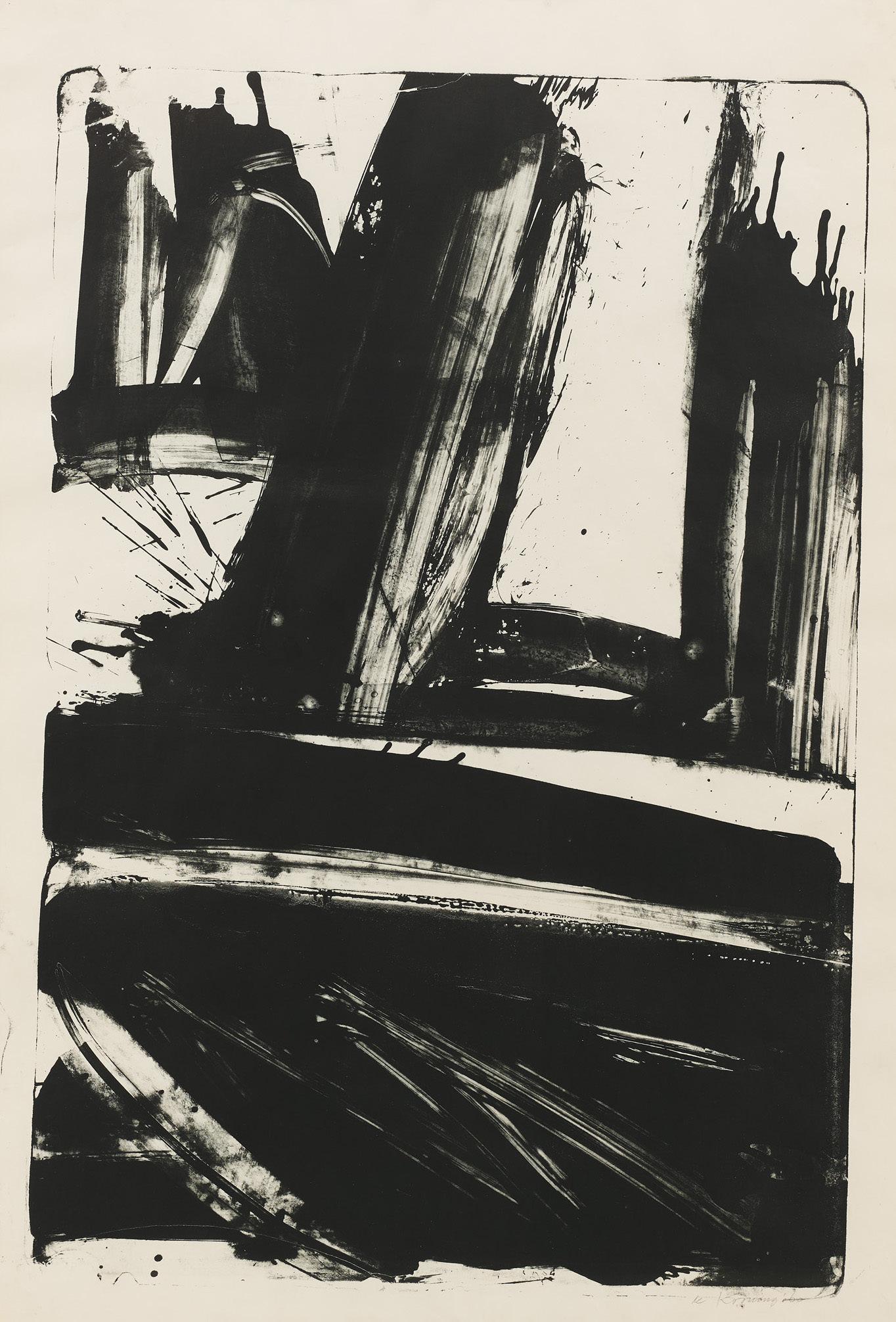
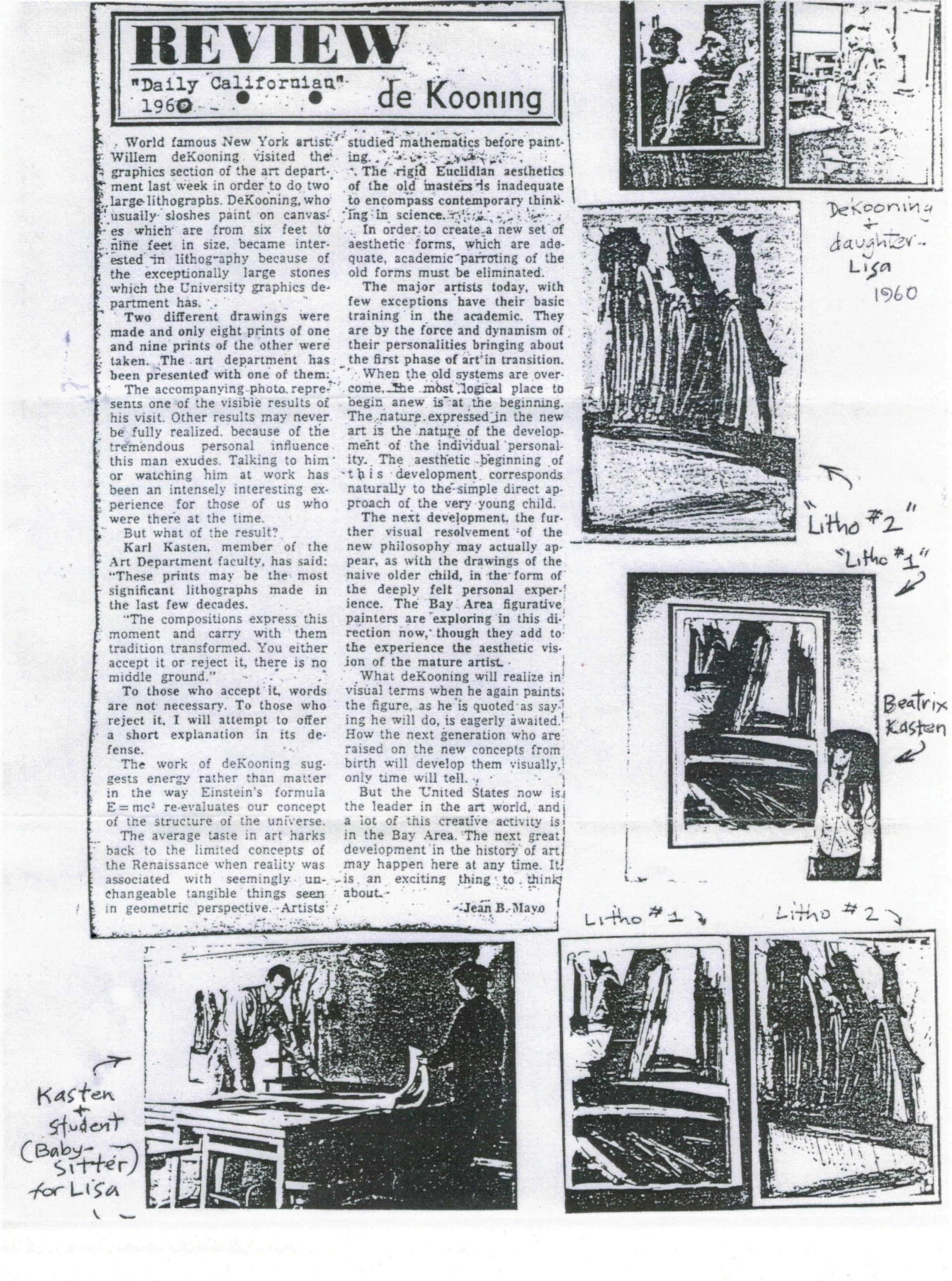

Jasper Johns
Cicada, 1979
Screenprint
Sheet size: 22 x 18 1/8 inches (55.9 x 46 centimeters)
Printer: Simca Print Artists Inc., New York
Publisher: Jasper Johns and Simca Print Artists, Inc., New York
Edition size: 100, plus proofs
Catalogue Raisonné: ULAE 204
Signed, dated, and numbered
From the 1981 portfolio Marginalia: Hommage to Kusuo Shimizu, which also includes works by Christo & Jeanne-Claude, Sam Francis, Claes Oldenburg, and Jean Tinguely.

Roy Lichtenstein, “Masterpiece,” 1962, 1975
Acrylic and silkscreen ink on canvas
Size: 7 3/4 x 7 1/2 x 5/8 inches, overall (19.7 x 19.1 x 1.6 centimeters)
Signed, dated ‘1975’, and titled on the canvas overlap, verso The work retains its original hand-made wood frame
Richard Pettibone created a very small but unknown number of paintings with this image for a fundraiser at the The Institute of Contemporary Art, Philadelphia in 1975.
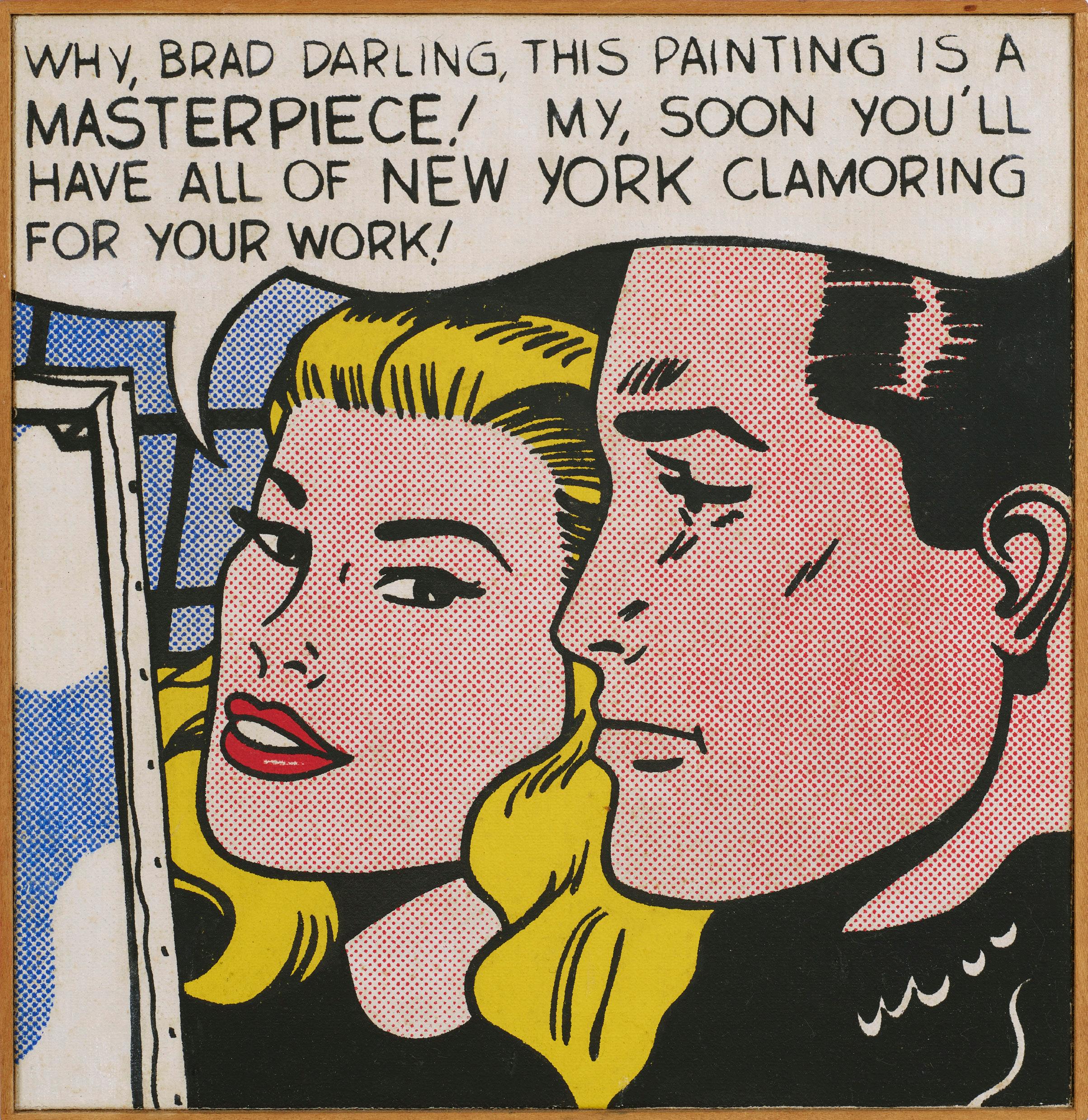
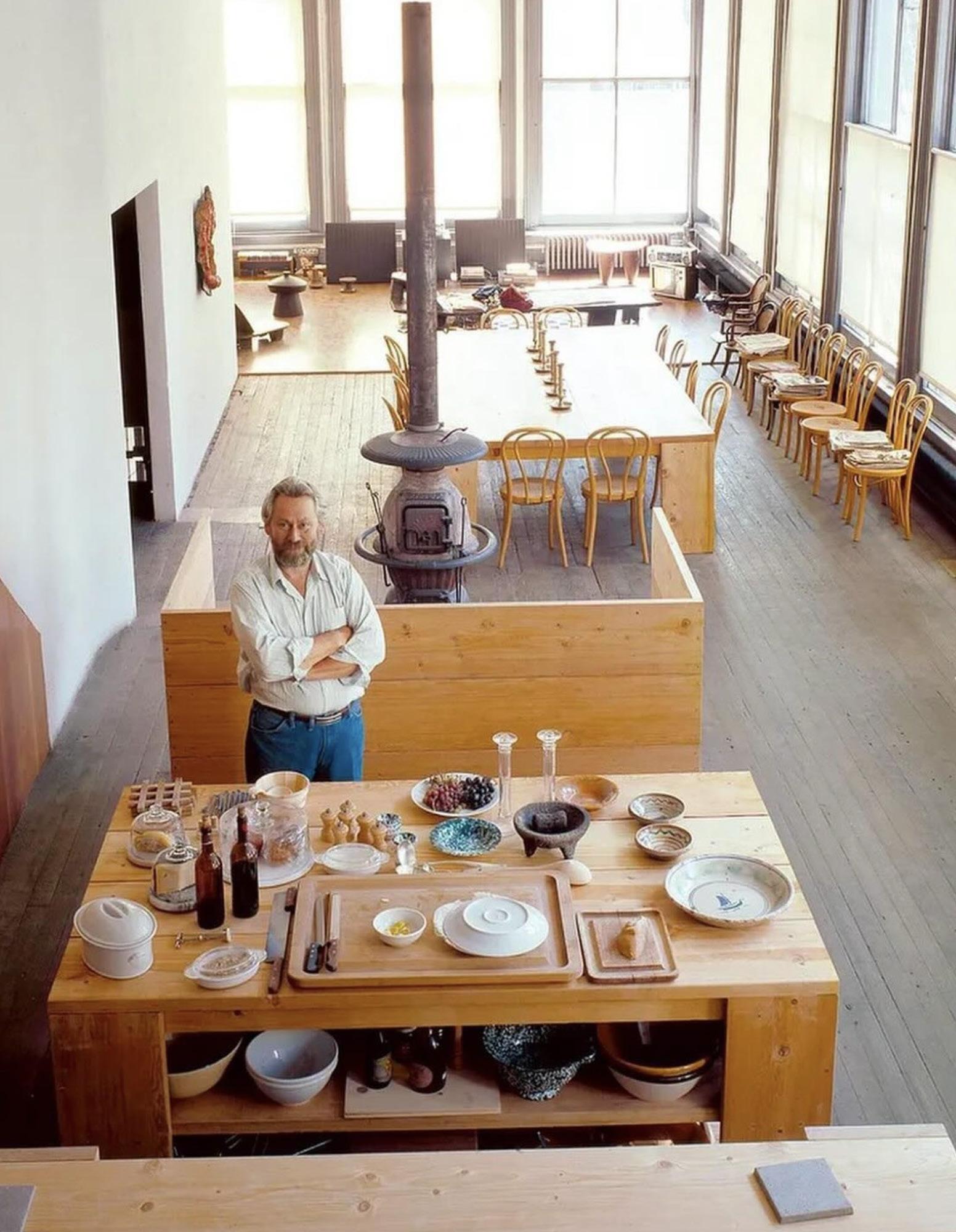
Donald Judd is best known for his three-dimensional works which emphasized materiality and physical presence over illusionistic or symbolic meaning. However, woodcut printmaking remained an integral part of his practice until his death in 1994, likely due to the medium’s direct nature: the printed image exists as evidence of the physical reality of the carved block.
Untitled, the complete set of three sugar pine woodblocks, occupies an ambiguous space between print and object. While recalling the functional blocks Judd employed to create his woodcut print series, these works were conceived exclusively as editioned objects. As in his contemporary woodcut prints of the 1990s, the divisions of space are rendered with exceptional crispness, exemplifying the artist’s commitment to manufactured precision.
The set is the only multiple that Judd made in wood. The blocks were fabricated by master woodworker Jim Cooper, with whom Judd had collaborated for many years—first as a carver of woodcut blocks and later in the design of Judd’s kitchen at his home and studio at 101 Spring Street in SoHo.
Judd relied on Cooper’s technical expertise to achieve uniformity across the three blocks: two painted, one in red and one blue, and one finished with a clear polyurethane varnish. Even in the varnished block, where the wood grain remains visible, the finish ensures a consistent tactile surface across the set. In this way, the focus becomes the work’s seriality. Judd’s vision is fully realized only when the blocks are displayed together in sequence, making clear that the sole variation lies in color.
Cooper’s exceptional craftsmanship in Untitled extends beyond the blocks themselves, as each was issued in a wooden storage box designed by the artist. Ingeniously simple in construction, the boxes employ sliding cleats to secure the artworks. Wall cleats were also specially designed, ensuring that the works hang flush against the wall and eliminating the need for hardware or supports that might compromise Judd’s aesthetic.

Donald Judd
Untitled, 1991
Woodblocks
Size: 14 3/8 x 19 5/8 x 2 inches, each
(36.5 x 49.9 x 5 centimeters, each)
Fabricator: Jim Cooper, New York
Publisher: Peder Bonnier, New York
Edition size: 20, plus proofs
Catalogue Raisonné: Schellmann 14-16
Each woodblock is signed ‘Judd’ by the artist, verso
Stamp-signed ‘JUDD,’ numbered, and dated, verso
The complete set of three woodblocks that retains its original three wooden boxes fabricated by Jim Cooper. Each box is stamped with the corresponding edition number.


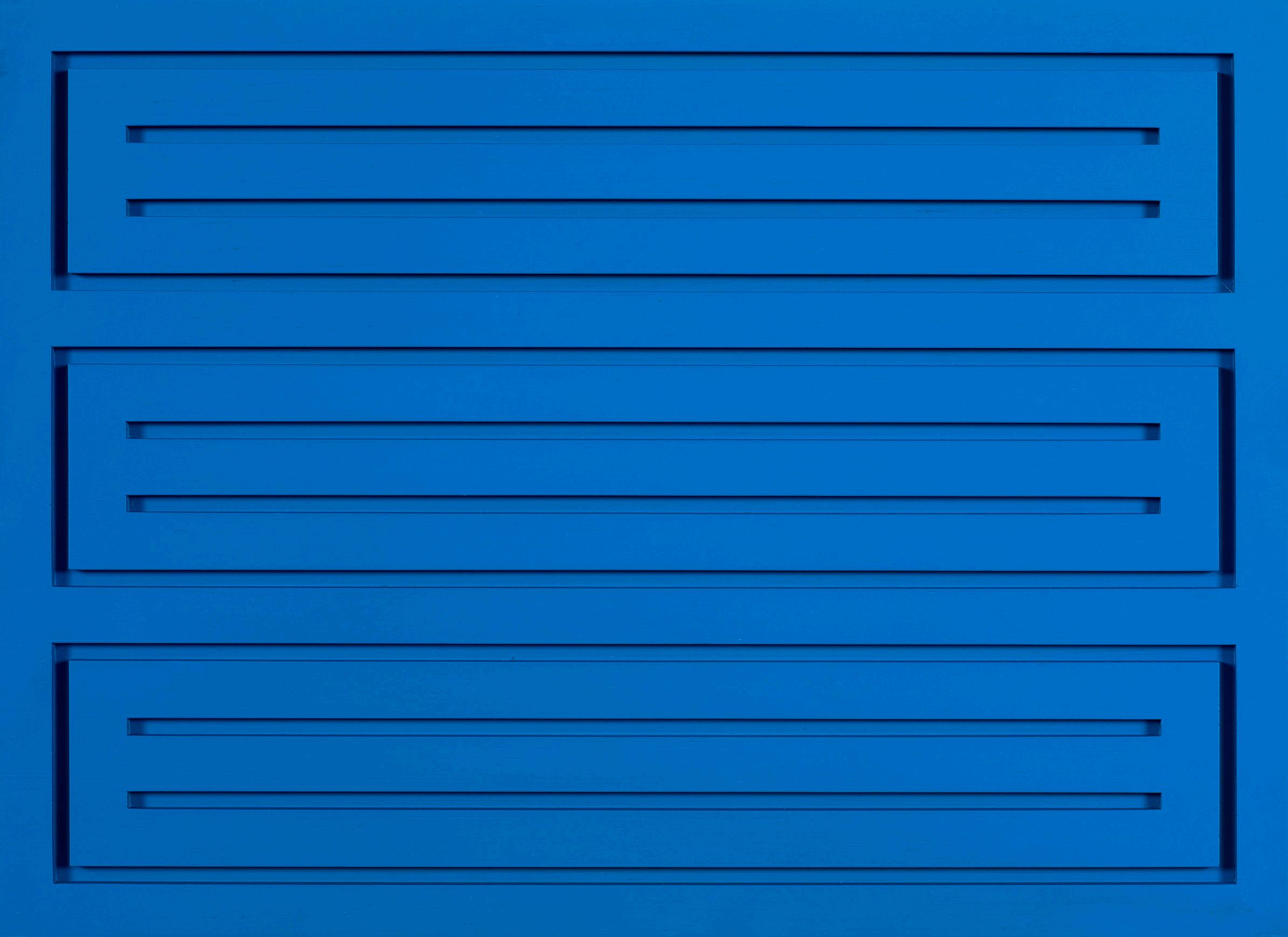
Donald Judd
Untitled, 1991-94
Woodcuts
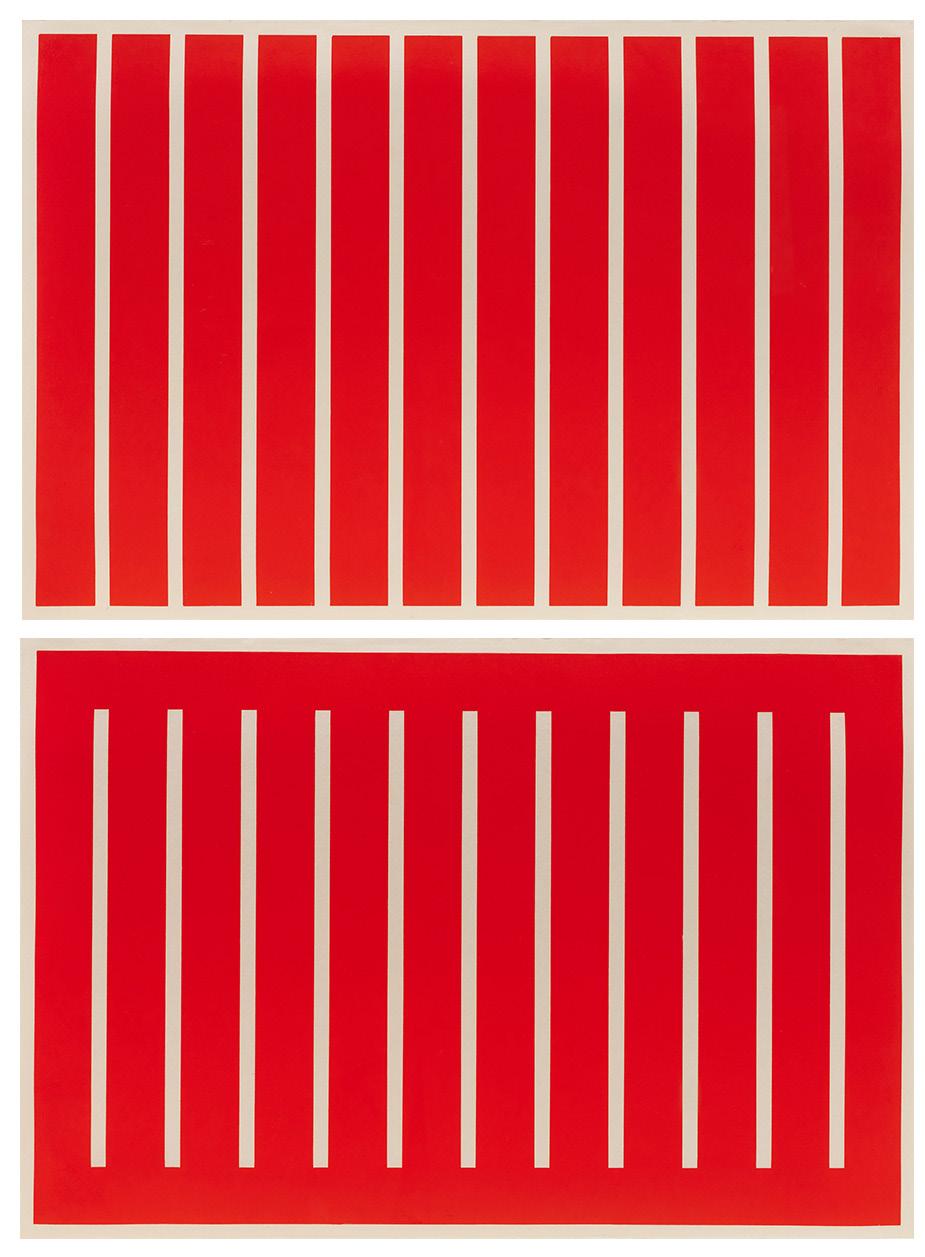
Sheet size: 26 1/2 x 39 1/8 inches, each (67.3 x 99.4 centimeters, each)
Printer: Derrière l’Etoile Studios, New York
Publisher: Brooke Alexander Editions, New York
Edition size: 10, plus proofs
Catalogue Raisonné: Schellmann 223-226
Each print is numbered and stamped by the estate of the artist, verso. These woodcuts were printed during the artist’s lifetime and under his supervision.
The complete set of four woodcuts
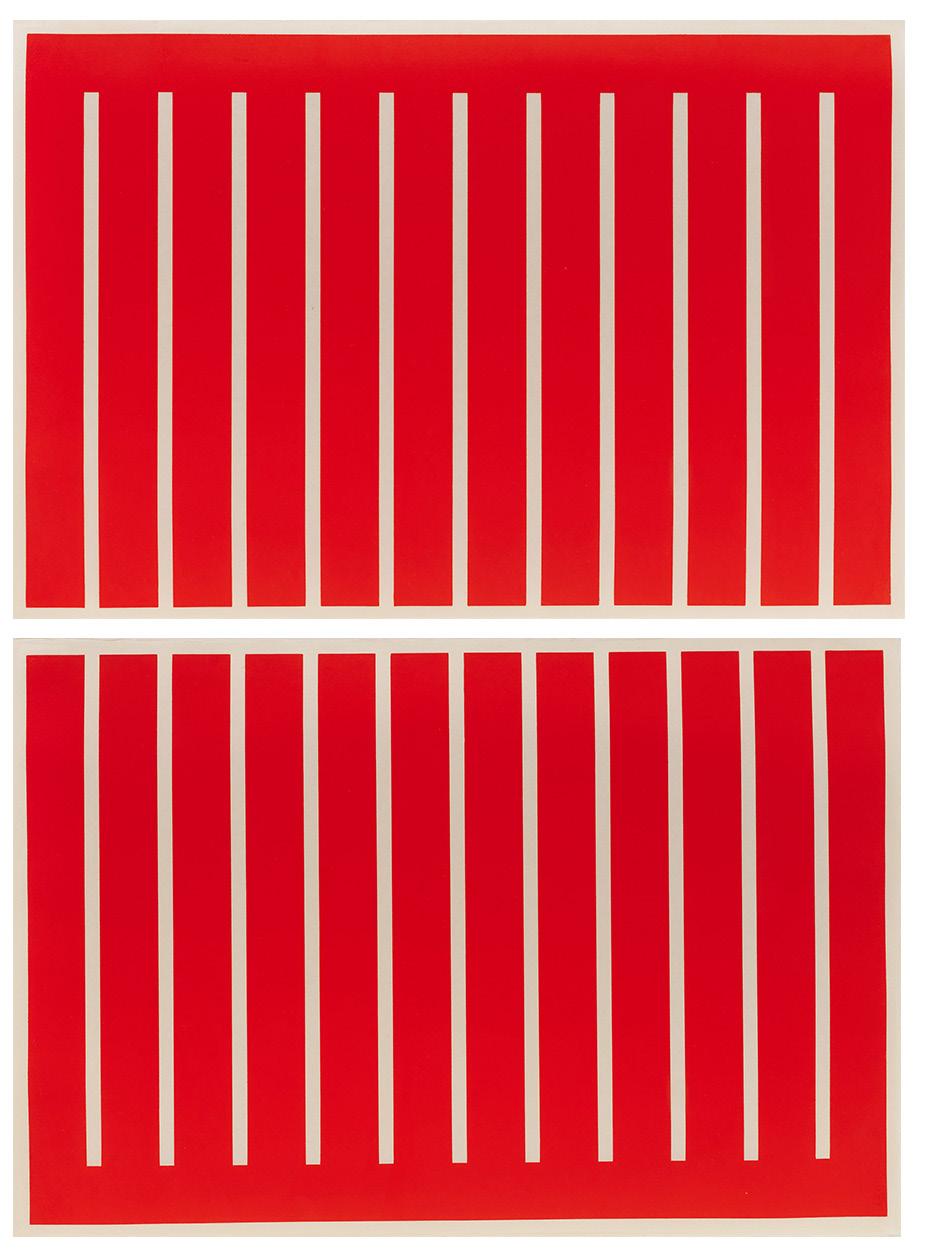
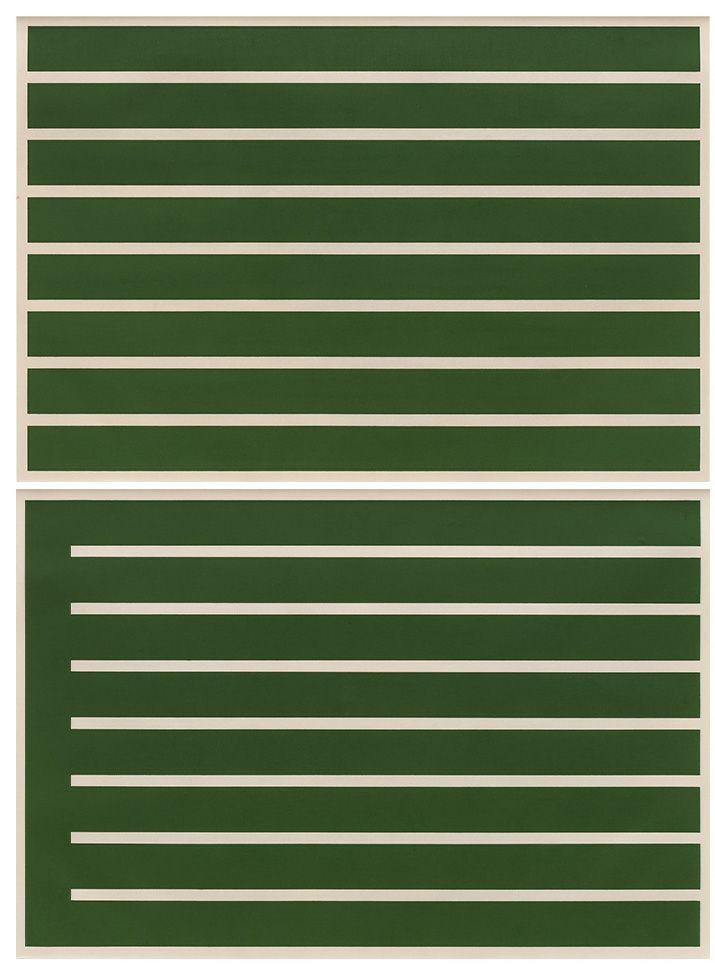
Untitled, 1992
Sheet size: 26 3/8 x 39 inches, each (67 x 99 centimeters, each)
Printer: Derrière l’Etoile Studios, New York
Publisher: Brooke Alexander Editions, New York
Edition size: 25, plus proofs
Catalogue Raisonné: Schellmann 211-214
Each print is signed and numbered, verso
The complete set of four woodcuts

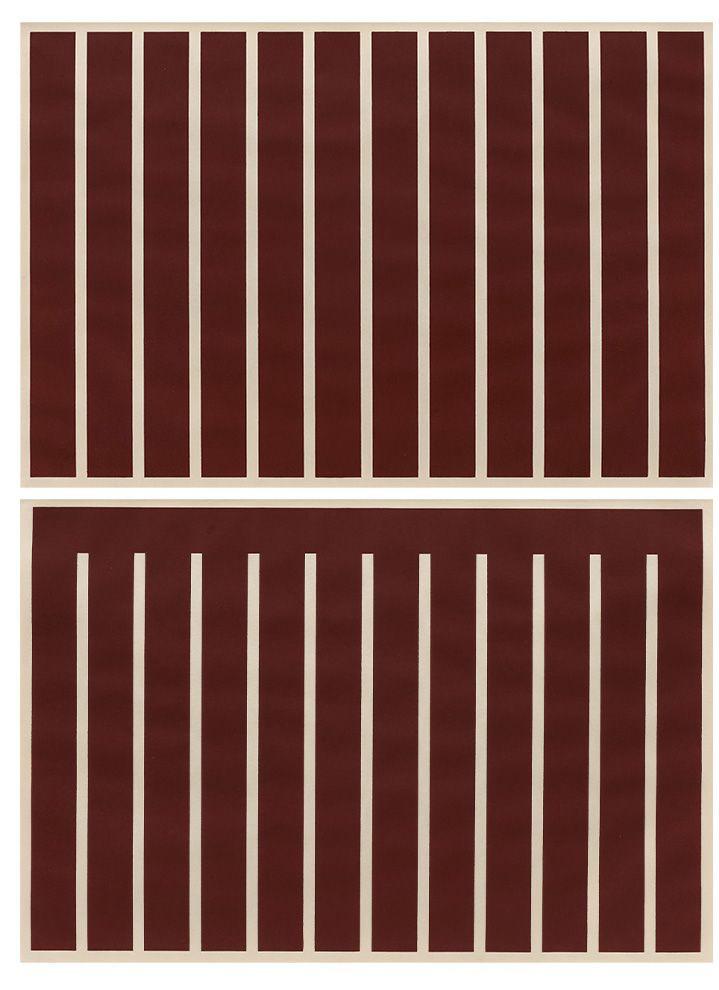
Untitled, 1992
Sheet size: 26 1/2 x 39 inches, each (67.3 x 99 centimeters, each)
Printer: Derrière l’Etoile Studios, New York
Publisher: Brooke Alexander Editions, New York
Edition size: 25, plus proofs
Catalogue Raisonné: Schellmann 215-218
Each print is signed and numbered, verso
The complete set of four woodcuts

Kelly
Colored Paper Image XV (Dark Gray and Blue), 1976
Colored and pressed paper pulp
Sheet size: 32 x 31 inches
(81.3 x 78.7 centimeters)
Printer: Ellsworth Kelly and Kenneth Tyler, fabricated at HMP Paper Mill, Woodstock, Connecticut
Publisher: Tyler Graphics Ltd., Bedford, New Yrok
Edition size: 23, plus proofs
Catalogue Raisonné: Axsom 155
Signed and numbered
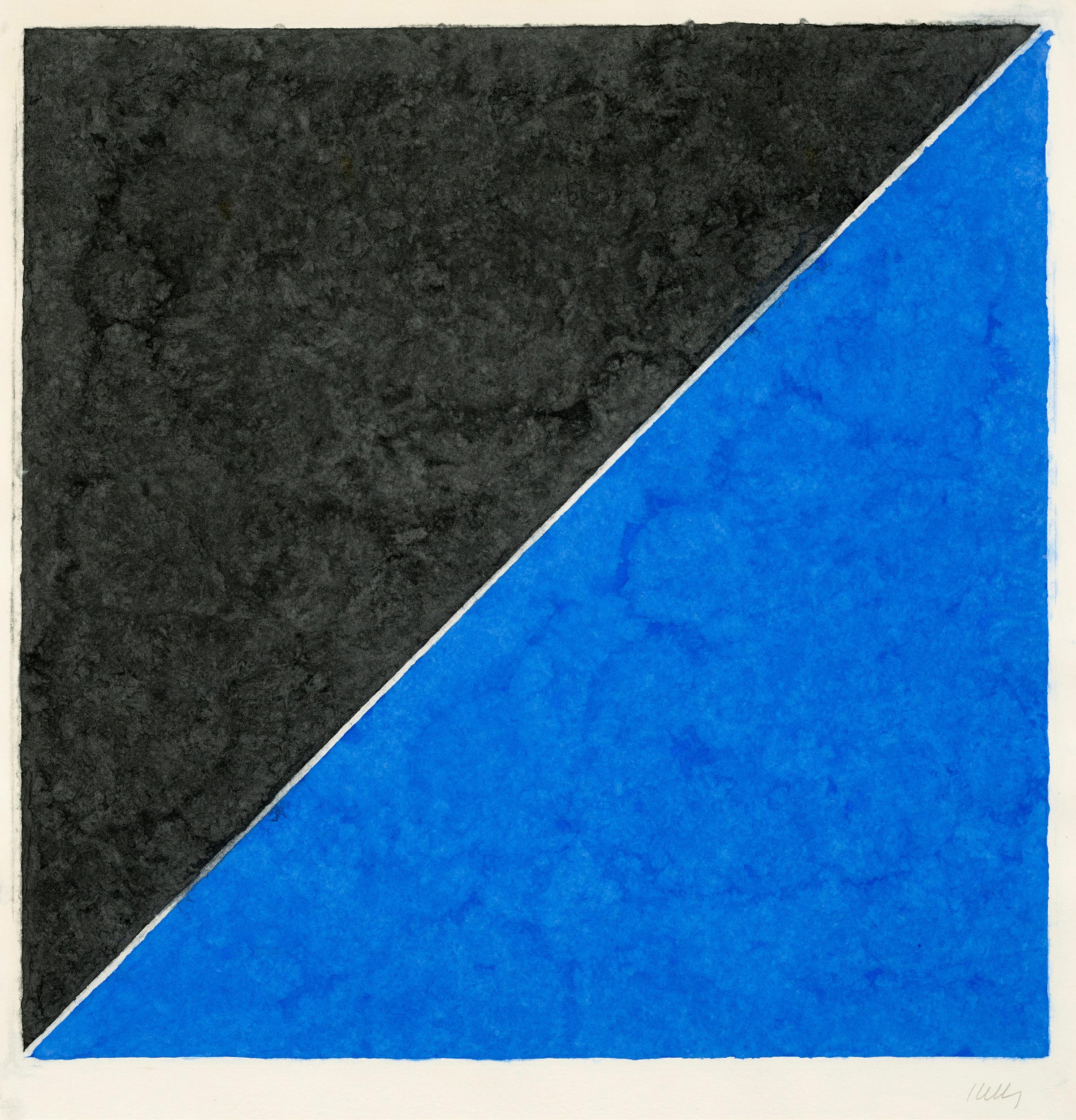
Ellsworth Kelly
Colored Paper Image XIV (Yellow Curve), 1976
Colored and pressed paper pulp
Sheet size: 32 1/2 x 31 1/4 inches
(82.6 x 79.4 centimeters)
Printer: Ellsworth Kelly and Kenneth Tyler, fabricated at HMP Paper Mill, Woodstock, Connecticut
Publisher: Tyler Graphics Ltd., Bedford, New York
Edition size: 24, plus proofs
Catalogue Raisonné: Axsom 154
Signed and numbered
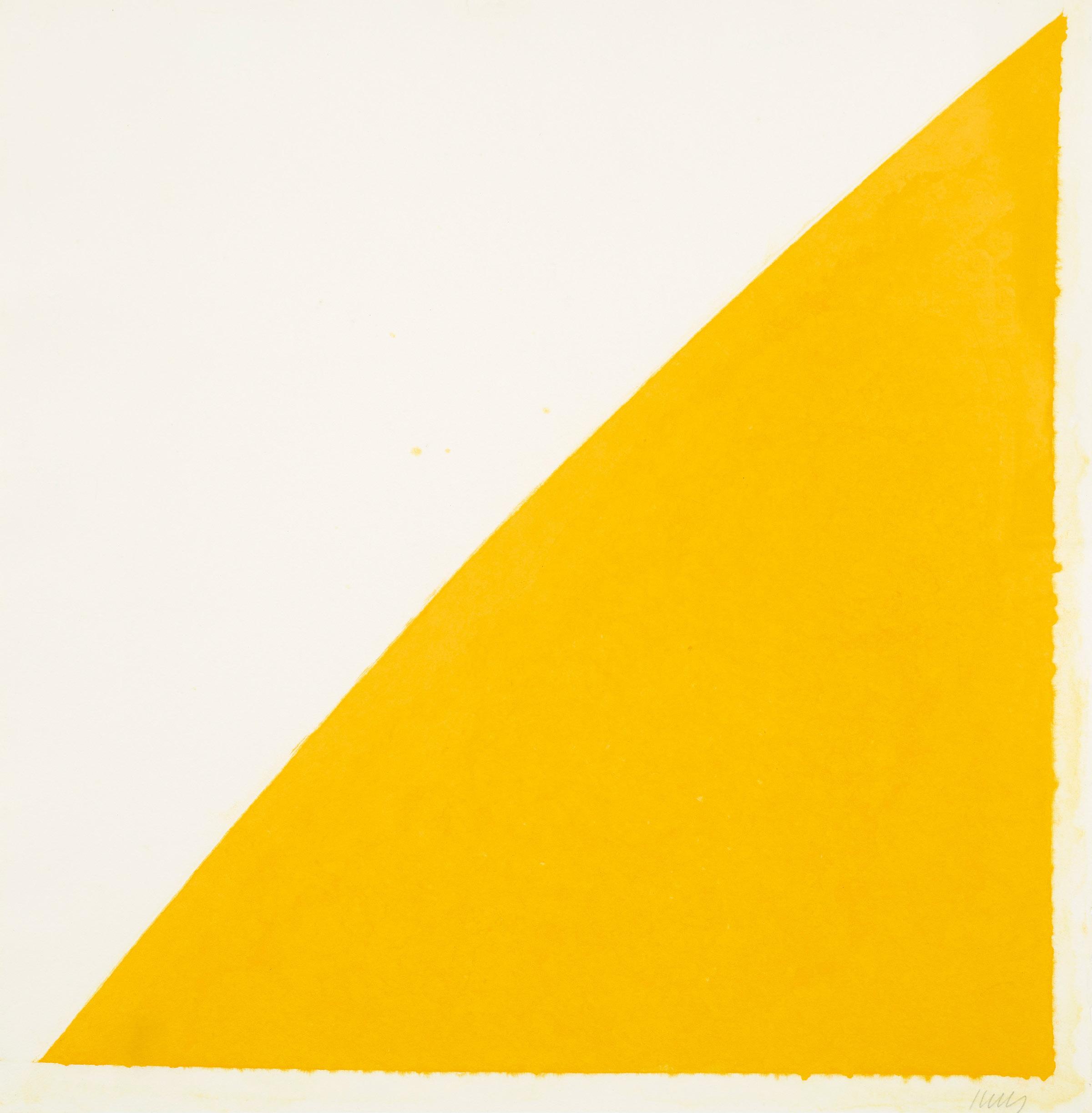
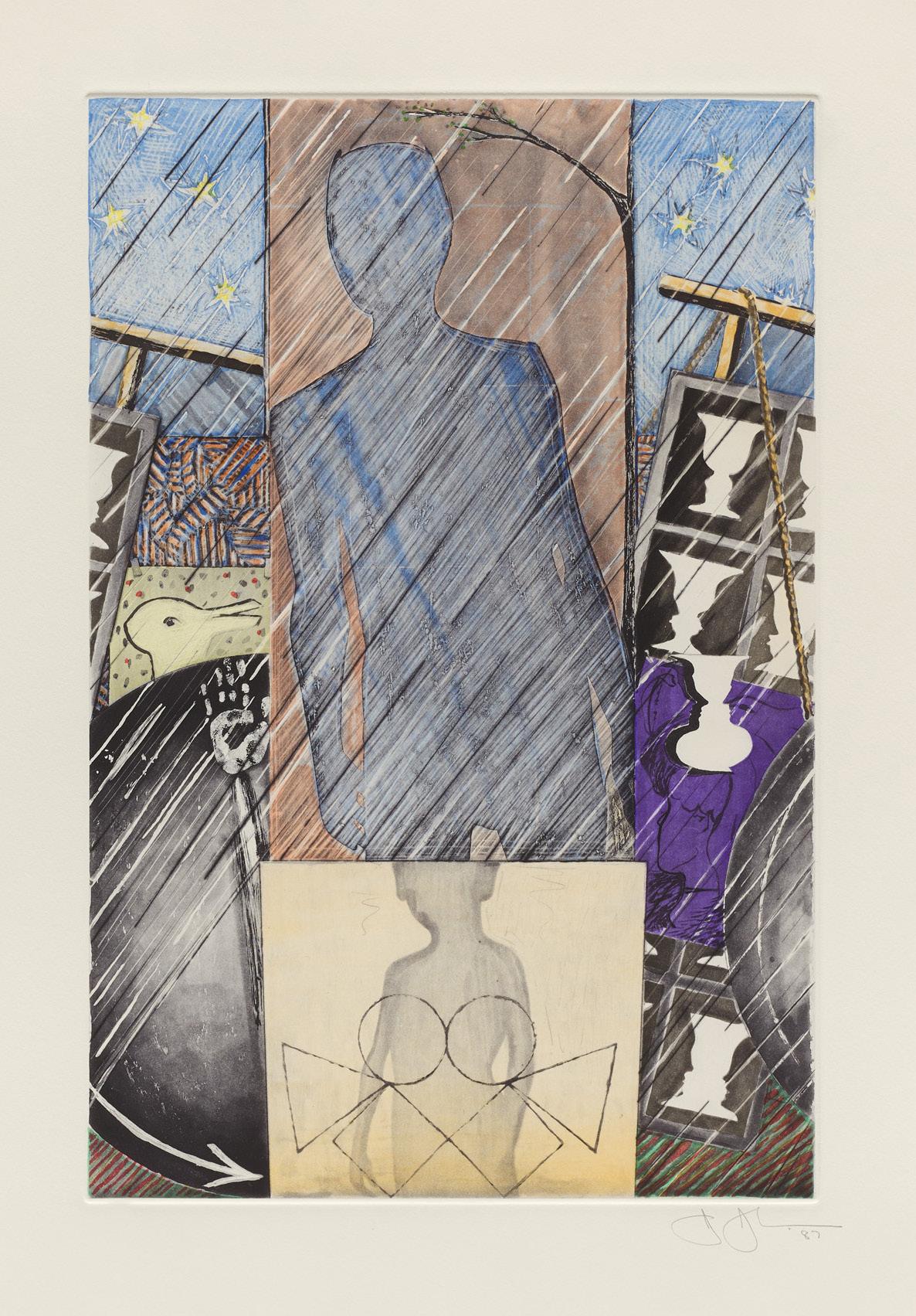
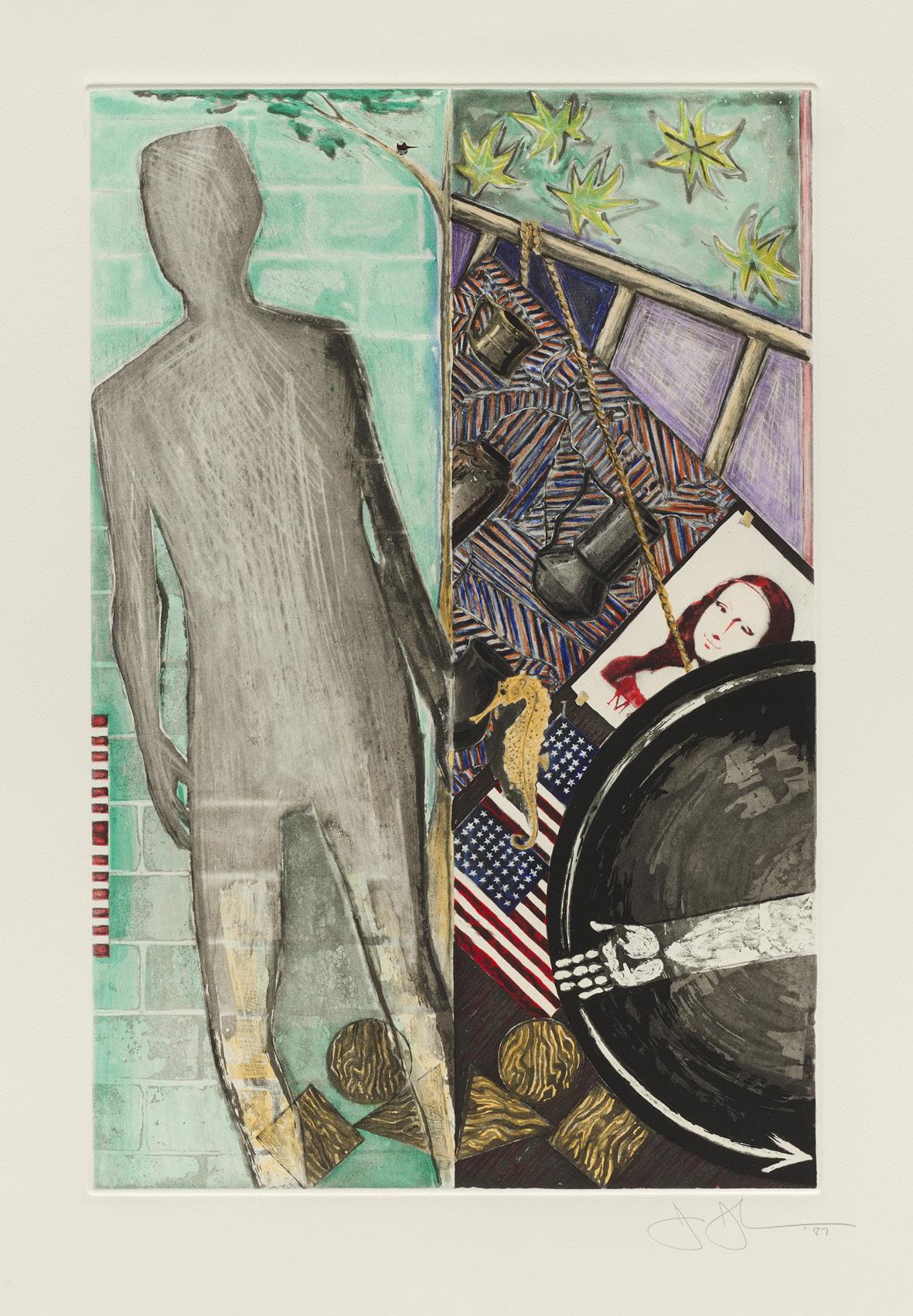
Jasper Johns
The Seasons, 1987
Etchings with aquatint
Sheet size: 26 x 19 1/4 inches, each
(66 x 48.9 centimeters, each)
Printer and Publisher: ULAE, West Islip, New York
Edition size: 73, plus proofs
Catalogue Raisonné: ULAE 238-241
Each print is signed, dated, and numbered
The complete set of four etchings with aquatint
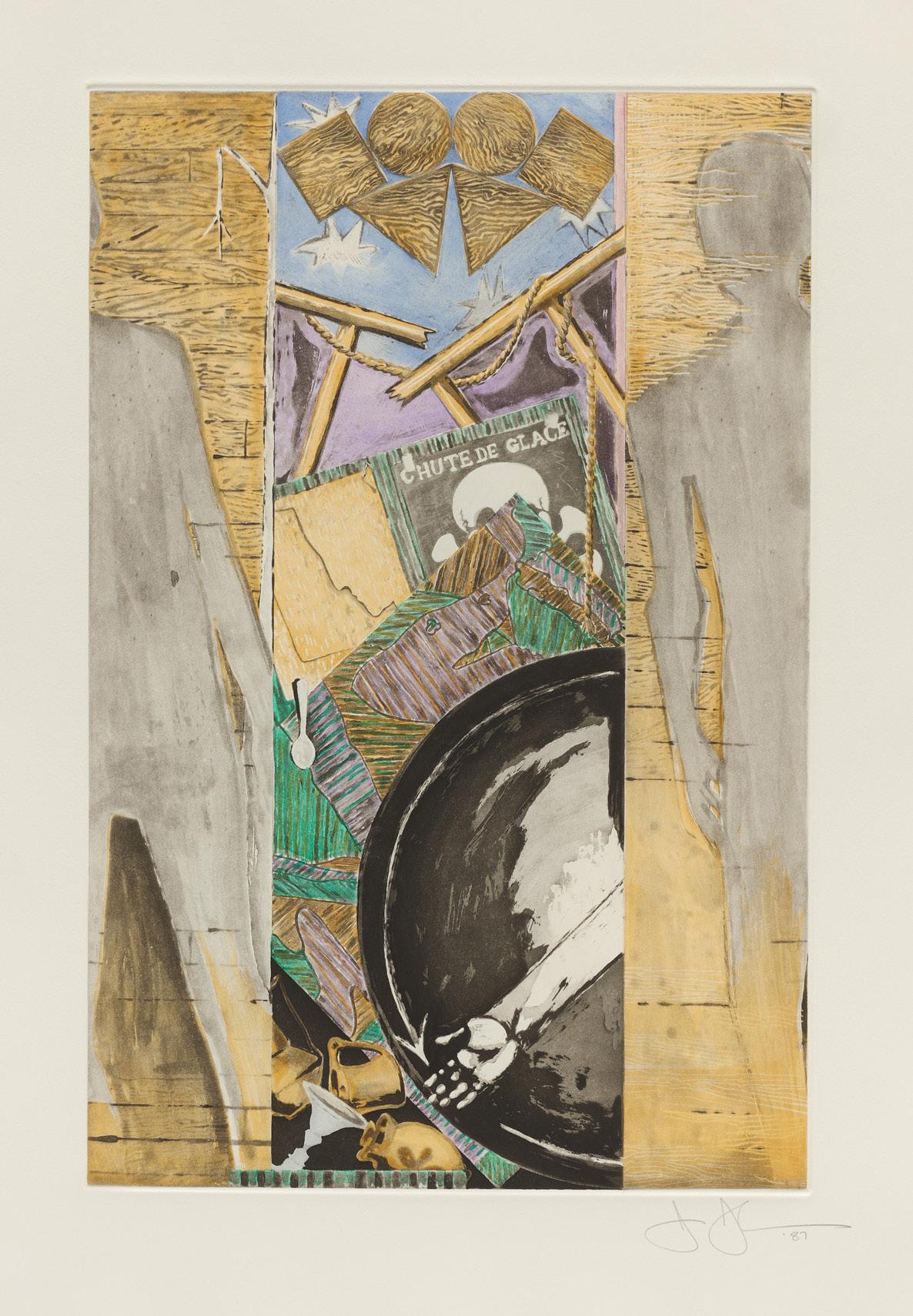
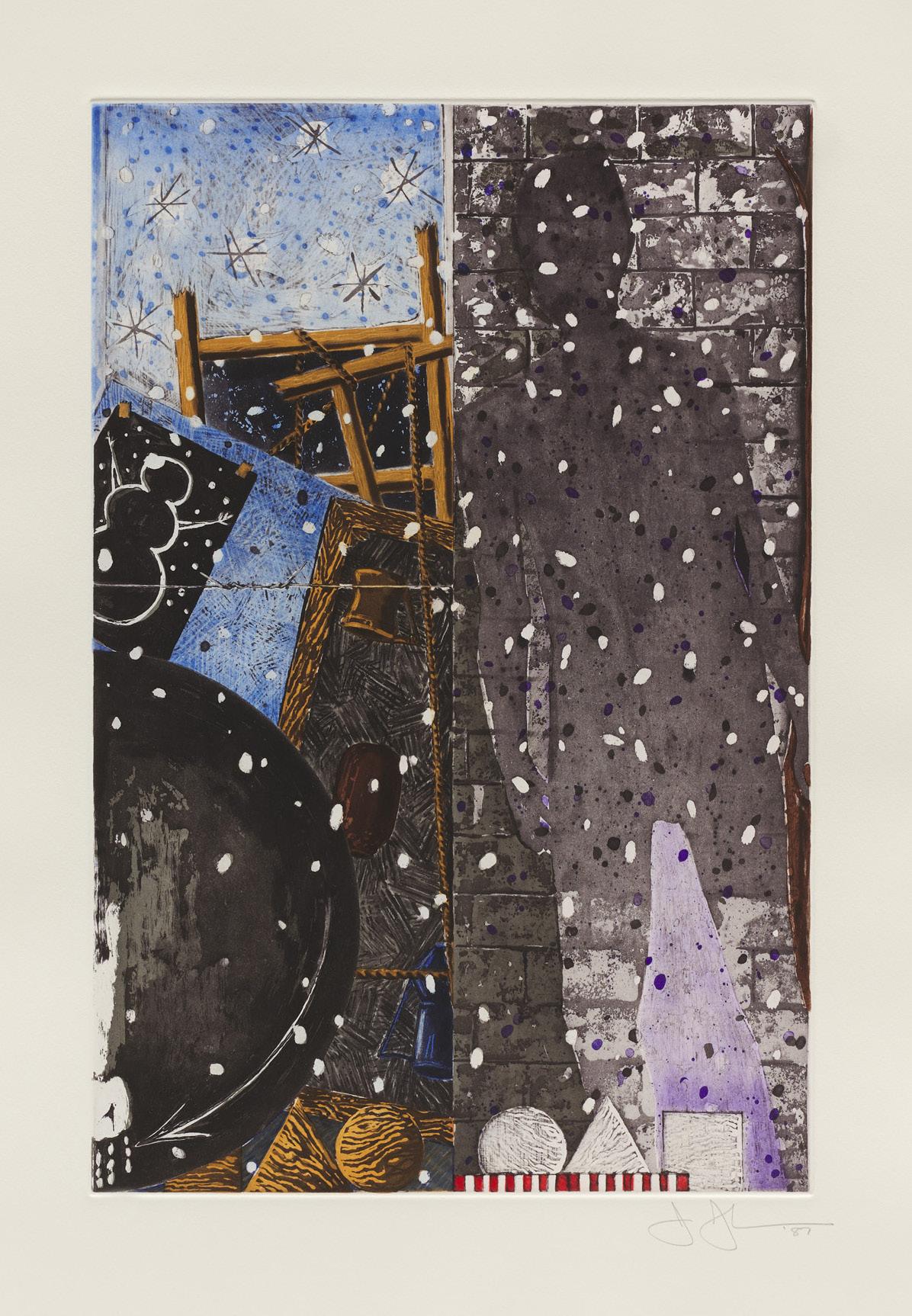
False Start II, 1962
Lithograph
Sheet size: 30 1/2 x 22 3/4 inches (77.5 x 57.8 centimeters)
Printer and Publisher: ULAE, West Islip, New York
Edition size: 30, plus proofs
Catalogue Raisonné: ULAE 10
Initialed, dated, and editioned
Provenance: Mark Lancaster, New York
Mark Lancaster (1938-2021) was a British-American artist and designer who worked as an assistant to Andy Warhol in the 1960s and to Jasper Johns in the 1970s and 80s. During this period, Lancaster also designed lighting, costumes, and sets for the Merce Cunningham Dance Company.
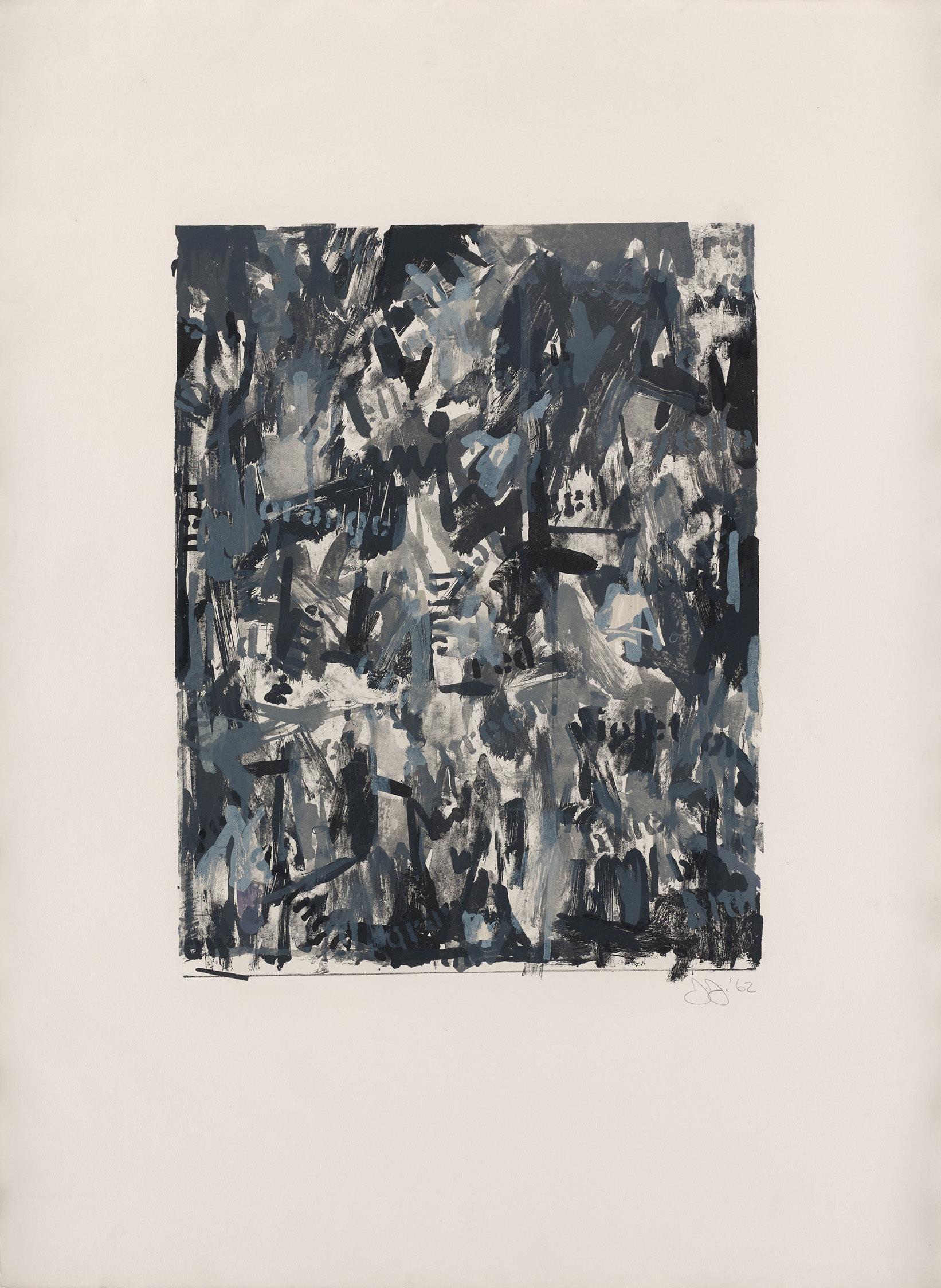
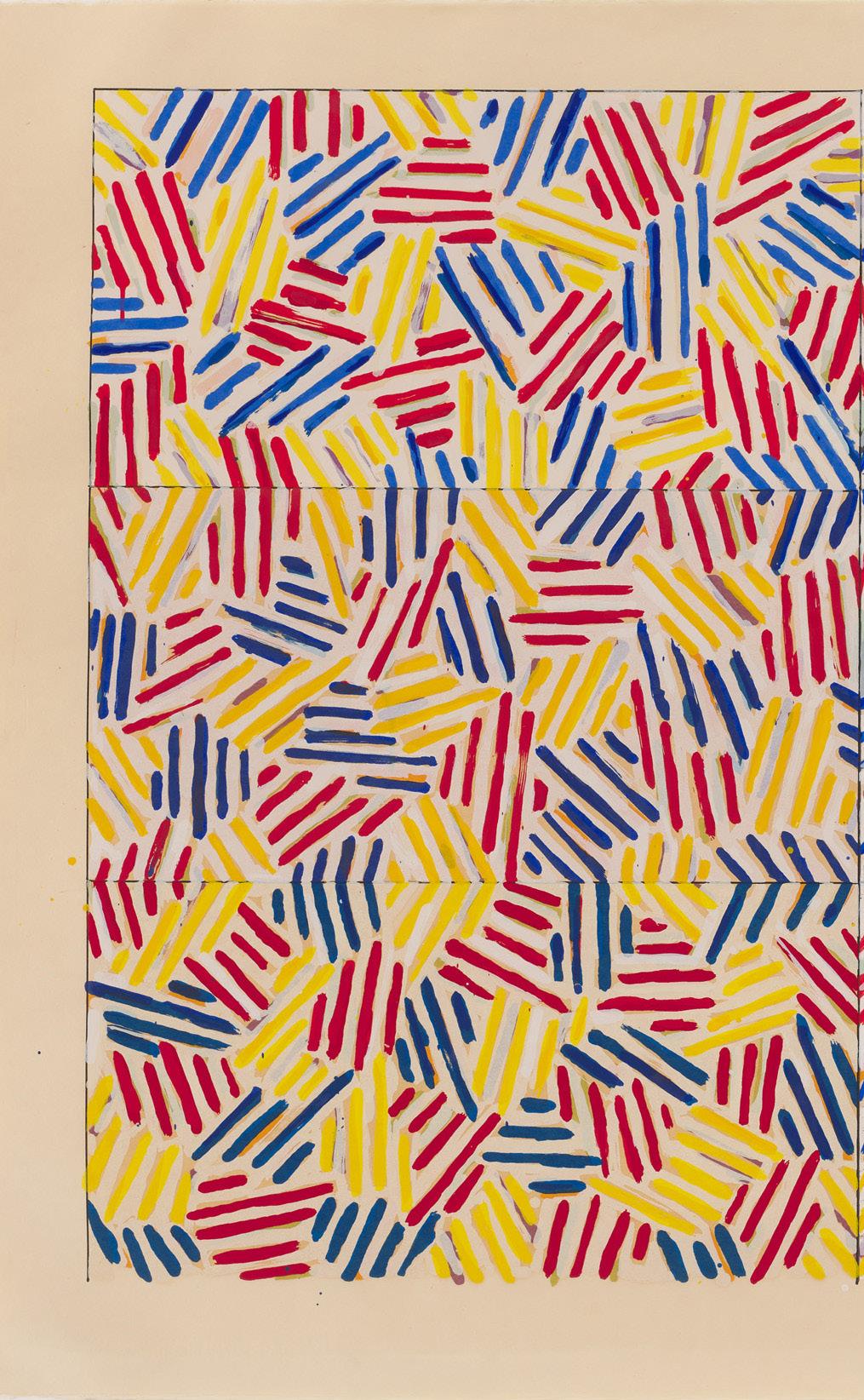
Jasper Johns
Corpse and Mirror, 1976
Screenprint
Sheet size: 42 7/8 x 53 3/8 inches (108.9 x 135.6 centimeters)
Printer and Publisher: Jasper Johns and Simca Print Artists, Inc., New York
Edition size: 65, plus proofs
Catalogue Raisonné: ULAE 169
Signed, dated, and numbered
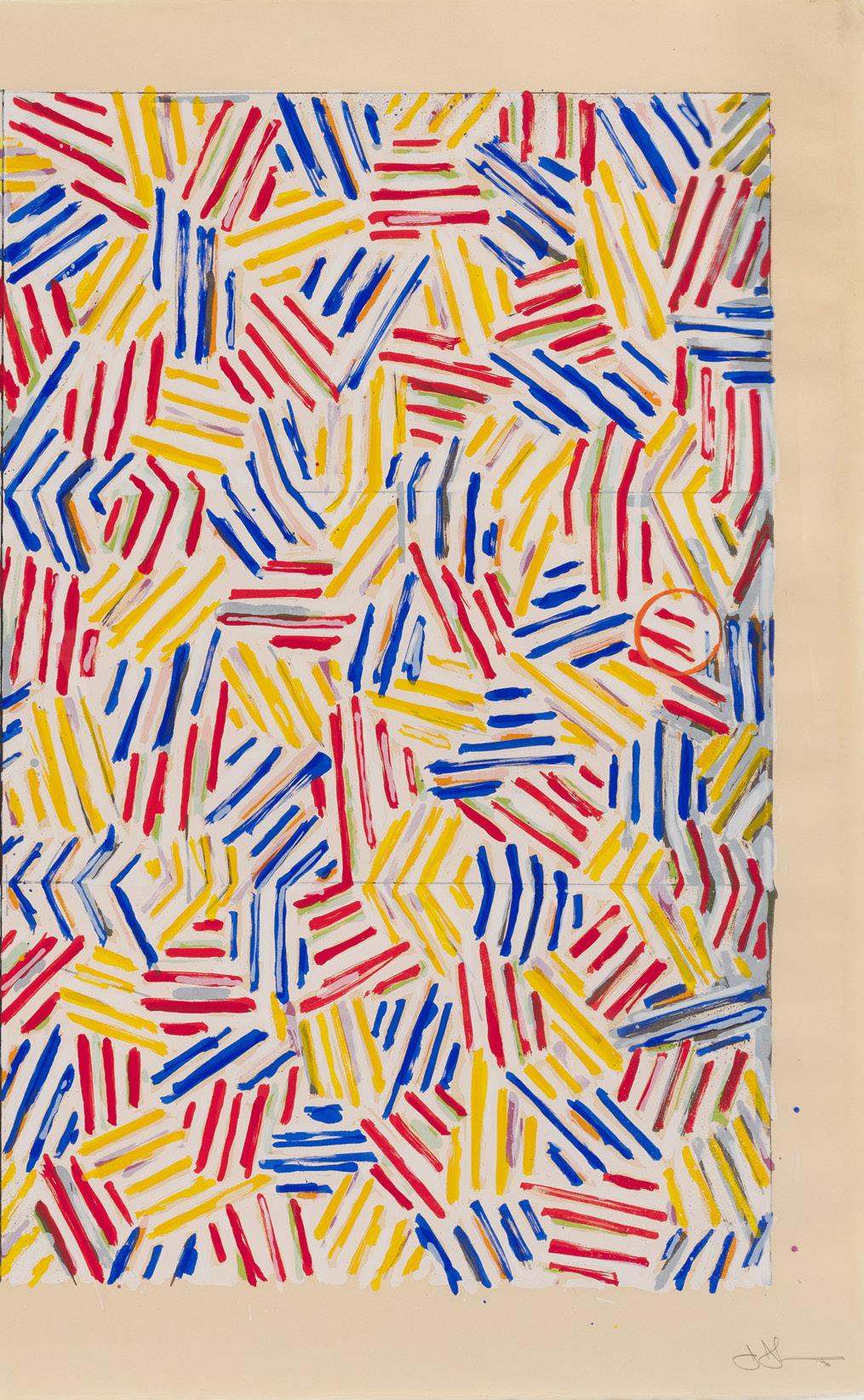
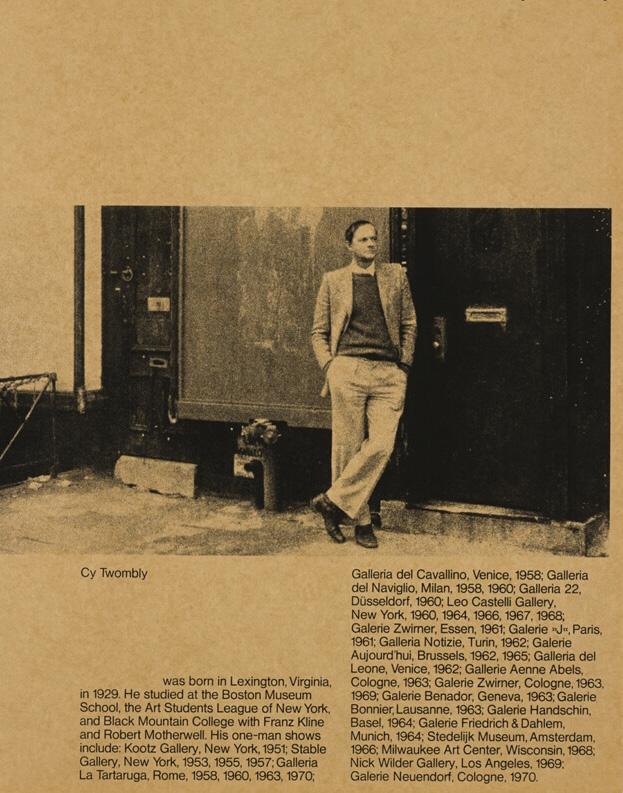
Cy Twombly’s output of graphic work is relatively modest compared to some of his contemporaries. The methodical nature of printmaking was generally at odds with his creative process, which was instinctive and immediate, often driven by sudden bursts of energy. The prints he did produce were often the product of circumstance, realized at the request of friends.
The creation of the mixed-artist portfolio, On the Bowery, was one such occasion. Organized in 1969 by Luitpold Domberger of the eponymous German print shop and publisher, the portfolio is composed of screenprints by ten artists—John Giorno, Charles Hinman, Robert Indiana, Will Insley, Gerald Laing, Les Levine, Robert Ryman, Richard Smith, John Willenbecher, and Cy Twombly—who lived and worked in the Bowery neighborhood of Lower Manhattan. Conceived as an homage to the area, the portfolio reflects the Bowery’s significance as an epicenter of creative activity from the 1940s through the 1970s.
The portfolio was edited by Bill Katz, who began his career in the 1960s as an ad hoc studio assistant to artists such as Robert Indiana, Ellsworth Kelly, Agnes Martin, and Cy Twombly. Katz has since risen to prominence for his curatorial work and his designs for studio and gallery spaces for artists, dealers, and collectors worldwide. His introductory text for On the Bowery traces the neighborhood’s history from its 17th-century Dutch colonial origins to the 1960s. His writing demonstrates a deep understanding of the area, which attracted artists with its affordable rents (the Bowery had previously been considered New York’s “skid row”) and large, airy lofts that made ideal studios.
Twombly began developing the visual language of his “Blackboard” paintings in lower Manhattan in the 1950s. In May of 1968, he took a studio at 356 Bowery where he expanded upon the theme, creating some of his earliest monumental gray-ground works. In Untitled, Twombly’s calligraphic spirals are printed with heightened contrast, as layered lines of deep charcoal and white bring the artist’s free-flowing rhythm into focus.
Cy Twombly
Untitled, 1969-71
Screenprint
Sheet size: 25 1/2 x 25 1/2 inches (64.8 x 64.8 centimeters)
Printer and Publisher: Edition Domberger, Filderstadt
Edition size: 100, plus proofs
Catalogue Raisonné: Bastian 27
Signed and numbered, verso
From the portfolio On the Bowery, edited by William Katz, which also includes screenprints by John Giorno, Charles Hinman, Robert Indiana, Will Insley, Gerald Laing, Les Levine, Robert Ryman, Richard Smith, and John Willenbecher.
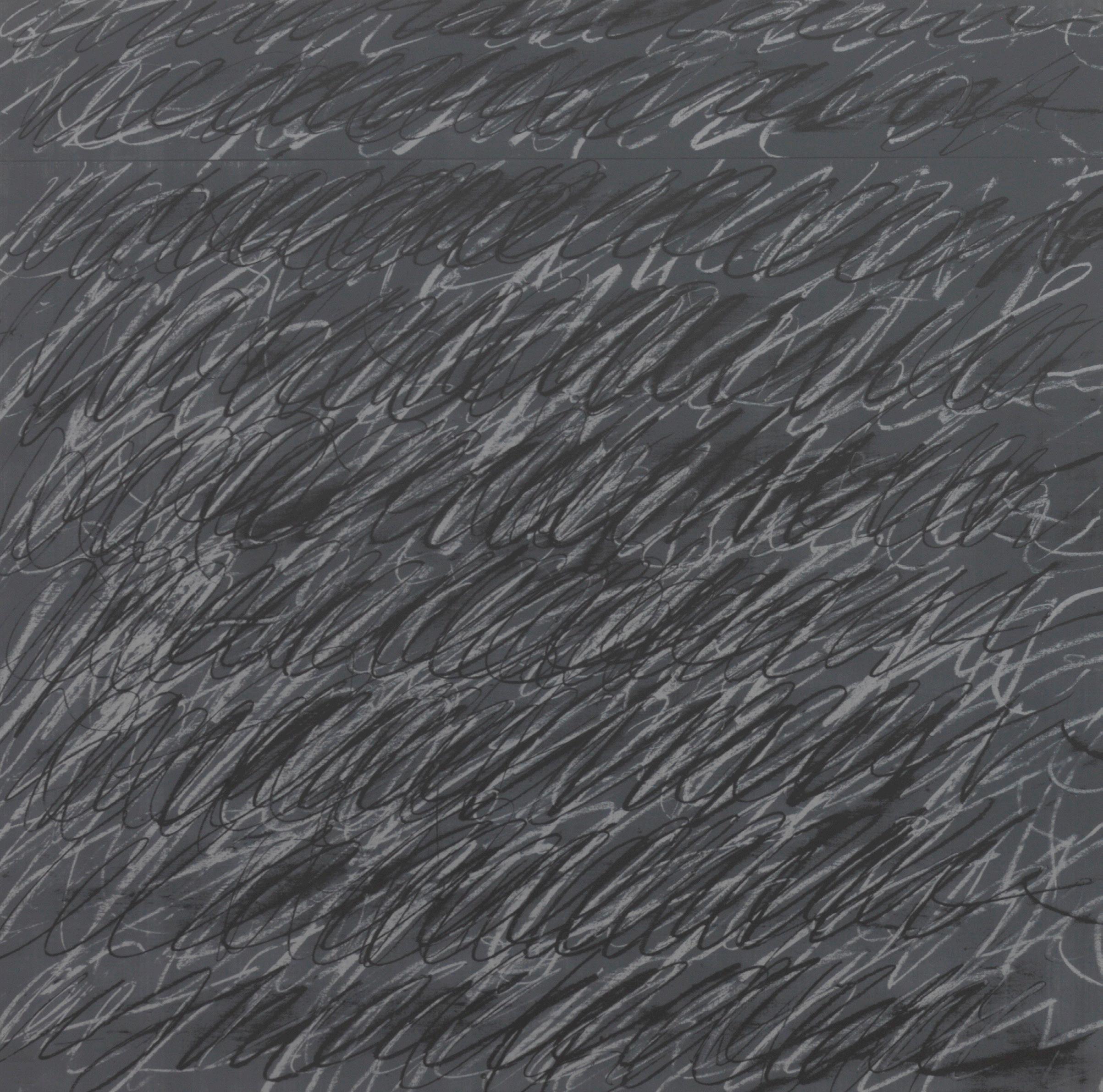
Roy Lichtenstein
Sweet Dreams, Baby!, 1965
Screenprint
Sheet size: 37 5/8 x 27 5/8 inches (95.6 x 70.2 centimeters)
Printer: Knickerbocker Machine and Foundry Inc., New York
Publisher: Original Editions, New York
Edition size: 200, plus proofs
Catalogue Raisonné: Corlett 39, RLCR 1172
Signed and numbered
Provenance:
Galerie Ileana Sonnabend, Paris
Purchased directly from the above at the time of publication By descent to the previous owner
From the portfolio 11 Pop Artists III, Volume II, which also includes prints by Allan d’Arcangelo, Jim Dine, Allen Jones, Gerald Laing, Peter Phillips, Mel Ramos, James Rosenquist, Andy Warhol, John Wesley, and Tom Wesselmann.
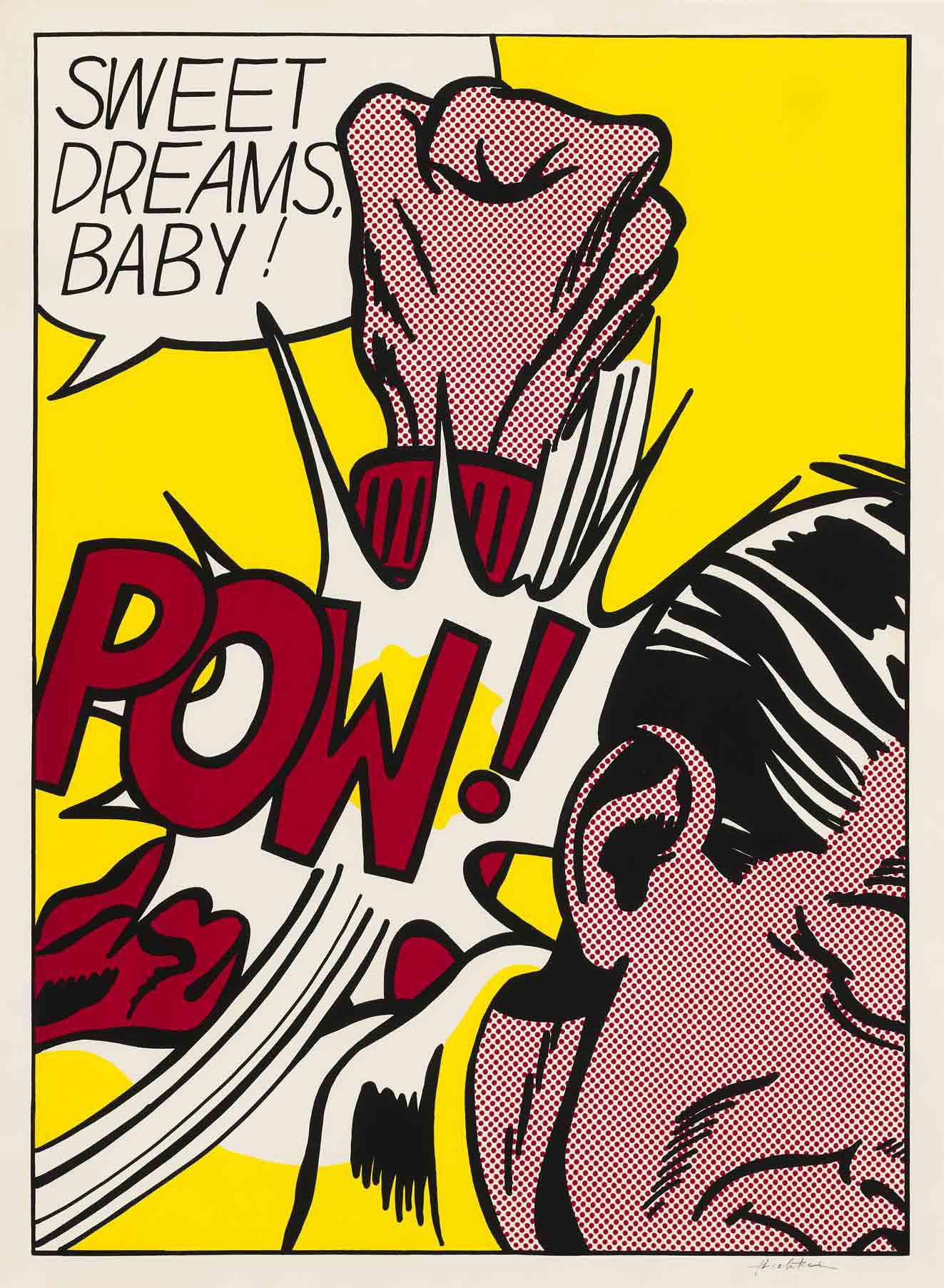
Roy Lichtenstein
Brushstrokes, 1967
Screenprint
Sheet size: 23 x 31 inches
(58.4 x 78.7 centimeters)
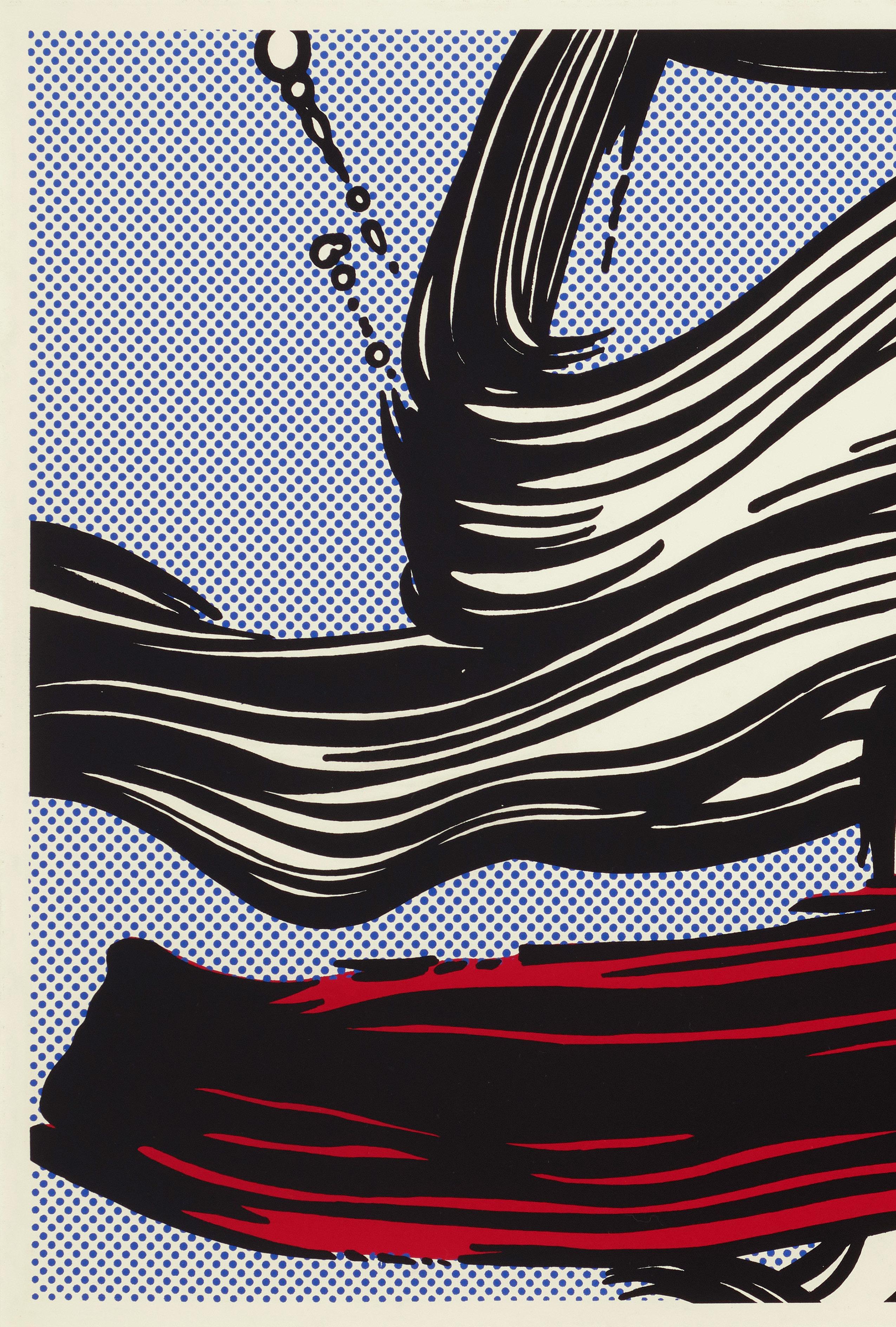
Printer: Aetna Silkscreen Products, New York
Publisher: Leo Castelli Gallery, for the Pasadena Art Museum, California
Edition size: 300, plus proofs
Catalogue Raisonné: Corlett 45, RLCR 1293
Signed and numbered
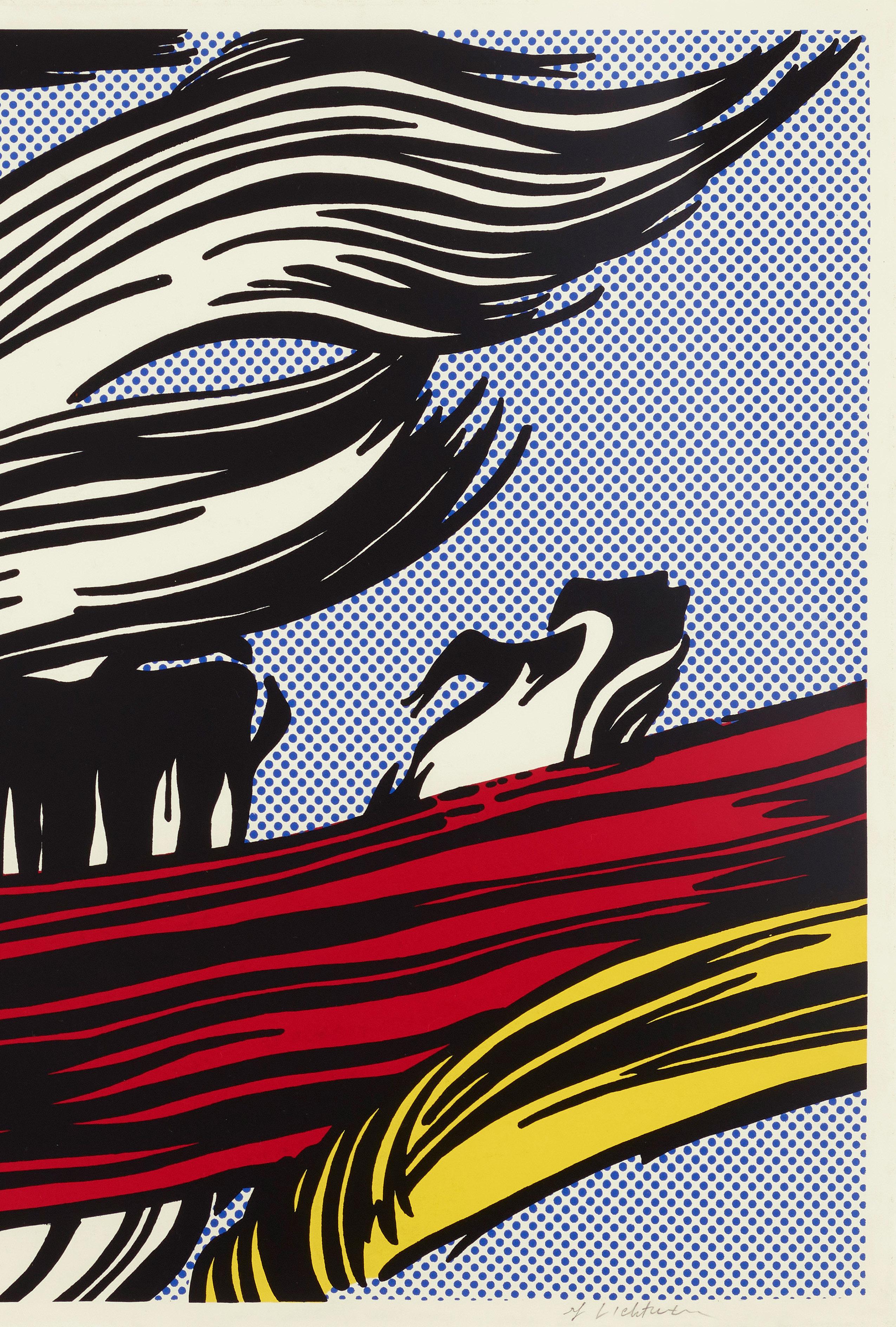
Andy Warhol
Flowers, 1964
Offset lithograph
Sheet size: 23 x 23 inches
(58.4 x 58.4 centimeters)
Printer: Total Color, New York
Publisher: Leo Castelli Gallery, New York
Edition size: Approximately 300
Catalogue Raisonné: Feldman and Schellmann II.6
Signed and dated
Provenance: The Artist
Galerie Ileana Sonnabend, Paris By descent to the previous owner


Joan Mitchell made her first prints as a student at the Ox-Bow School of Art in Michigan in the 1940s and returned to the medium periodically throughout her career. In 1981, master printer Kenneth Tyler, renowned for his experimental techniques and collaborative relationships with artists, persuaded Mitchell to create large-scale lithographs in his Bedford, New York workshop. Tyler believed lithography could translate the evocative abstraction of her paintings, and the resulting Bedford Series demonstrated Mitchell’s instinctive grasp of the medium.
The success of the Bedford Series led the artist and printer to reunite in 1992 to create the Sunflower Series. With more than ten years between the projects, the subdued palette of the Bedford Series is transformed in the Sunflower Series, where Mitchell’s explosive marks are rendered in rich complementary hues. Here, the gestural marks that defined her deliberate approach to painting—a careful process of action, reflection, and revision—are more clearly articulated. Throughout the project, Mitchell worked on clear Mylar sheets for color separation, visualizing and revising layers of ink until each composition met her standards.
Mitchell completed the Sunflower Series at Tyler’s studio in Mount Kisco, New York, which offered more space to create prints on a grander scale. Even with the larger press, Mitchell’s vision could not be confined to a single sheet. Each work in the Sunflower Series was conceived as a diptych to be framed as a single monumental piece. The scale underscores her position as a key figure in the male-dominated New York School. As early as the 1950s, Mitchell received critical acclaim for her immense “all-over” paintings, such as Hemlock, accessioned by the Whitney Museum of American Art in 1958.
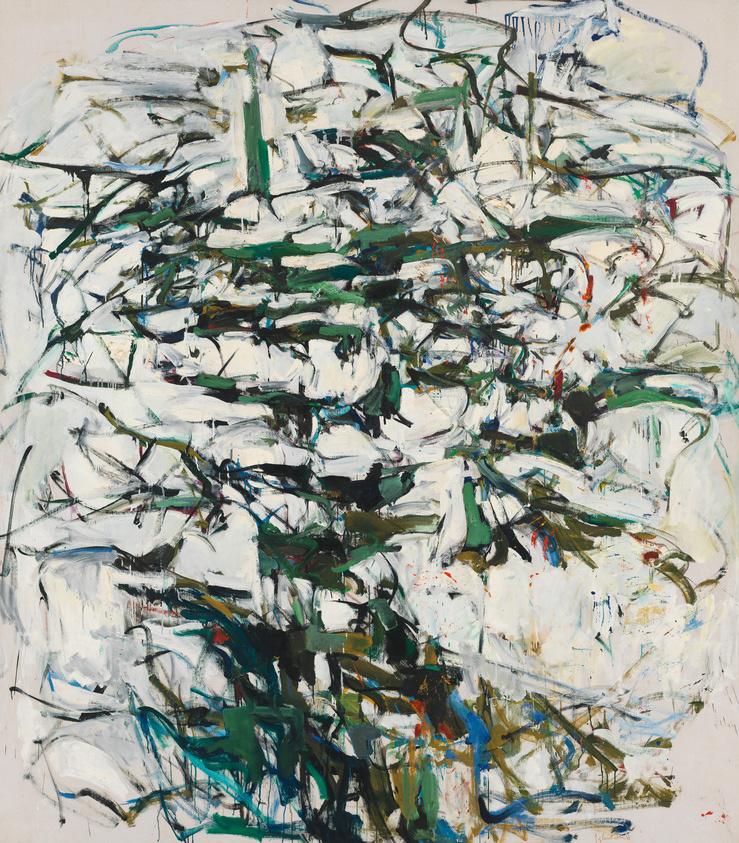
Mitchell’s lyrical abstraction is often read through an emotional lens, and sunflowers are a particularly charged motif that, in the artist’s own words, “are like people to me.” The Sunflower paintings and lithographs created in the final years of Mitchell’s life embody the complete life cycle of the flower, unwinding and reforming across a brilliant spectrum of color.
Joan Mitchell
Sunflowers III, 1992
Lithograph on two sheets

Sheet size: 56 7/8 x 82 1/2 inches, overall (144.5 x 209.6 centimeters, overall)
Printer and Publisher: Tyler Graphics, Ltd., Mount Kisco, New York
Edition size: 34, plus proofs
Signed, dated, and numbered on the right sheet
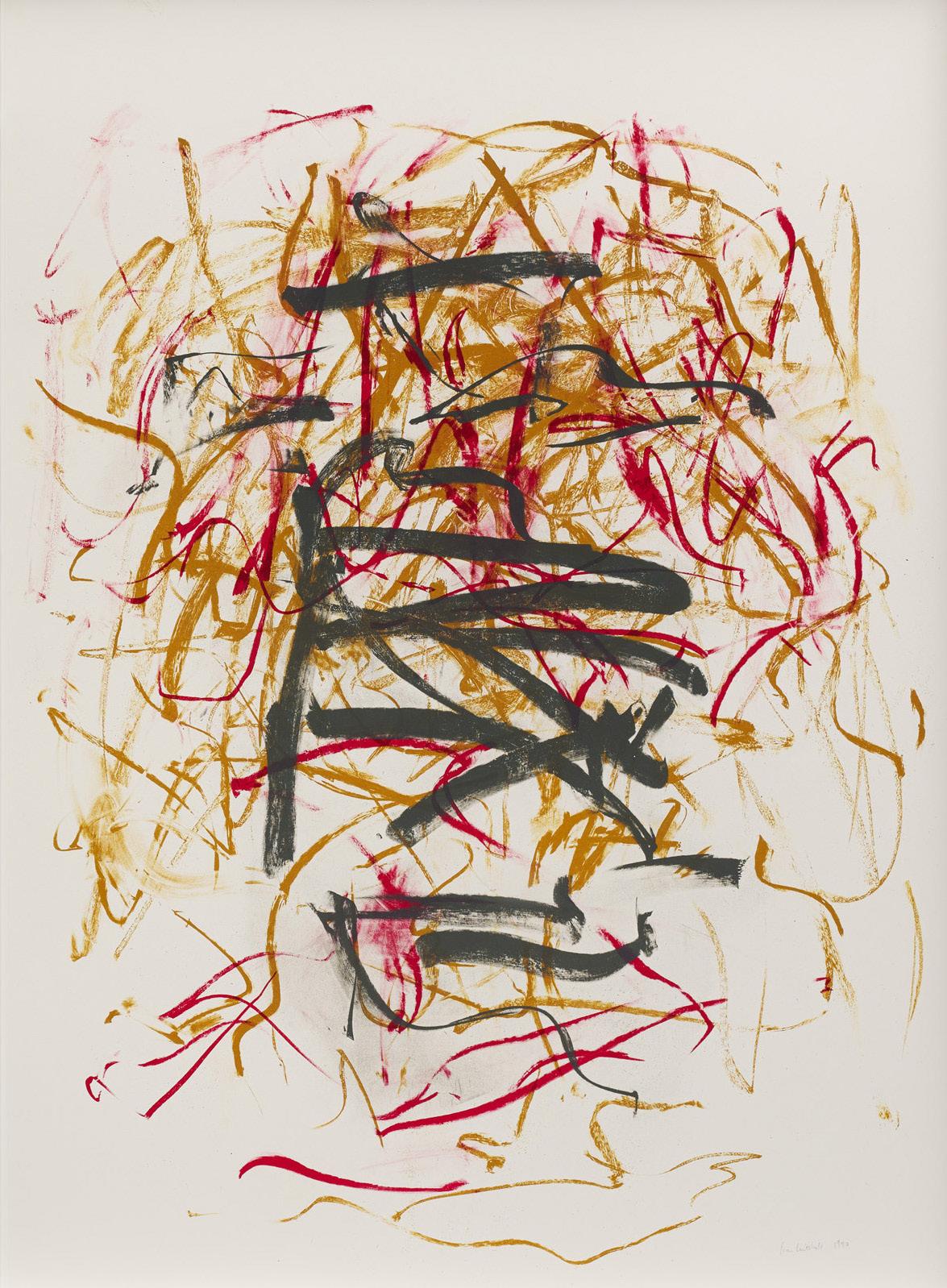
Andy Warhol moved to New York City in 1949, where he began a successful career as a commercial artist. Throughout the 1950s, Warhol collaborated with designer Israel Miller of the Manhattan shoe store I. Miller to produce full-page advertisements for The New York Times. These illustrations, celebrated for their sophistication and accuracy, were created using Warhol’s innovative “blotted line” technique which integrated printmaking and drawing and allowed Warhol to replicate images with ease.
Untitled (Cake) and Melorange Glacé are two rare and unique blotted line drawings from this period. These images are related to Wild Strawberries, a satirical cookbook written by Suzie Frankfurt in 1959 that Warhol illustrated. The extravagent desserts were inspired by Serendipity 3, a boutique coffee house on the Upper East Side of Manhattan that Warhol frequented. The artist hosted coloring parties for his illustrations at the eclectic café, where he often traded his shoe drawings in exchange for his meals.
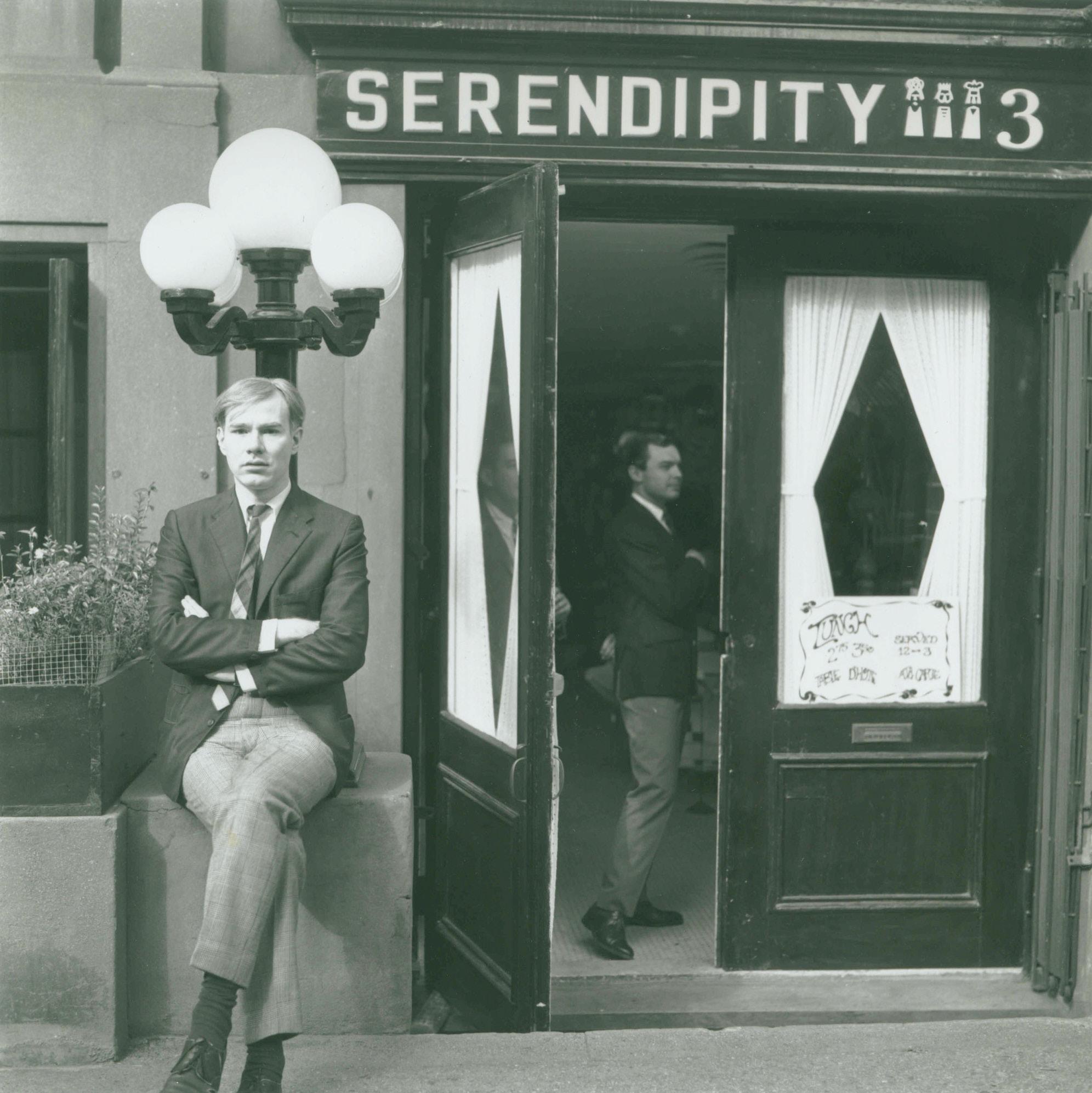
Untitled (Cake), 1959
Unique blotted line drawing with ink wash in colors and applied gold collage
Sheet size: 28 5/8 x 22 5/8 inches (72.7 x 57.5 centimeters)
Stamped on the verso by The Estate of Andy Warhol and The Andy Warhol Foundation
Initialed ‘VF’ by Vincent Fremont of The Andy Warhol Foundation
Provenance:
The Estate of Andy Warhol
Susan Sheehan Gallery, New York
American Private Collection
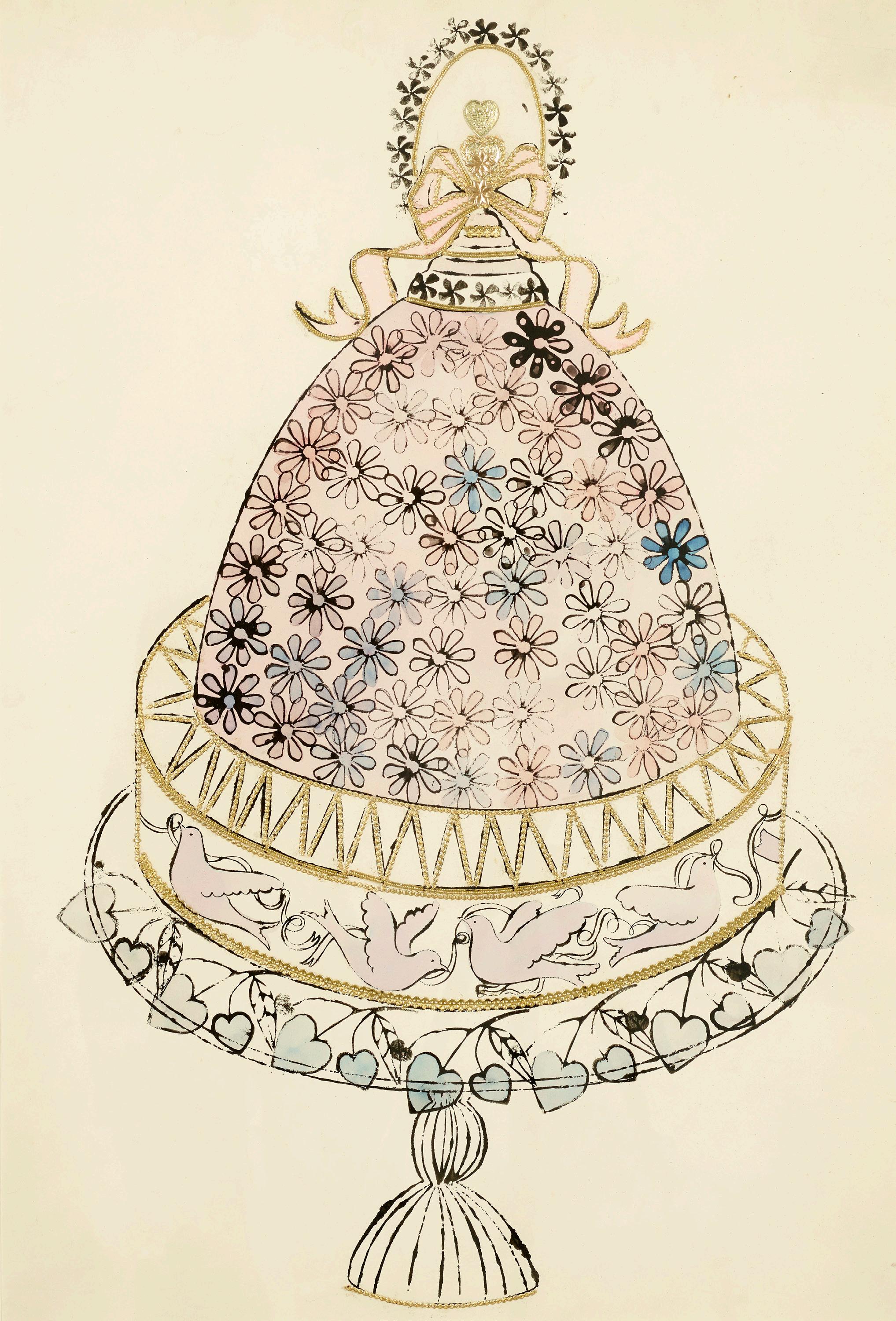
Unique blotted line drawing with ink wash in colors
Sheet size: 27 7/8 x 21 3/4 inches
(70.8 x 55.2 centimeters)
Signed and titled
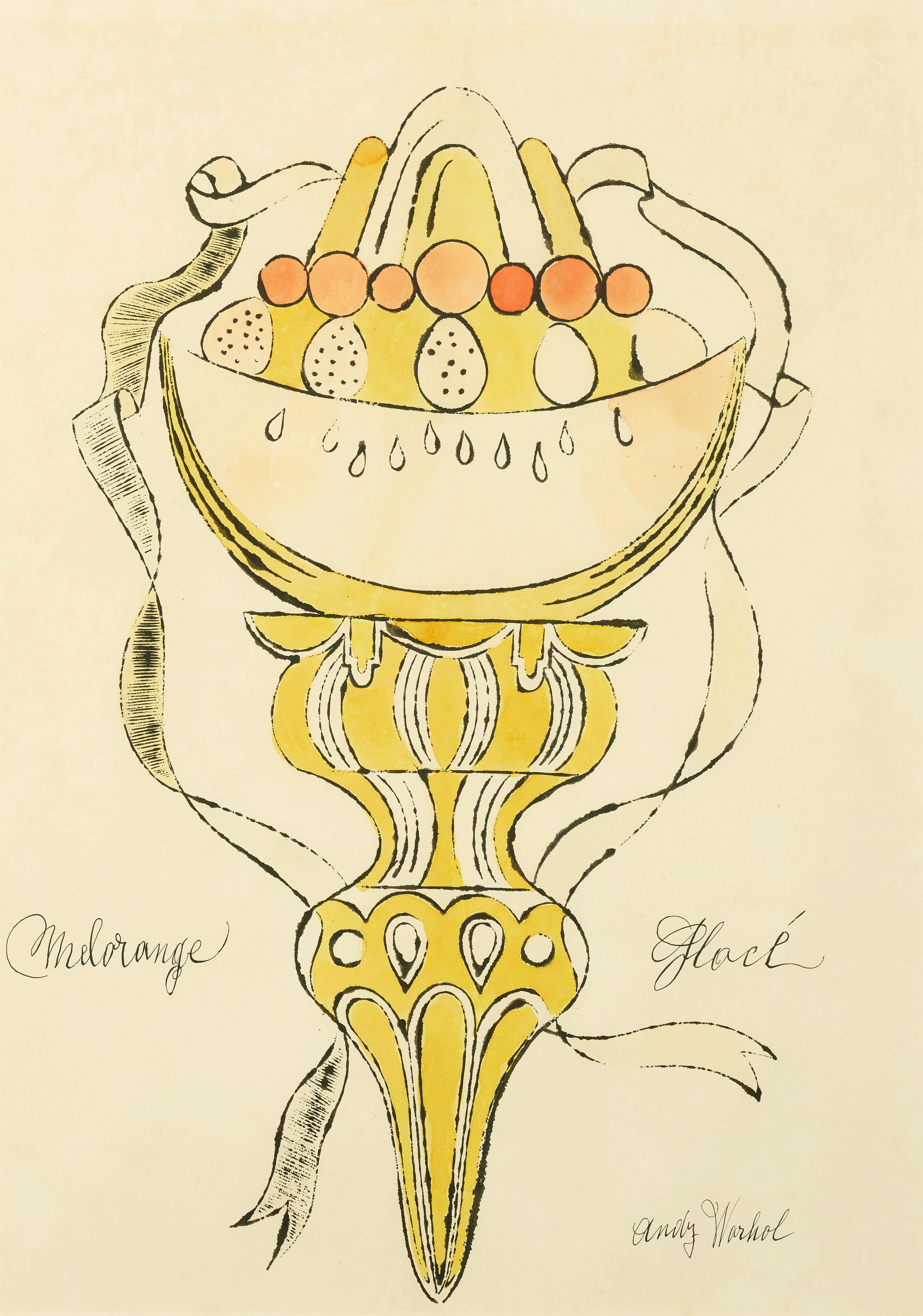
Signed in ink

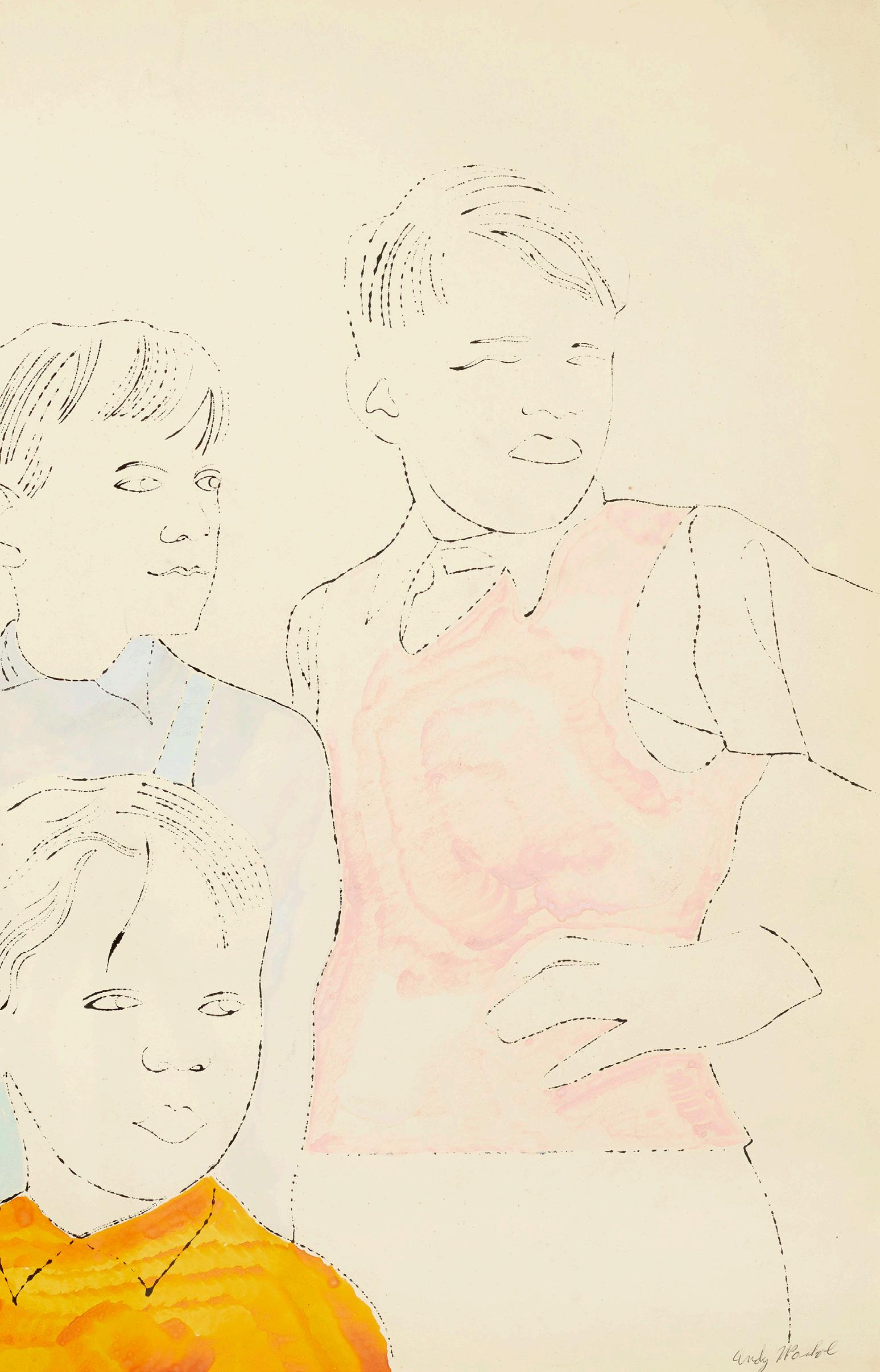
À la Recherche du Shoe Perdu was a series of hand-colored offset lithographs— sixteen single sheets, one folded sheet, and one folded cover—created during Warhol’s tenure as an illustrator for the shoe company I. Miller. The portfolio was never formally published. Rather, Warhol used the shoe illustrations as examples of his work, assembling impromptu sets to market his skills to potential clients. The portfolio features poetry by Ralph Pomeroy in lettering by Warhol’s mother, Julia Warhola. Warhol and his friends hand-colored the sheets at “coloring parties” hosted by the artist. As a result, there are often significant variations between proofs, including changes in the lettering and the occasional addition of collage.
Uncle Sam Wants Shoe, c. 1955
Hand-colored offset lithograph with gold foil collage
Sheet size: 9 3/4 x 13 3/4 inches (24.8 x 34.9 centimeters)
Catalogue Raisonné: Feldman and Schellmann IV.69
Stamped on the verso by The Estate of Andy Warhol and The Andy Warhol Foundation
Initialed ‘VF’ by Vincent Fremont of The Andy Warhol Foundation
Provenance:
The Estate of Andy Warhol
Susan Sheehan Gallery, New York
American Private Collection
From the portfolio À la Recherche du Shoe Perdu
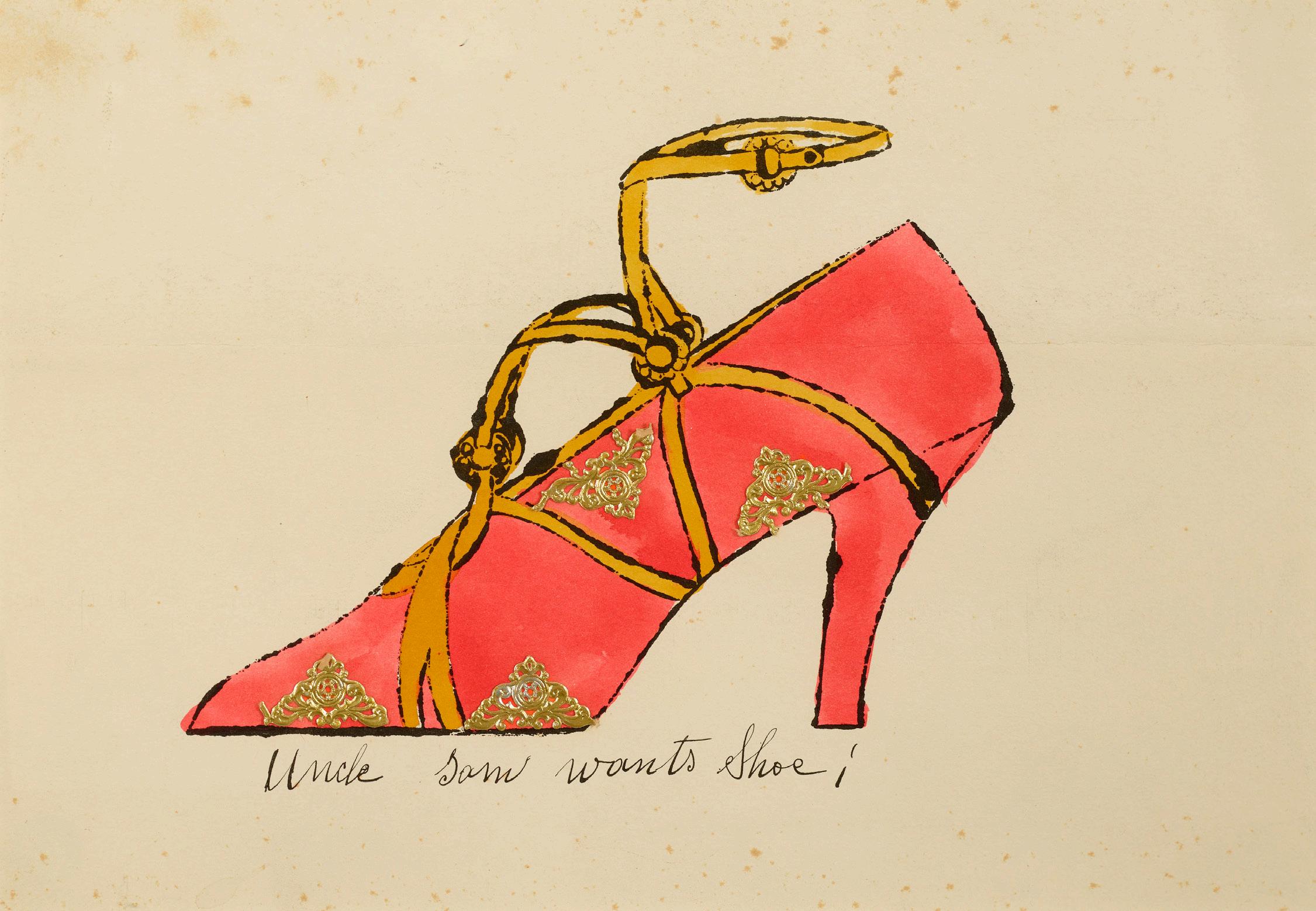
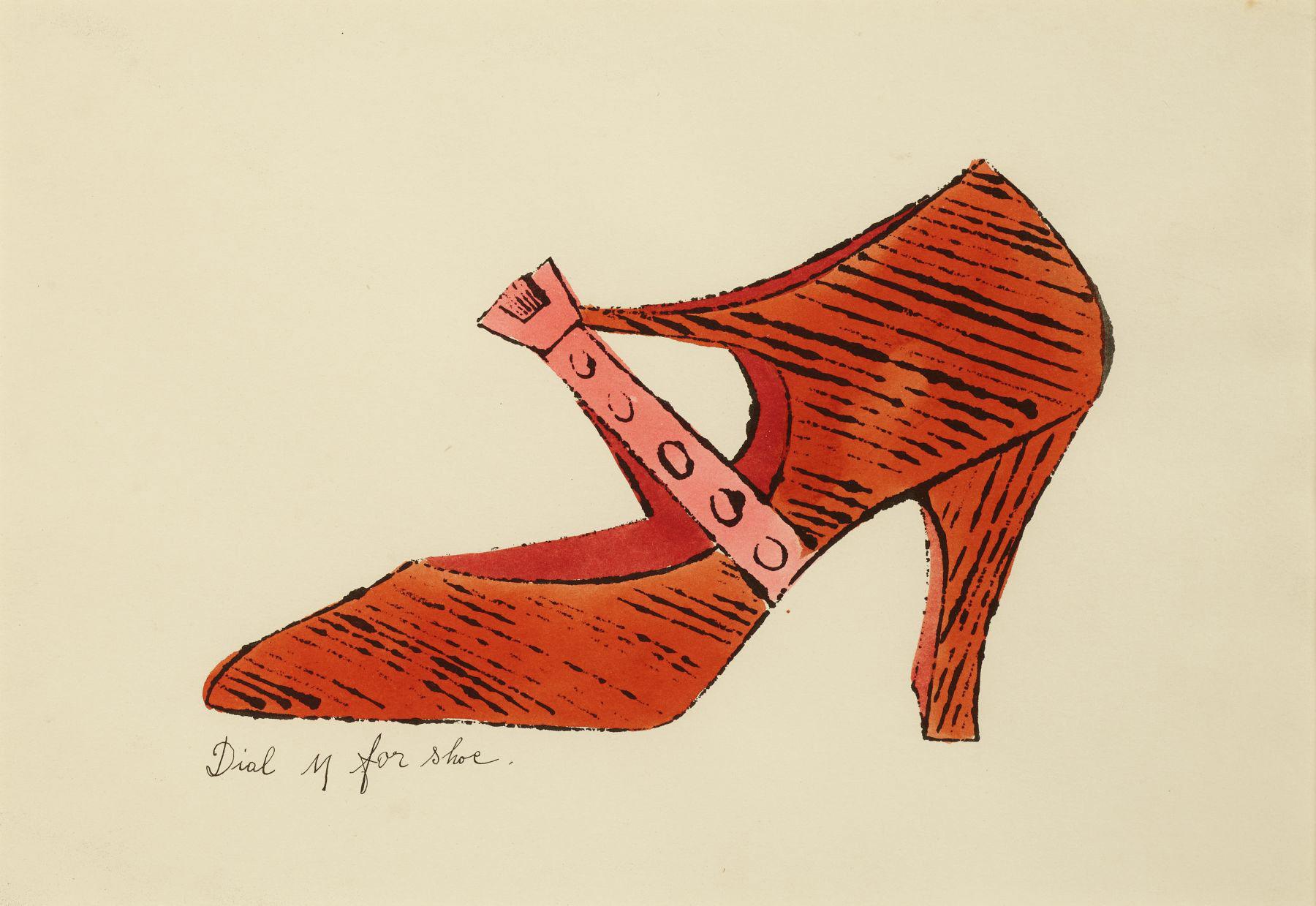
Dial M for Shoe, c. 1955
Hand-colored offset lithograph
Sheet size: 9 3/4 x 13 3/4 inches (24.8 x 34.9 centimeters)
Catalogue Raisonné: Feldman and Schellmann IV.72
From the portfolio À la Recherche du Shoe Perdu
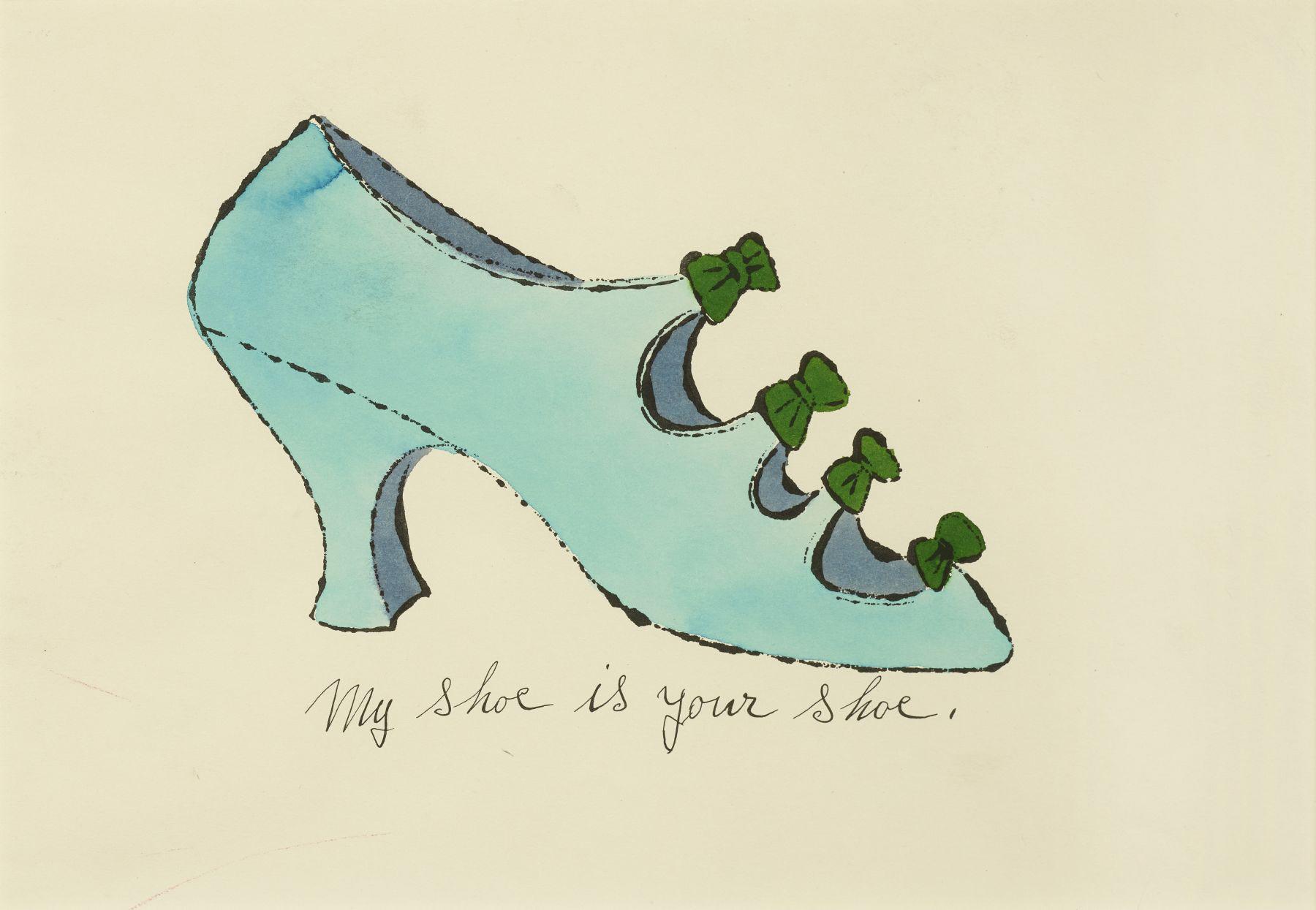
My Shoe is Your Shoe, c. 1955
Hand-colored offset lithograph Sheet size: 9 3/4 x 13 3/4 inches (24.8 x 34.9 centimeters)
Catalogue Raisonné: Feldman and Schellmann IV.70
Stamped on the verso by The Estate of Andy Warhol and The Andy Warhol Foundation
Initialed ‘T.J.H.’ by Tim Hunt of The Andy Warhol Foundation
From the portfolio À la Recherche du Shoe Perdu
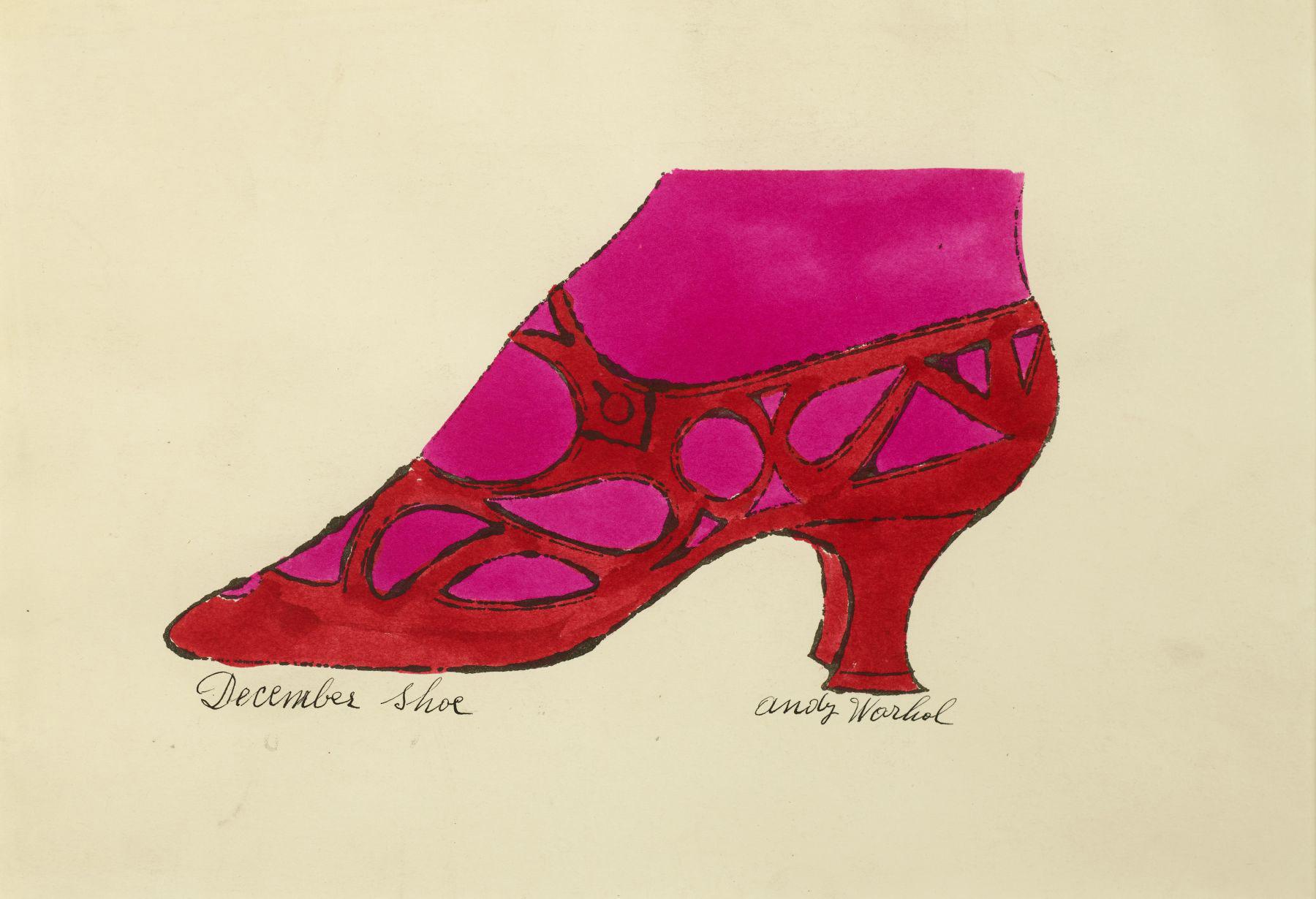
Andy Warhol
December Shoe, c. 1955
Hand-colored offset lithograph with title and signature by hand in ink
Sheet size: 9 7/8 x 14 inches
(25 x 35.6 centimeters)
Catalogue Raisonné: Feldman and Schellmann IV.73
Stamped on the verso by The Estate of Andy Warhol and The Andy Warhol Foundation
Initialed ‘T.J.H.’ by Tim Hunt of The Andy Warhol Foundation
Provenance: The Estate of Andy Warhol
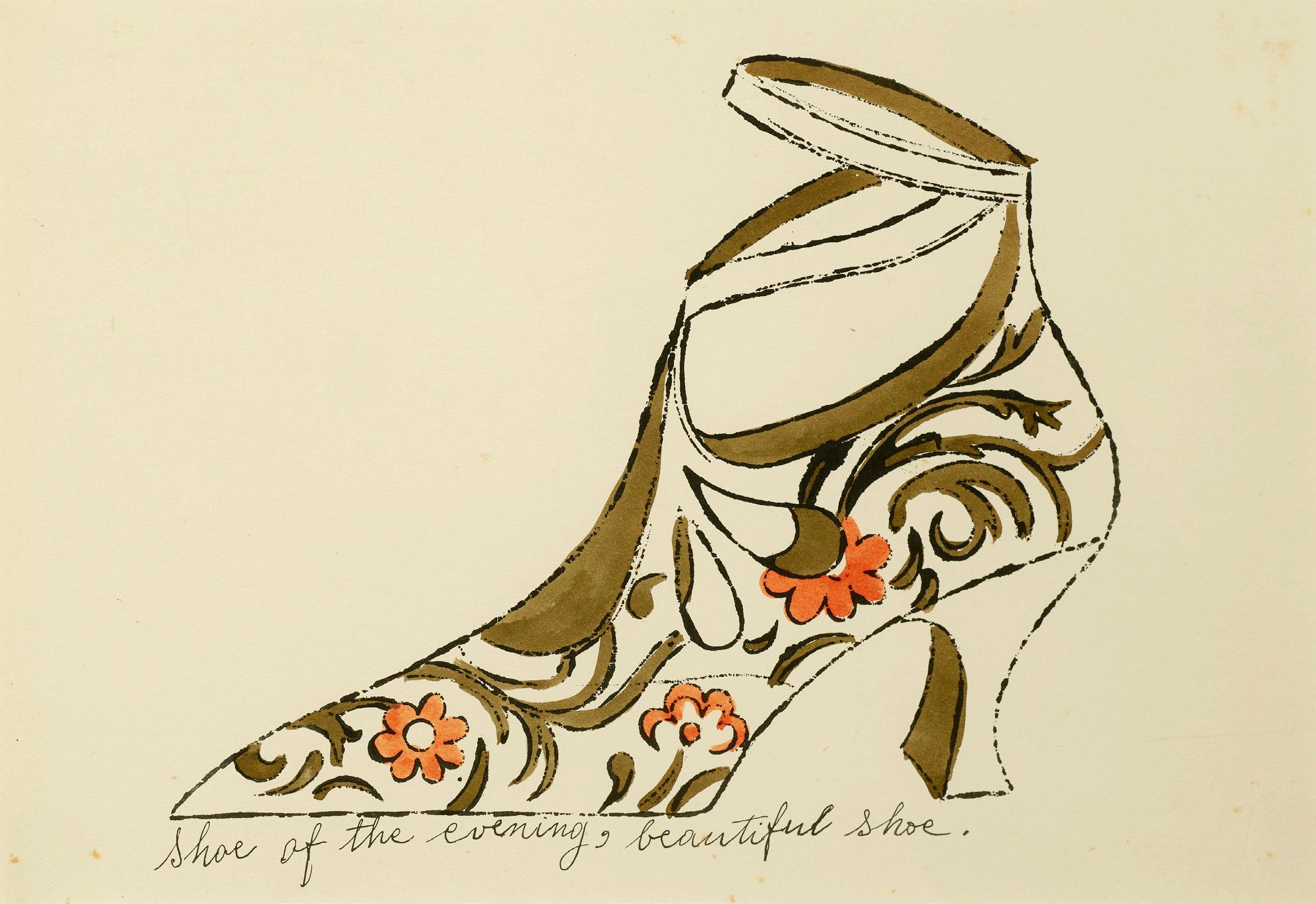
Shoe of the Evening, Beautiful Shoe, c. 1955
Hand-colored offset lithograph
Sheet size: 9 3/4 x 13 3/4 inches (24.8 x 34.9 centimeters)
Catalogue Raisonné: Feldman and Schellmann IV.77
Stamped on the verso by The Estate of Andy Warhol and The Andy Warhol Foundation Initialed ‘VF’ by Vincent Fremont of The Andy Warhol Foundation
Provenance: The Estate of Andy Warhol
Susan Sheehan Gallery, New York American Private Collection

Shoe Bright, Shoe Light, First Shoe I’ve Seen Tonight, c. 1955
Hand-colored offset lithograph
Sheet size: 9 3/4 x 13 3/4 inches
(24.8 x 34.9 centimeters)
Catalogue Raisonné: Feldman and Schellmann IV.82
Stamped on the verso by The Estate of Andy Warhol and The Andy Warhol Foundation Initialed ‘T.J.H.’ by Tim Hunt of The Andy Warhol Foundation
From the portfolio À la Recherche du Shoe Perdu
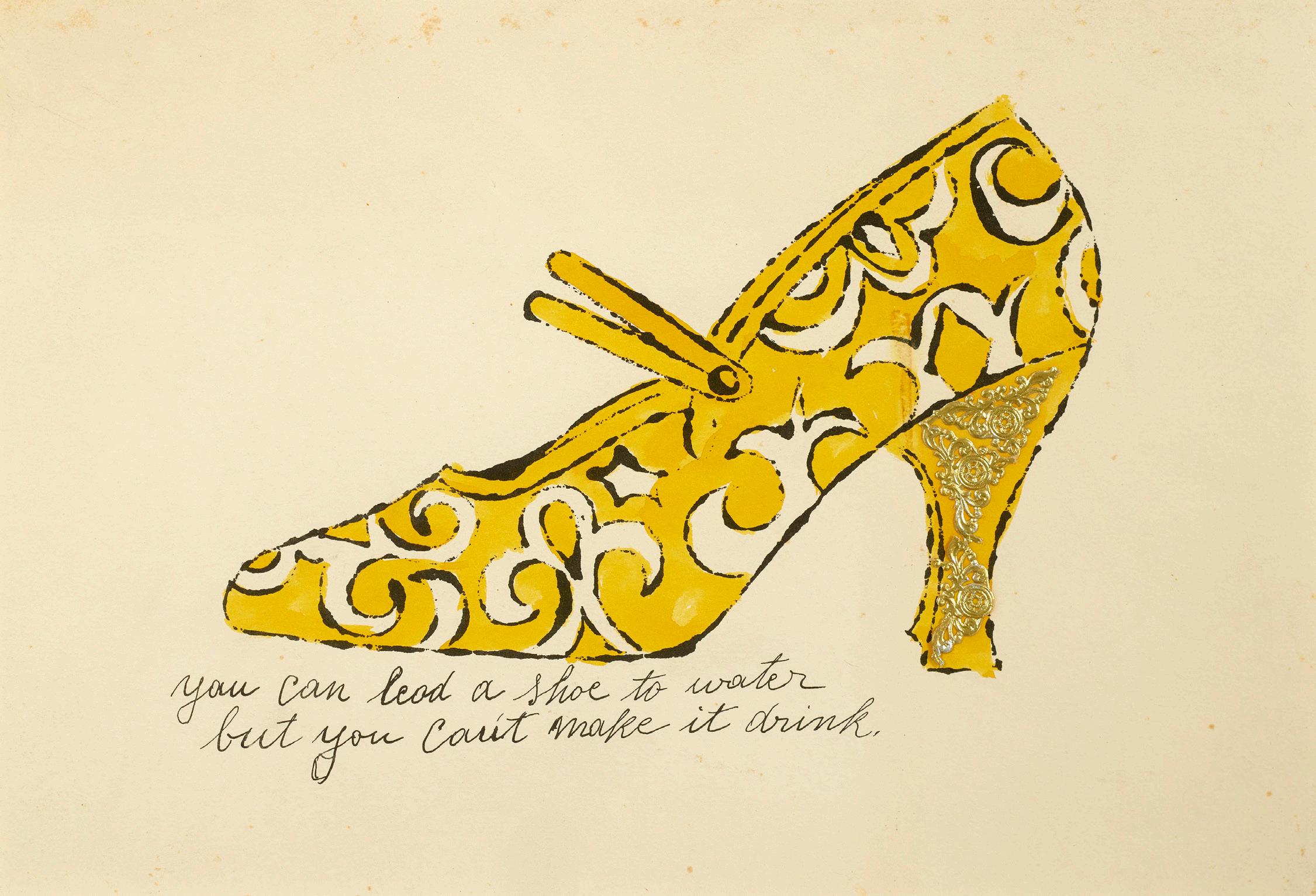
You Can Lead a Shoe to Water but You Can’t Make it Drink, c. 1955
Hand-colored offset lithograph with gold foil collage
Sheet size: 9 3/4 x 13 3/4 inches (24.8 x 34.9 centimeters)
Catalogue Raisonné: Feldman and Schellmann IV.83
Stamped on the verso by The Estate of Andy Warhol and The Andy Warhol Foundation Initialed ‘T.J.H’ by Tim Hunt of The Andy Warhol Foundation
Provenance: The Estate of Andy Warhol Susan Sheehan Gallery, New York American Private Collection
From the portfolio À la Recherche du Shoe Perdu

Louise Bourgeois
He Disappeared Into Complete Silence, 1947 Engravings
Sheet size: 10 x 7 inches, each (25.4 x 17.8 centimeters, each)
Edition size: projected 54, about 20 portfolios extant Catalogue Raisonné: Wye/Smith 29-38
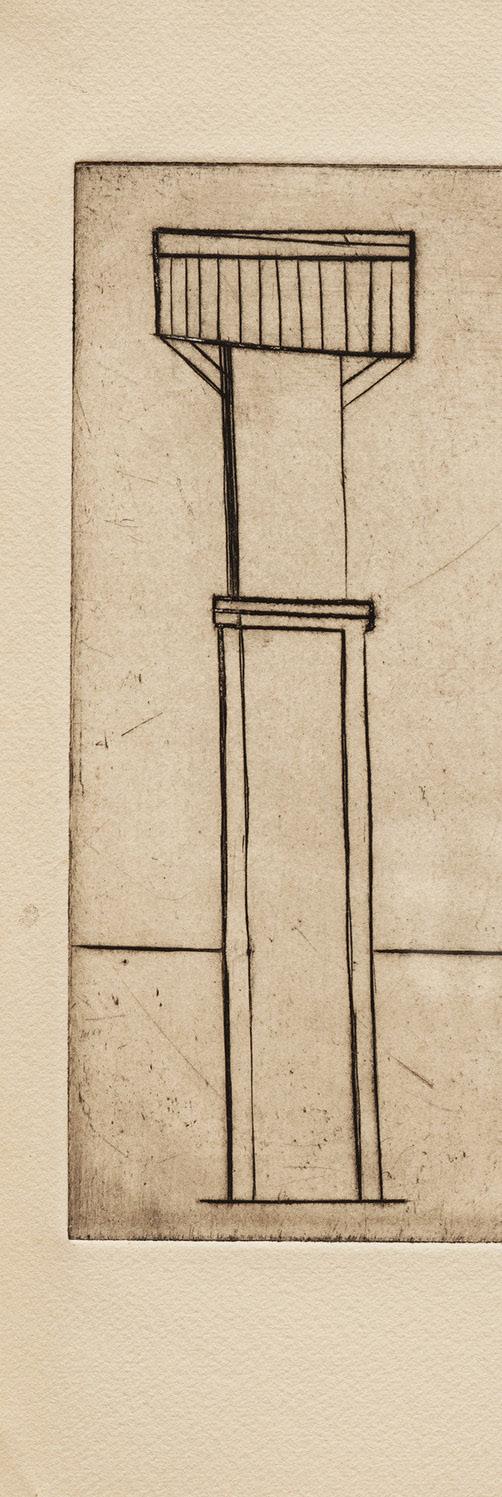
The exceedingly rare portfolio of nine engravings which retains the introduction text by Marius Bewley, text pages by the artist, title page, and justification pages. Lacking the beige linen folder. Our example of this rare set is one of only 20 known examples, some complete and others incomplete, catalogued by the artist’s foundation. This set is numbered 22 on the colophon.

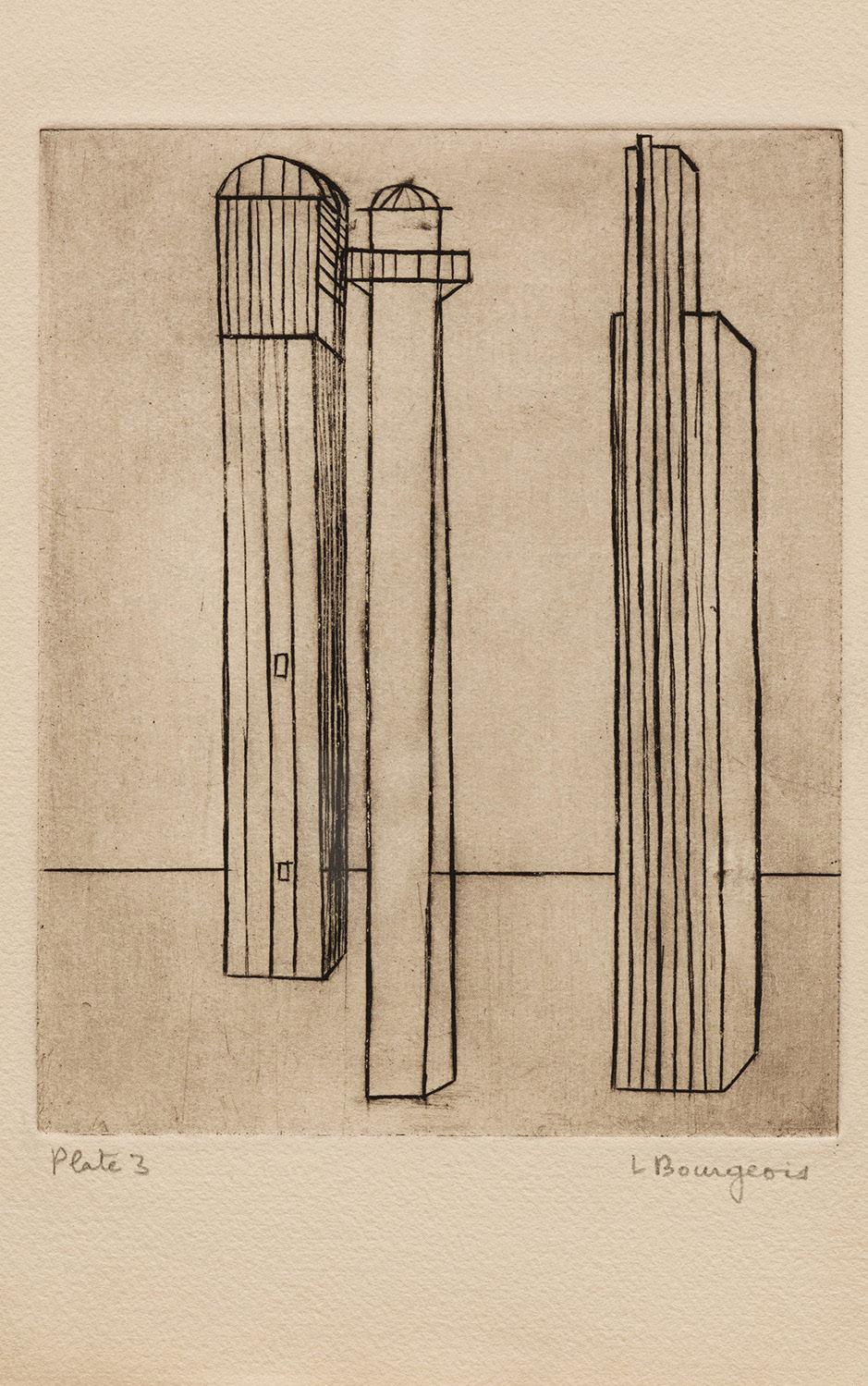


This early rare portfolio was originally intended to be published in an edition of 54. According to records kept at The Easton Foundation (established by the artist), the edition was never completed and about 20 sets are currently accounted for. Of these sets, 10 are “vintage” examples, or sets that were assembled at the time of publication. The additional 10 sets are “assembled” examples, or sets that were assembled by the artist and given away or sold. The foundation’s records indicate that both vintage and assembled sets vary by whether they include all of the portfolio components (the engravings, the text pages, the linen-cover, and the introduction). Set-by-set variations also include which state of any one of the images was chosen. The prints themselves sometimes have a variety of annotations on them, and some are signed, some not. There are variations in the paper and in the typeset of the text, some also have hand drawn corrections on some of the text pages. Essentially each of these sets is unique and do not have the same precise compositional exactitude as many formally published artist’s book portfolios.


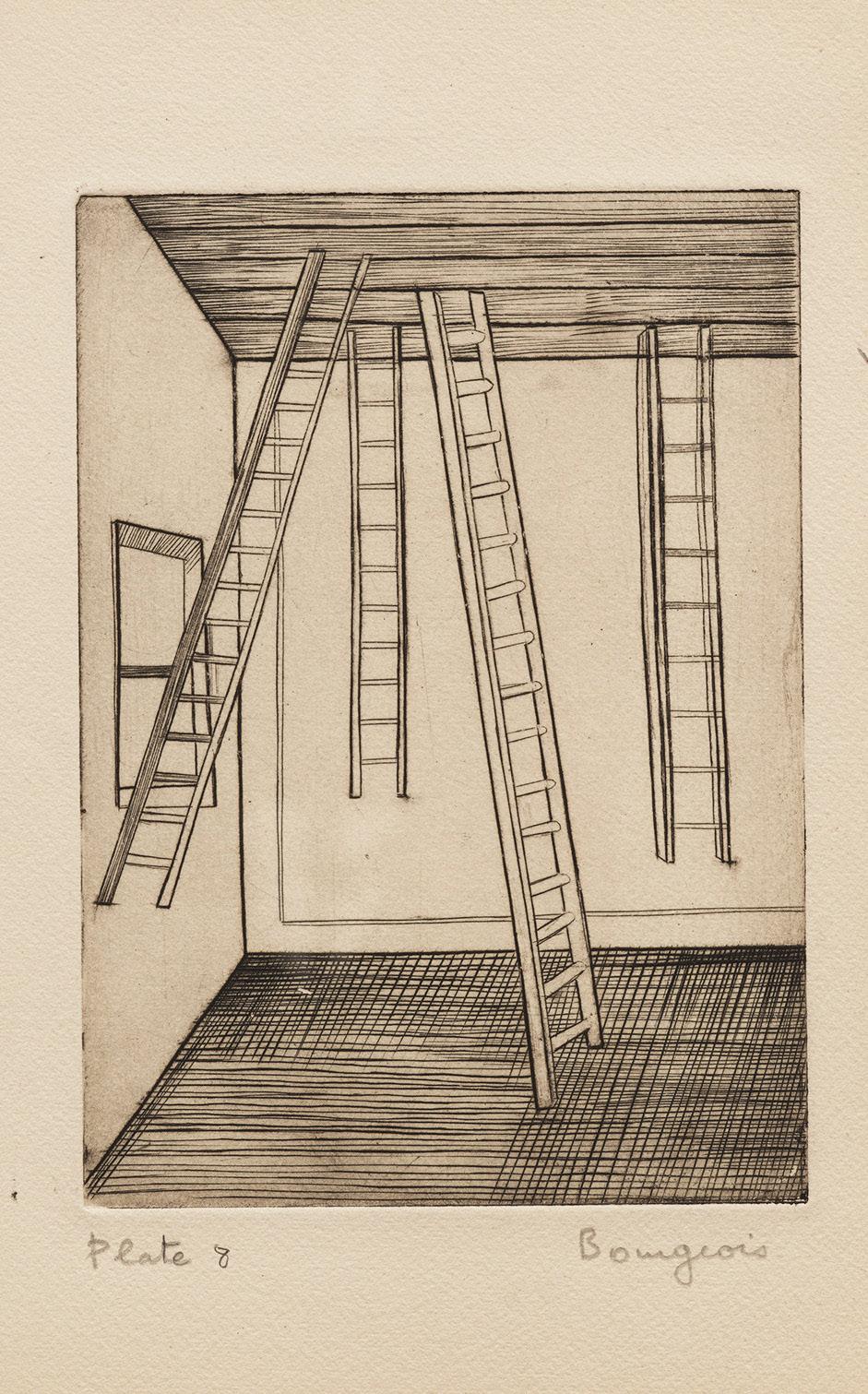

Vintage sets of this portfolio are held in the permanent collections of Beinecke Rare Book and Manuscript Library, Yale University, the Biblioteca Nazionale Centrale di Firenze, Florence, the Louise Bourgeois Trust, New York, The Museum of Modern Art, New York, and the National Gallery of Art, Washington D.C..
Assembled sets of this portfolio are held in the permanent collections of the Bibliothèque Nationale de France, the British Museum, the National Gallery of Australia, and the Toledo Museum of Art.


Richard Diebenkorn
Green, 1986
Aquatint and drypoint
Sheet size: 53 1/2 x 40 5/8 inches (135.9 x 103.2 centimeters)
Printer and Publisher: Crown Point Press, San Francisco
Edition size: 60, plus proofs
Catalogue Raisonné: Liguori 294
Initialed, dated, and numbered
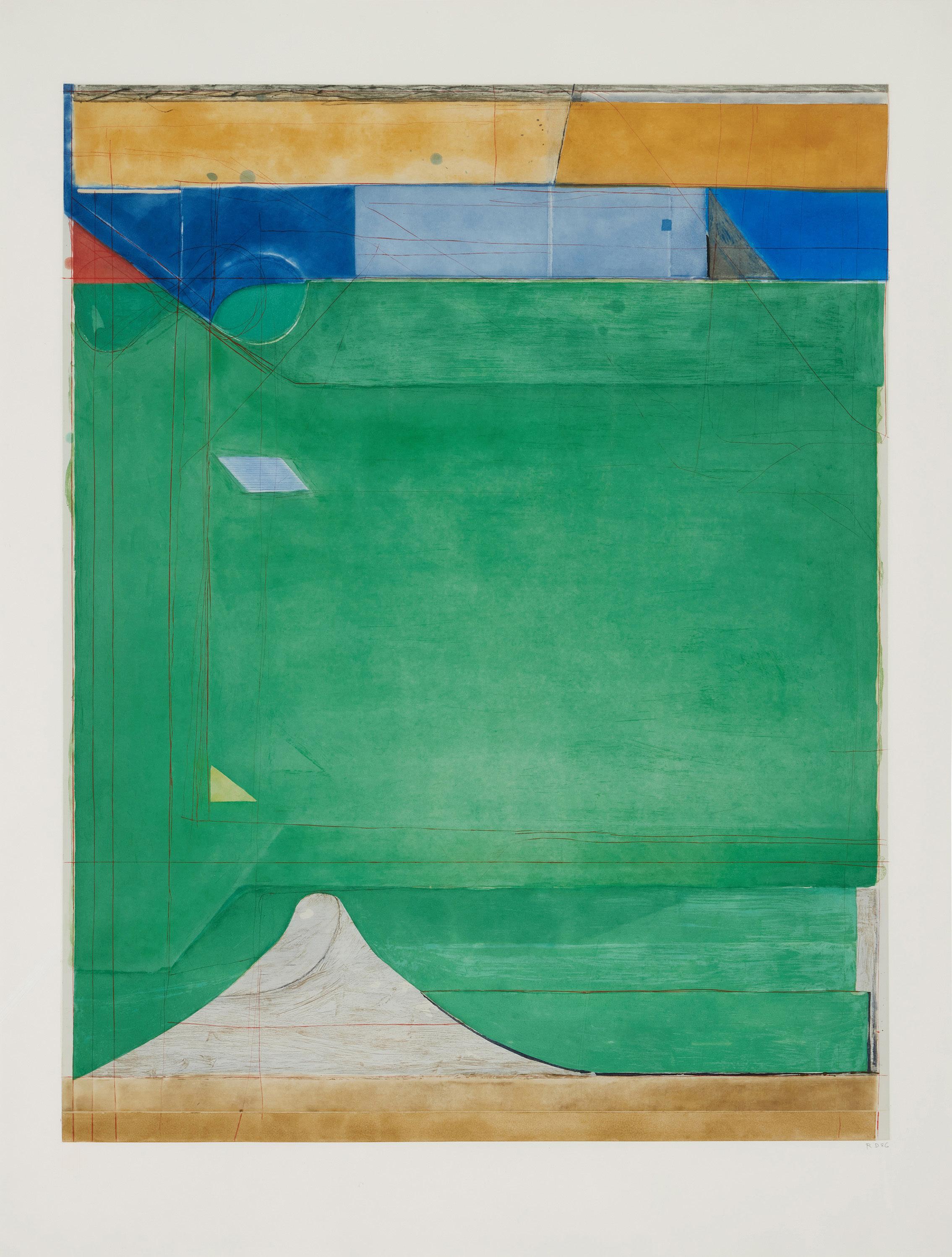
Richard Diebenkorn
High Green Version I, 1992
Aquatint, etching, and drypoint
Sheet size: 52 3/4 x 33 3/4 inches (134 x 85.7 centimeters)
Printer and Publisher: Crown Point Press, San Francisco
Edition size: 65, plus proofs
Catalogue Raisonné: Liguori 345
Initialed, dated, and numbered
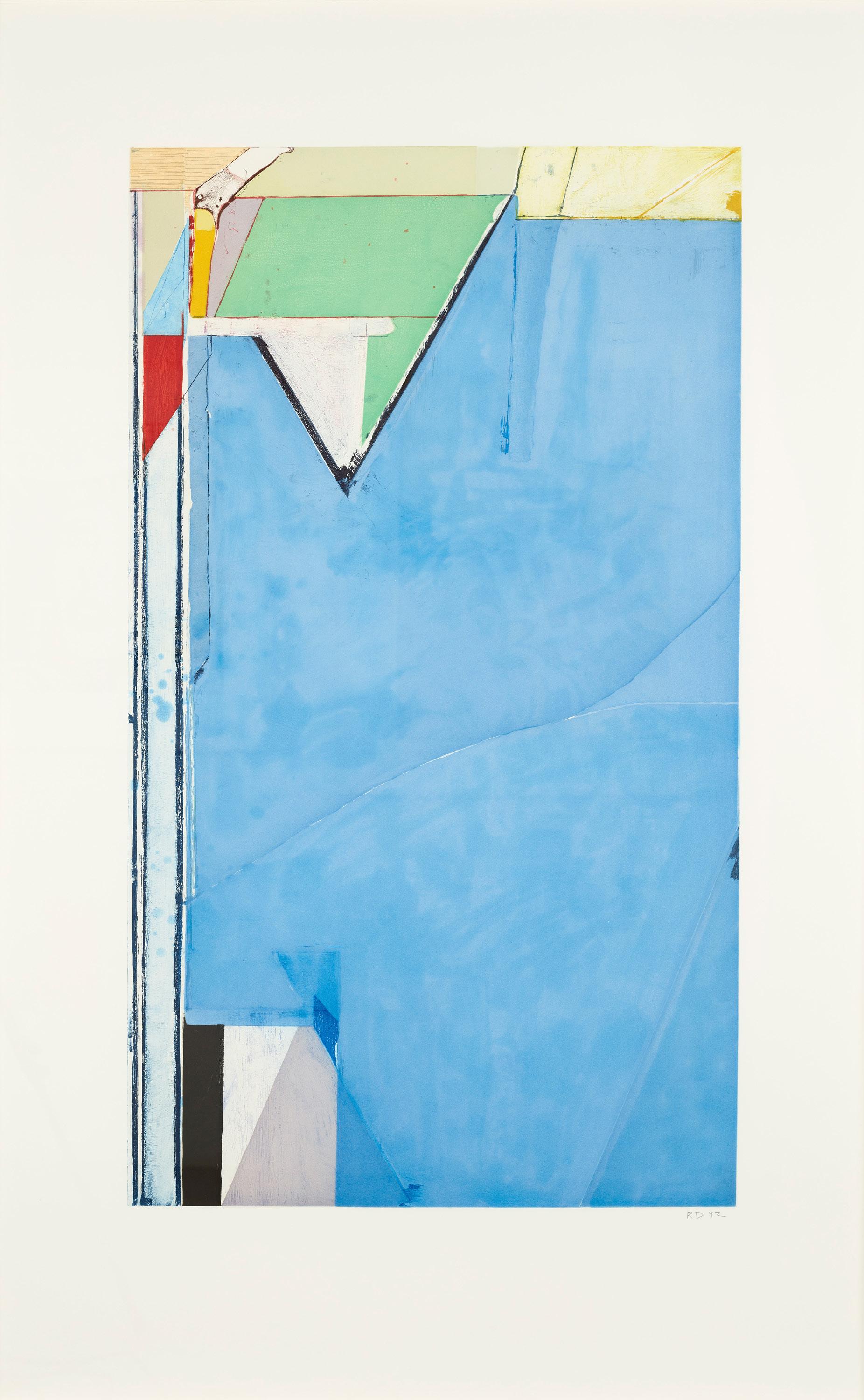
Richard Diebenkorn
Ochre, 1983
Sheet size: 27 1/4 x 38 1/8 inches
(69.2 x 96.8 centimeters)
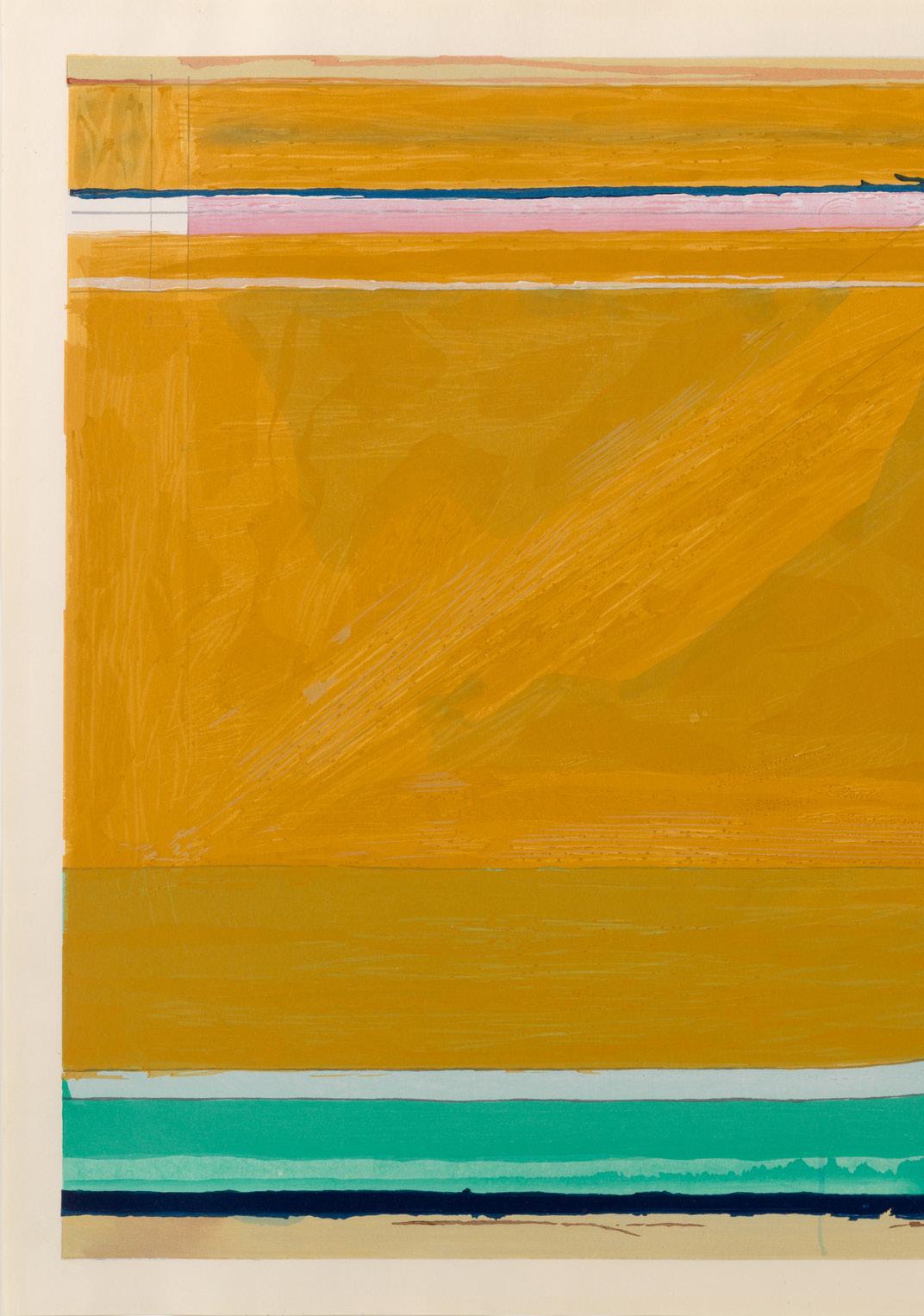
Printer: Tadashi Toda, Shi Un Do Print Shop, Kyoto, Japan
Publisher: Crown Point Press, San Francisco
Edition size: 200, plus proofs
Catalogue Raisonné: Liguori 288
Initialed, dated, and editioned
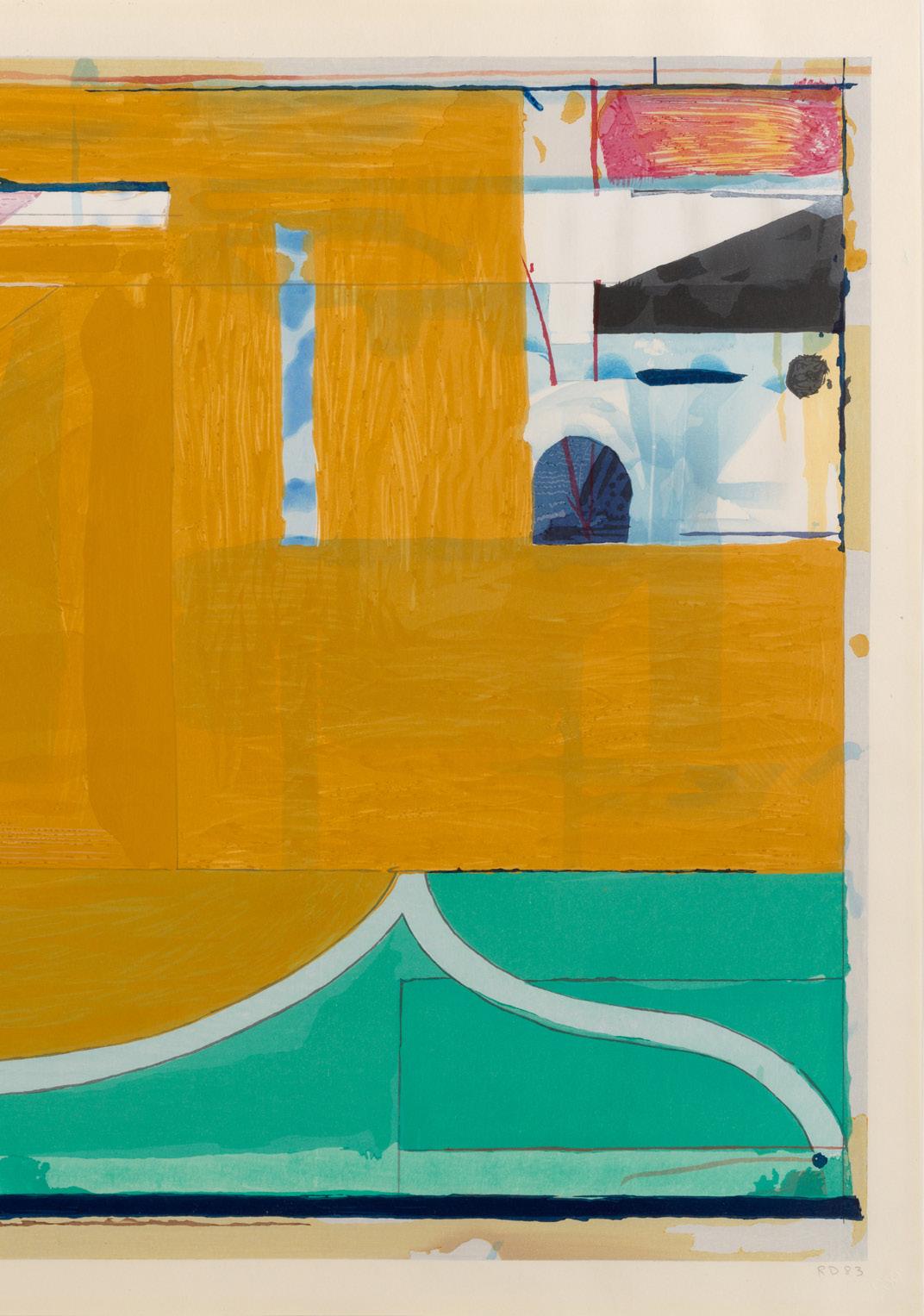
Small Thin, 1980
Aquatint and etching
Sheet size: 26 1/4 x 14 1/4 inches (66.7 x 36.2 centimeters)
Printer and Publisher: Crown Point Press, San Francisco
Edition size: 35, plus proofs
Catalogue Raisonné: Liguori 265
Initialed, dated, and editioned
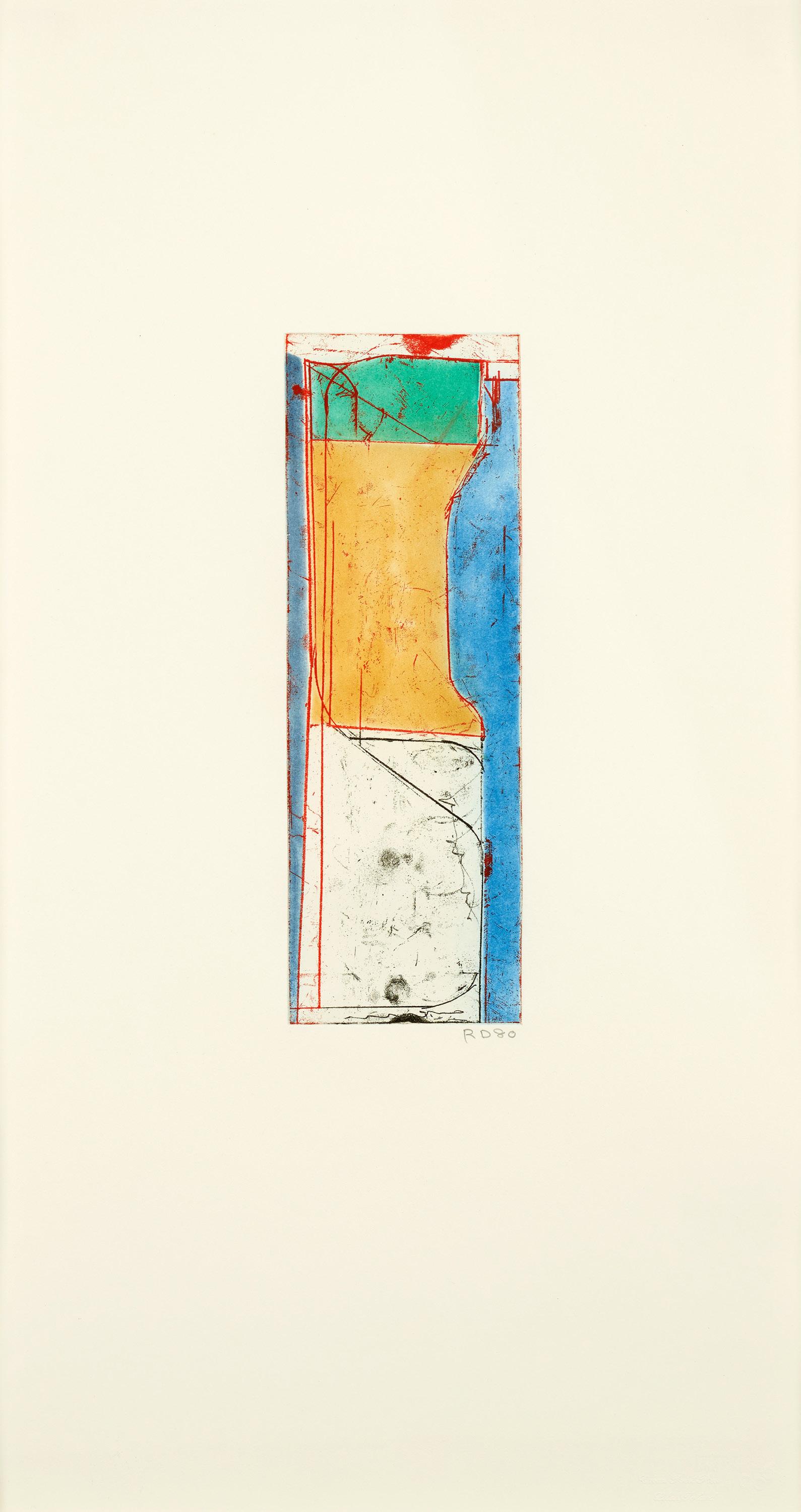
Essence Mulberry, 1977
Sheet size: 39 1/2 x 18 1/2 inches (100.3 x 47 centimeters)
Printer and Publisher: Tyler Graphics Ltd., Bedford, New York
Catalogue Raisonné: Abrams 57
Edition size: 46, plus proofs
Signed, dated, and numbered

Untitled from Quatre Lithographies, 1986
Lithograph
Sheet size: 28 1/4 x 24 5/8 inches (71.8 x 62.6 centimeters)
Printer: Art Estampe, Paris
Publisher: Éditions de la Différence, Paris
Edition size: 100, plus proofs
Signed, dated, and numbered

Ed
Ruscha
City, 1969
Lithograph
Sheet size: 17 x 24 inches
(43.2 x 61 centimeters)
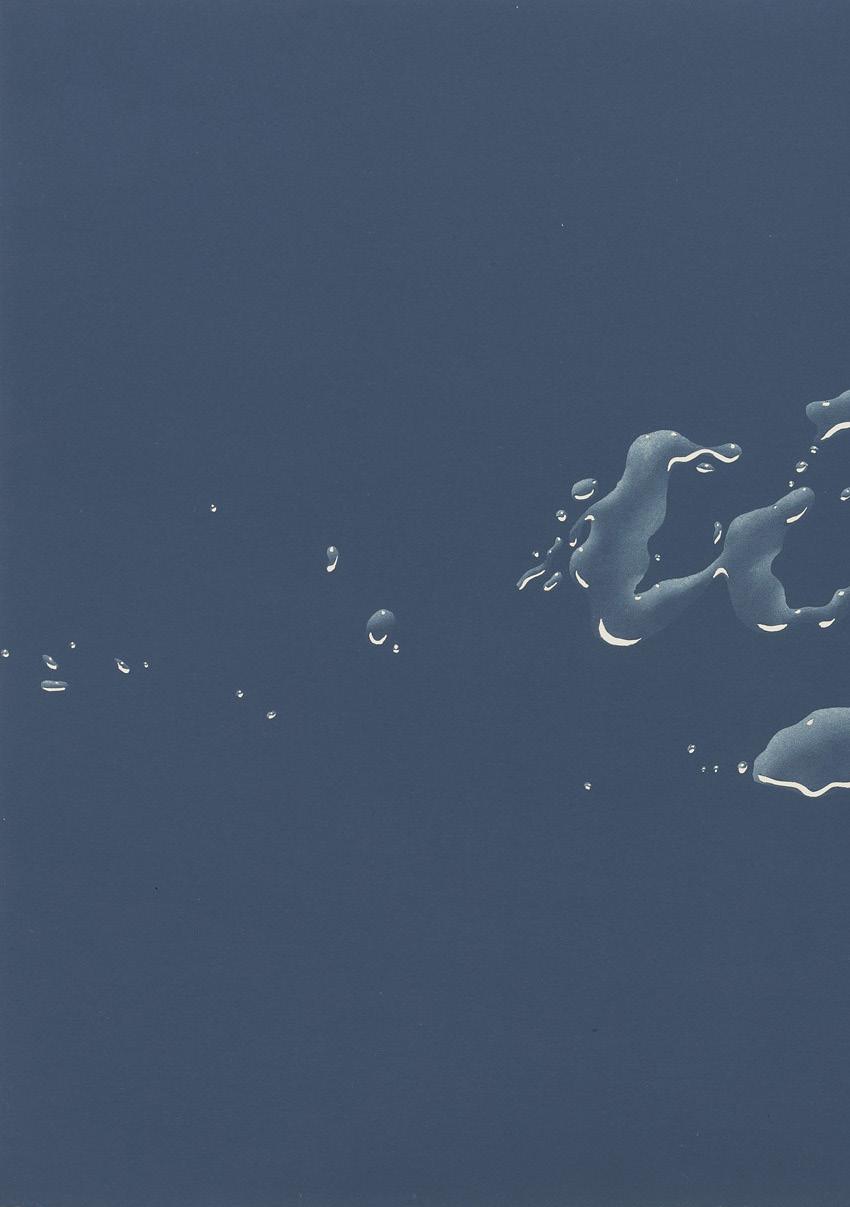
Printer and Publisher: Tamarind Lithography Workshop, Los Angeles
Edition size: 20, plus proofs
Catalogue Raisonné: Engberg 19
Signed, dated, and editioned
Provenance:
Robert Rogers, printer at Tamarind Lithography Workshop, Los Angeles
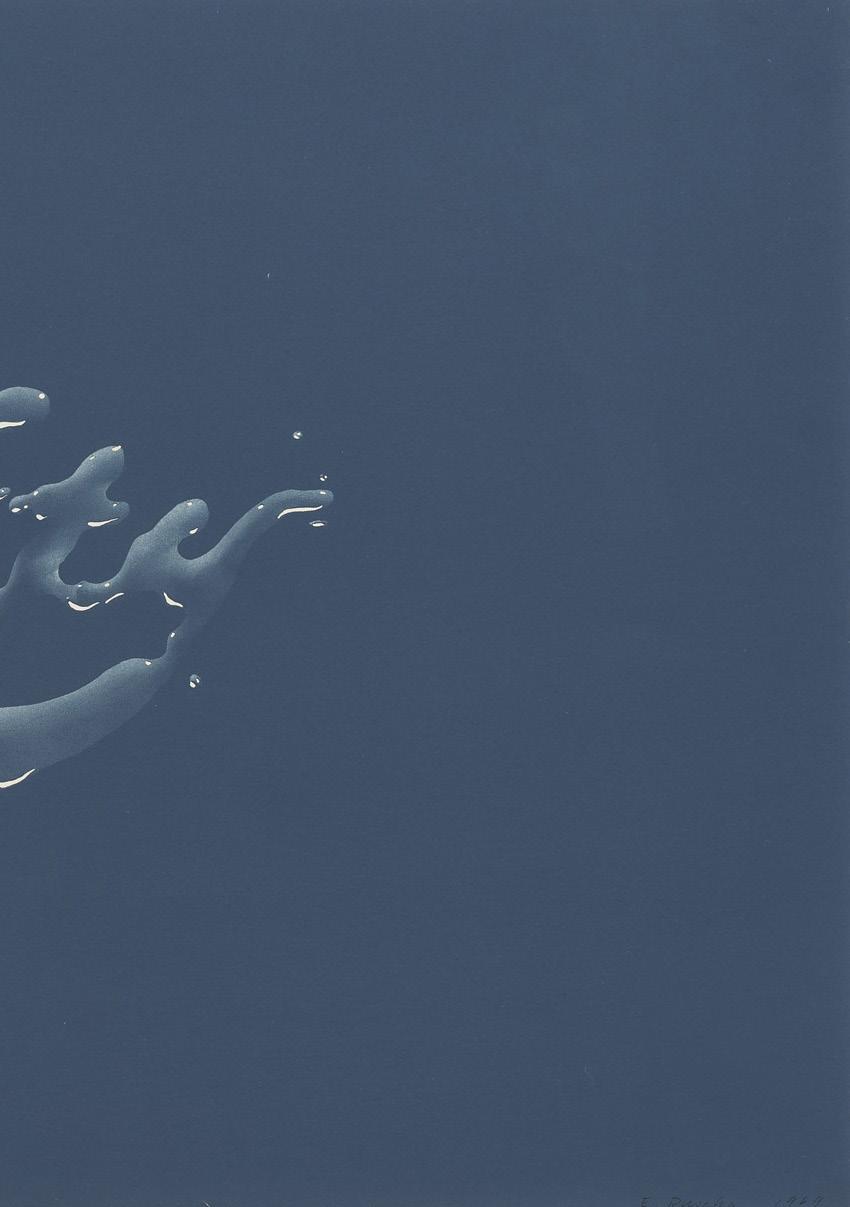
Ed Ruscha
1984, 1967
Lithograph with hand-coloring
Sheet size: 20 x 25 inches
(50.8 x 63.5 centimeters)

Printer and Publisher: Gemini G.E.L., Los Angeles
Edition size: 60, plus proofs
Catalogue Raisonné: Engberg 6
Signed, dated, and numbered
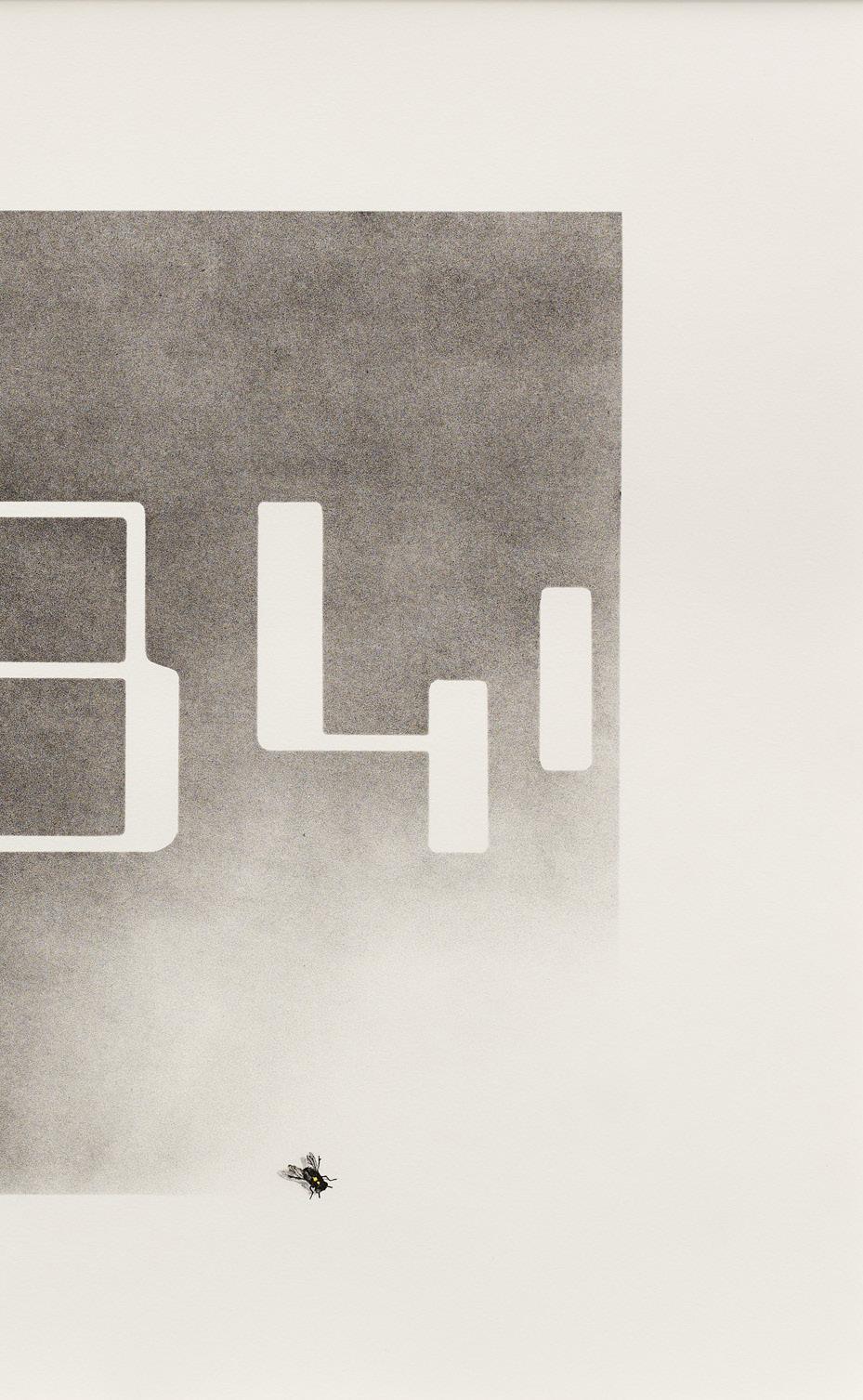
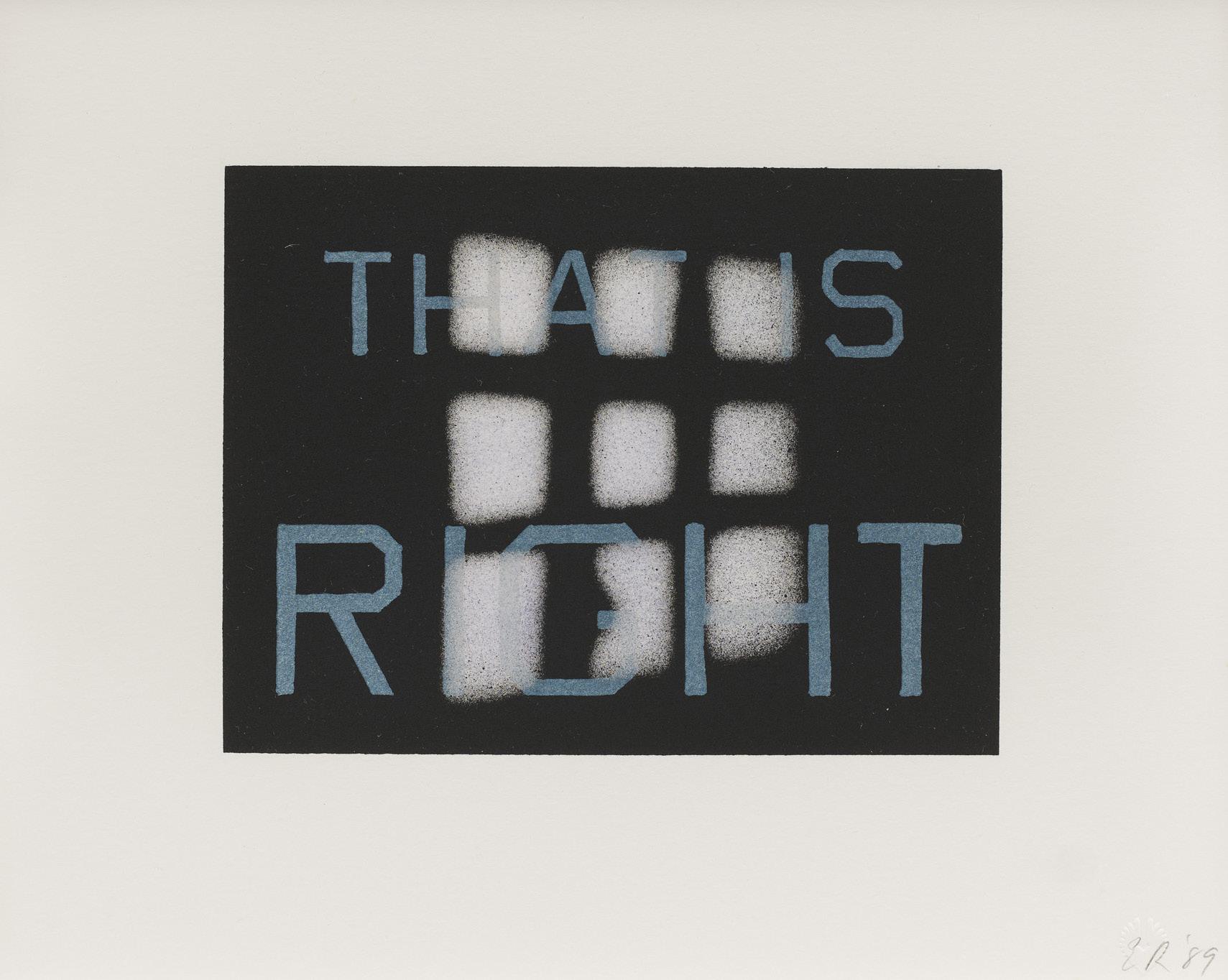
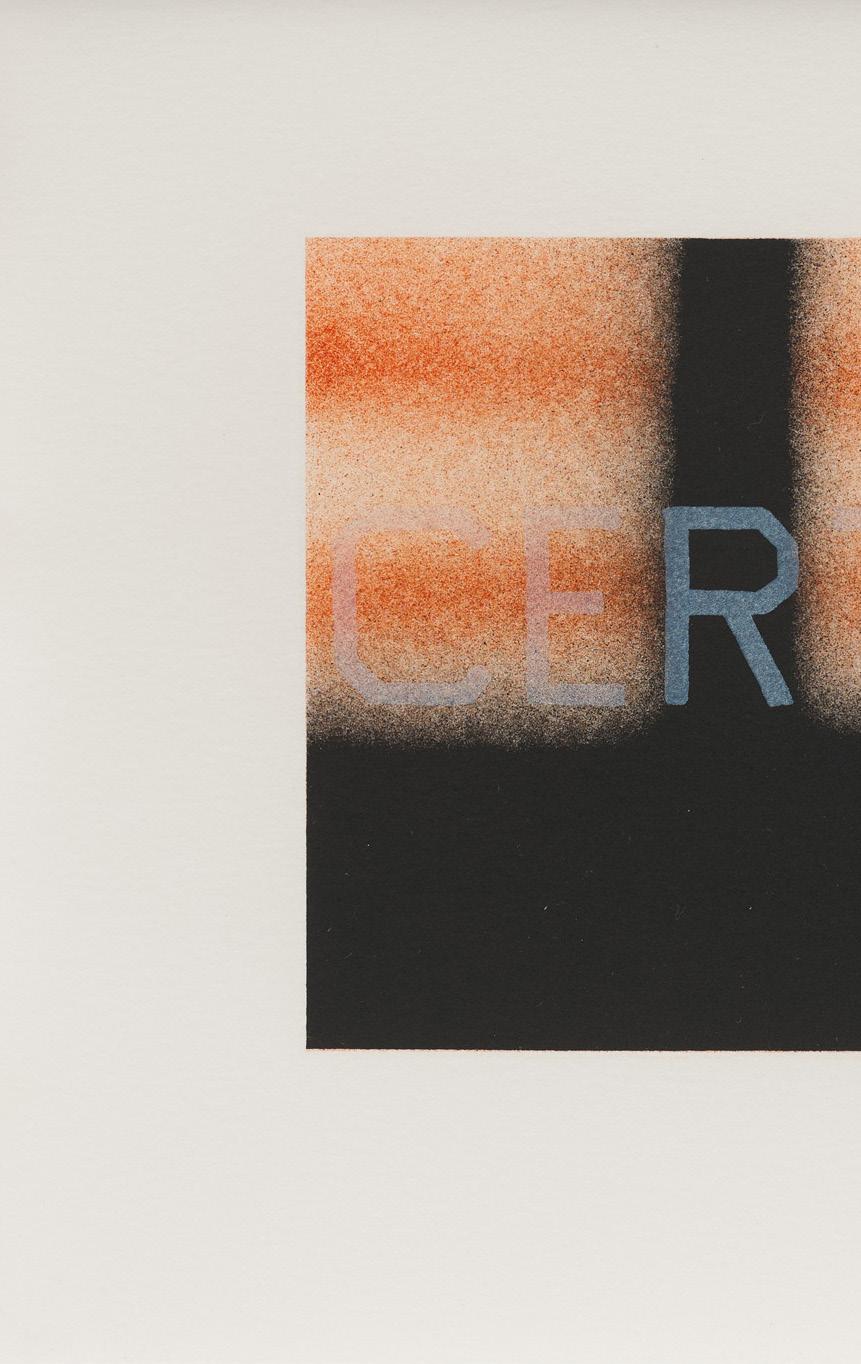

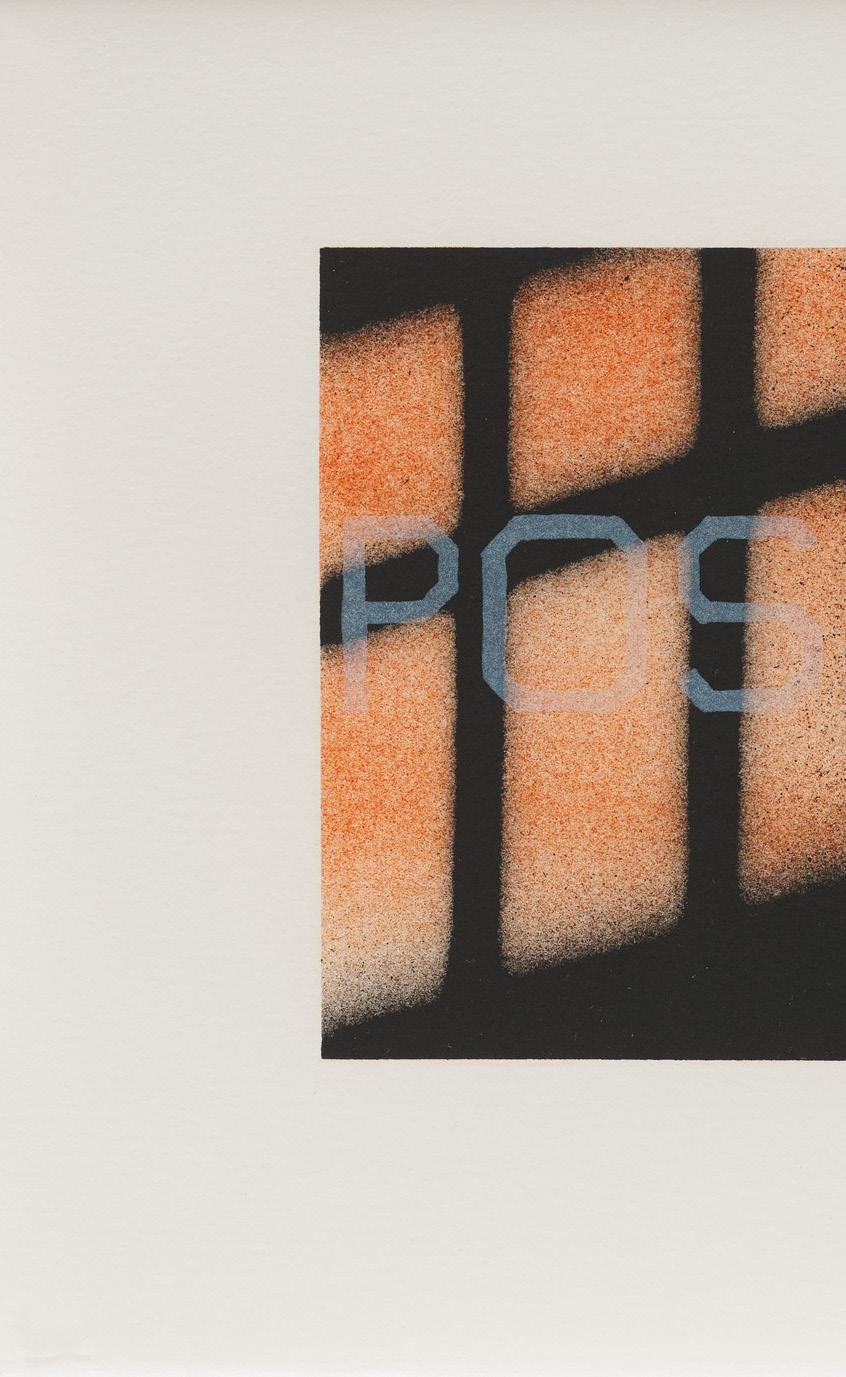
Ed Ruscha
That is Right, 1989
Lithographs
Sheet size: 9 1/8 x 11 inches, each
(23.2 x 27.9 centimeters, each)
Printer: Ed Hamilton, Hamilton Press, Venice, California
Publisher: The Artist
Edition size: 30, plus proofs
Catalogue Raisonné: Engberg 173-184
Each print is initialed, dated, and numbered
The complete portfolio of twelve lithographs
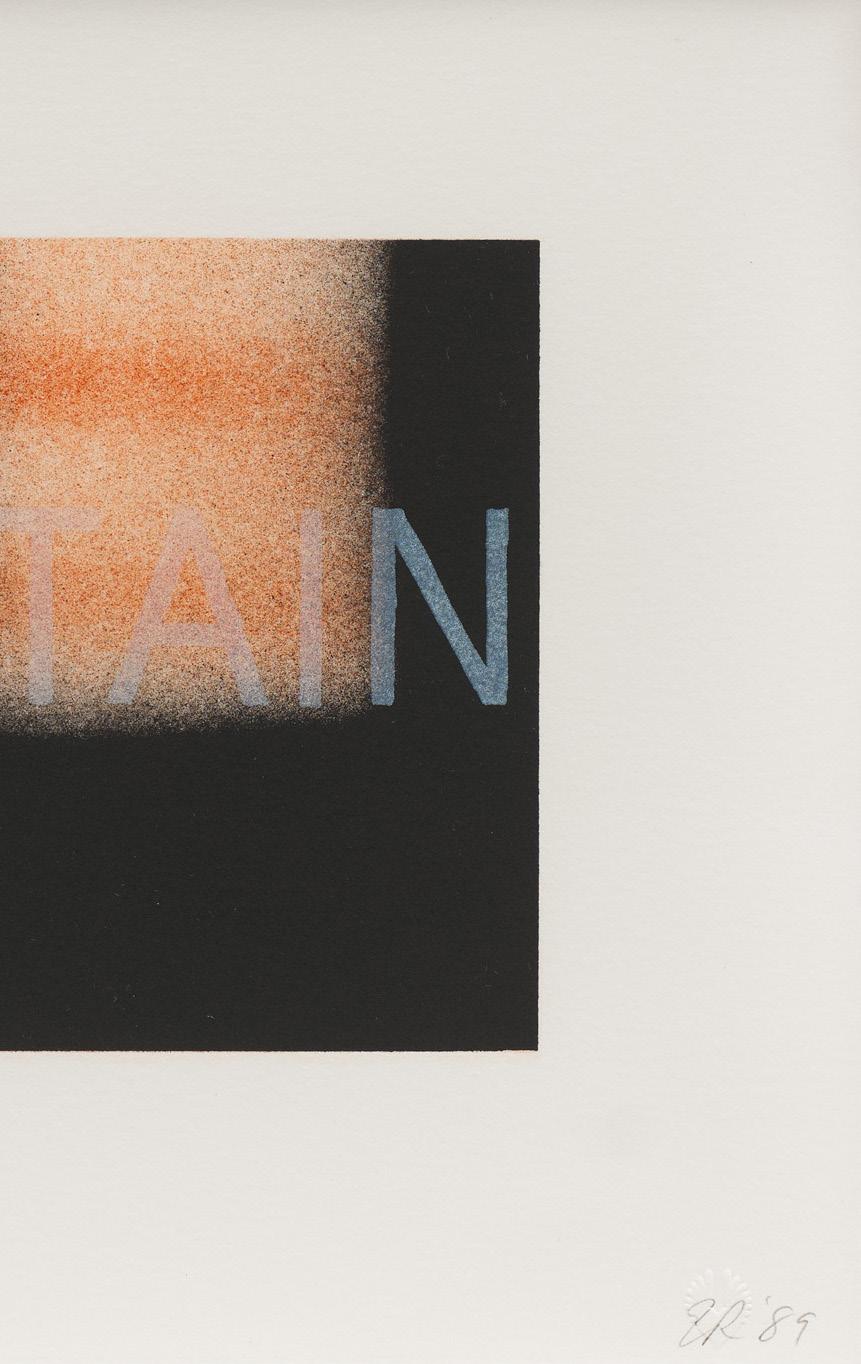

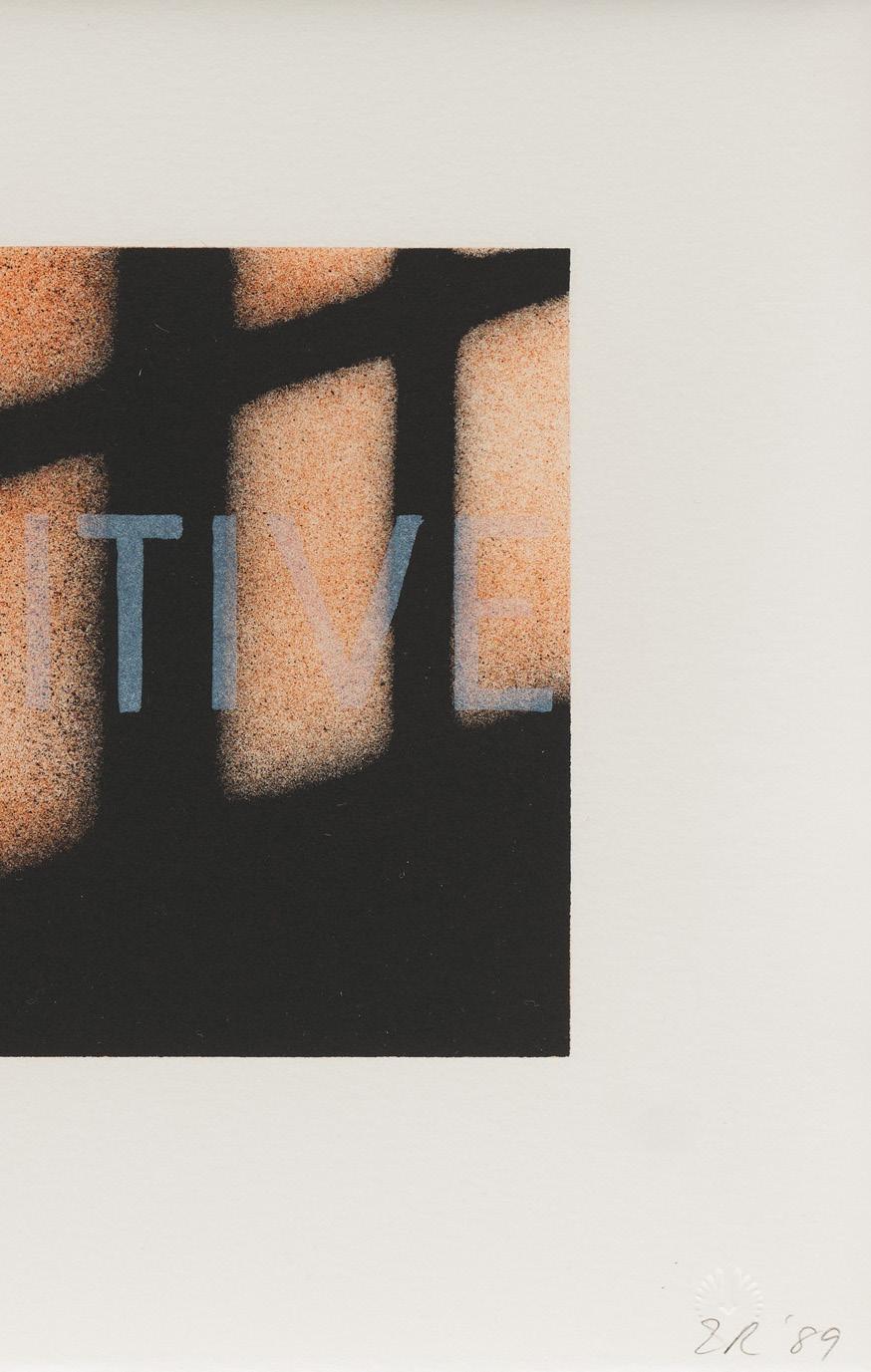
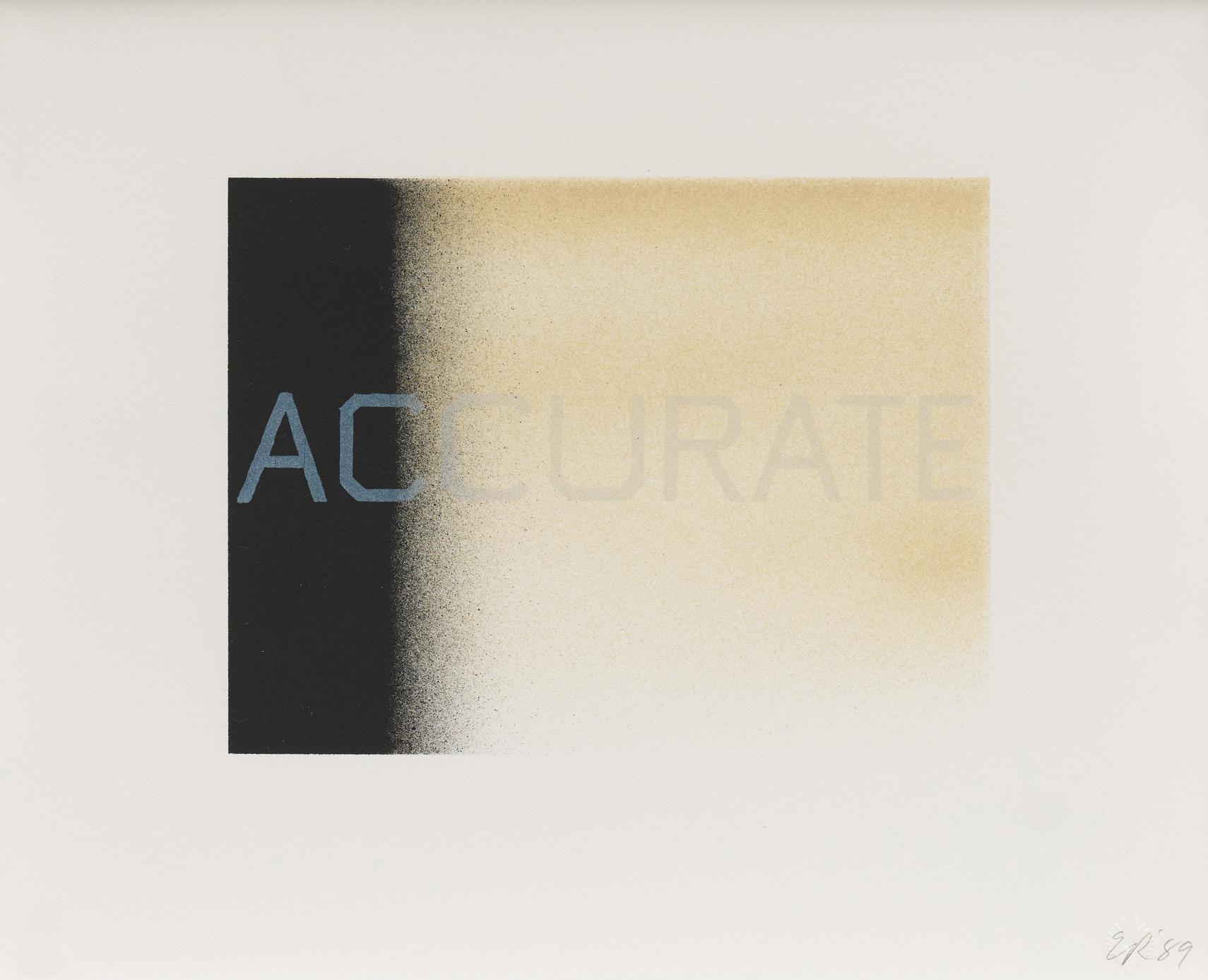
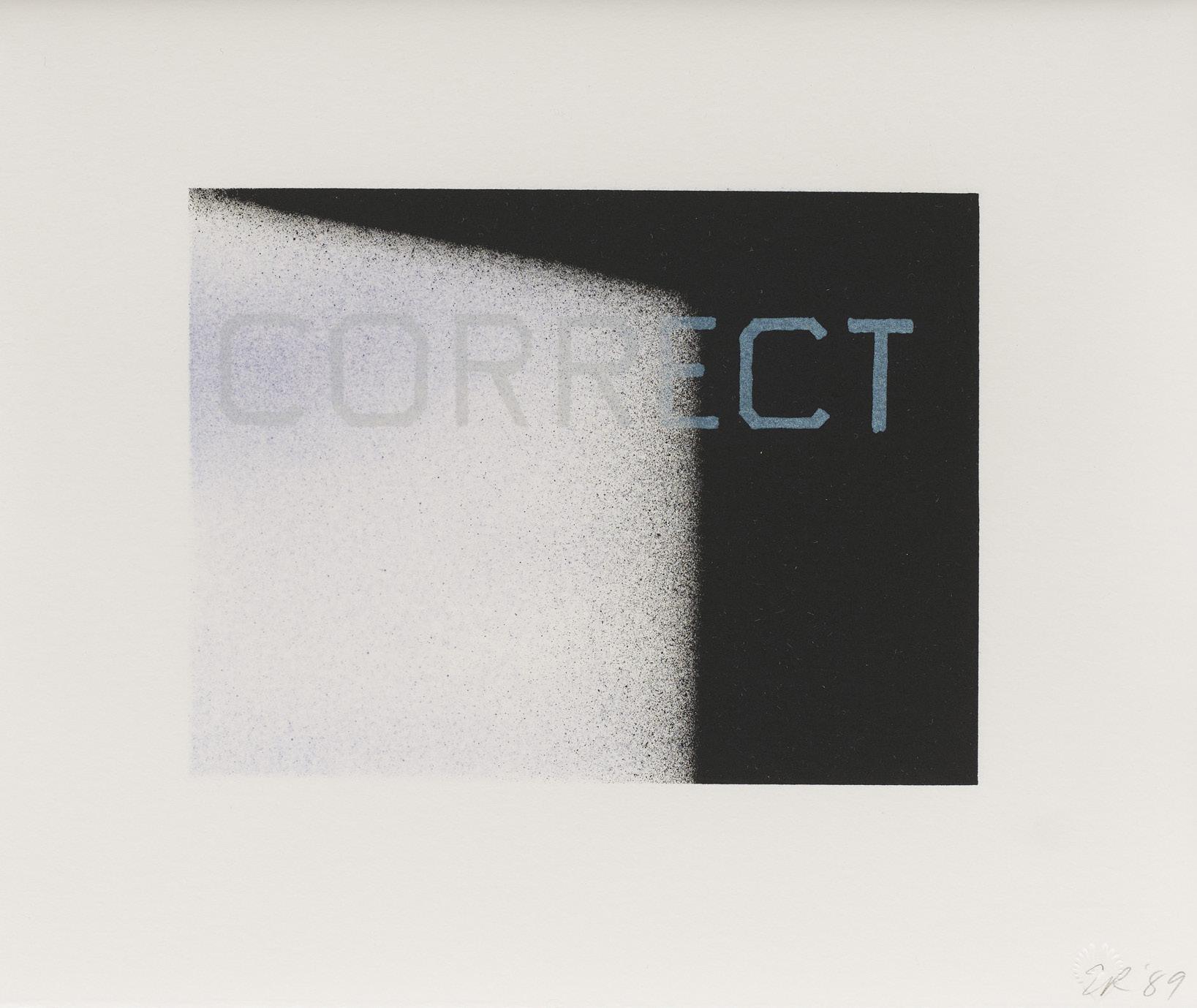

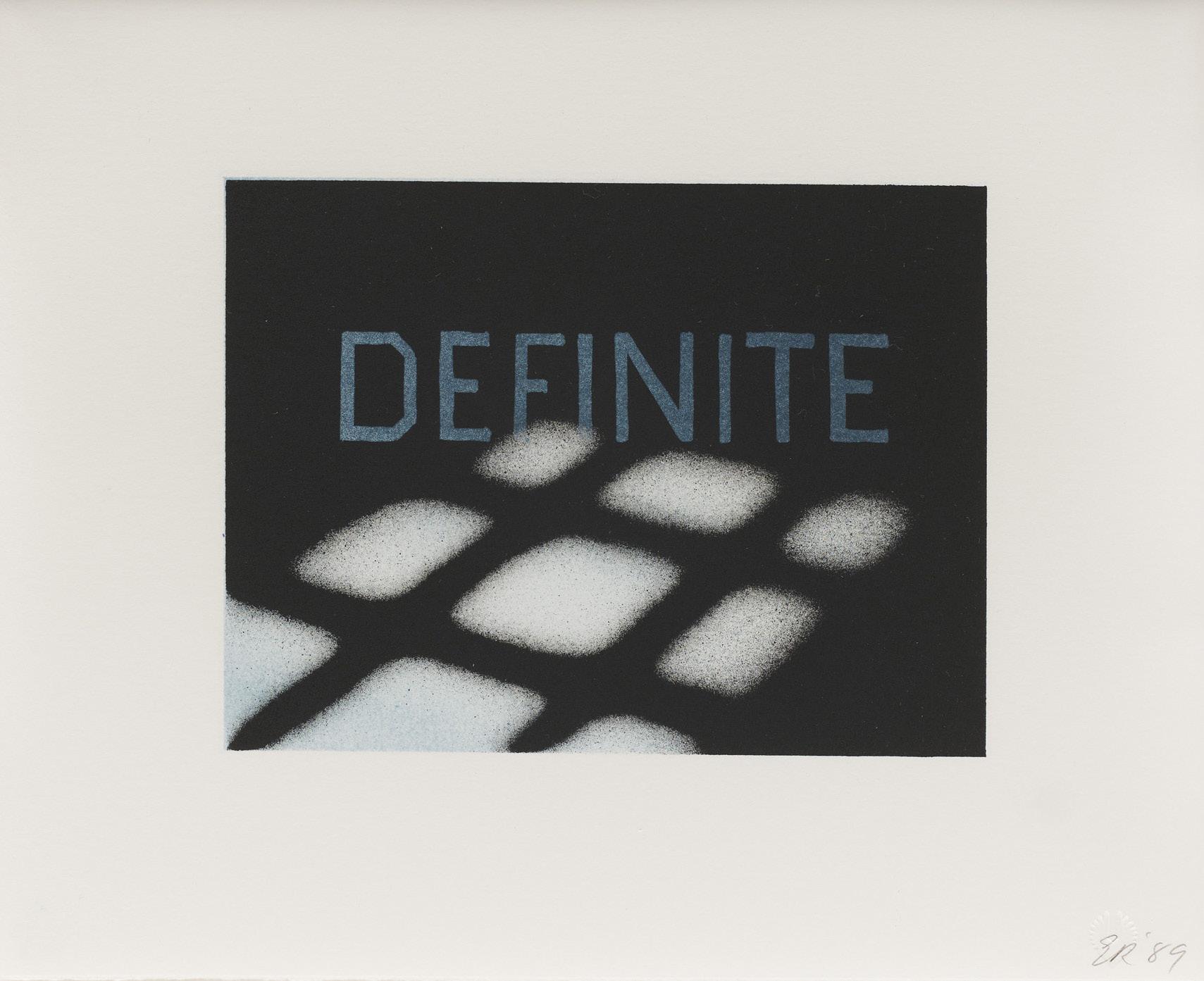

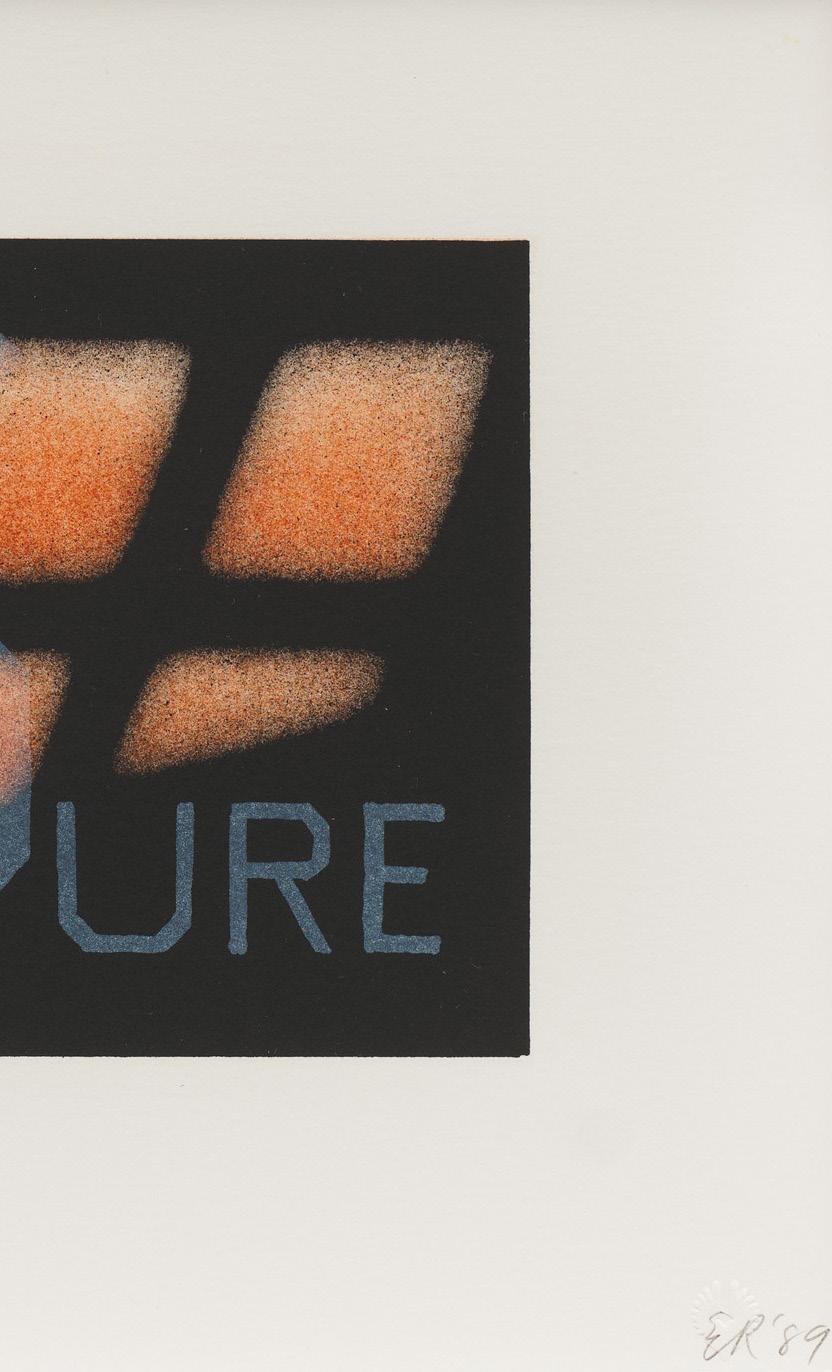
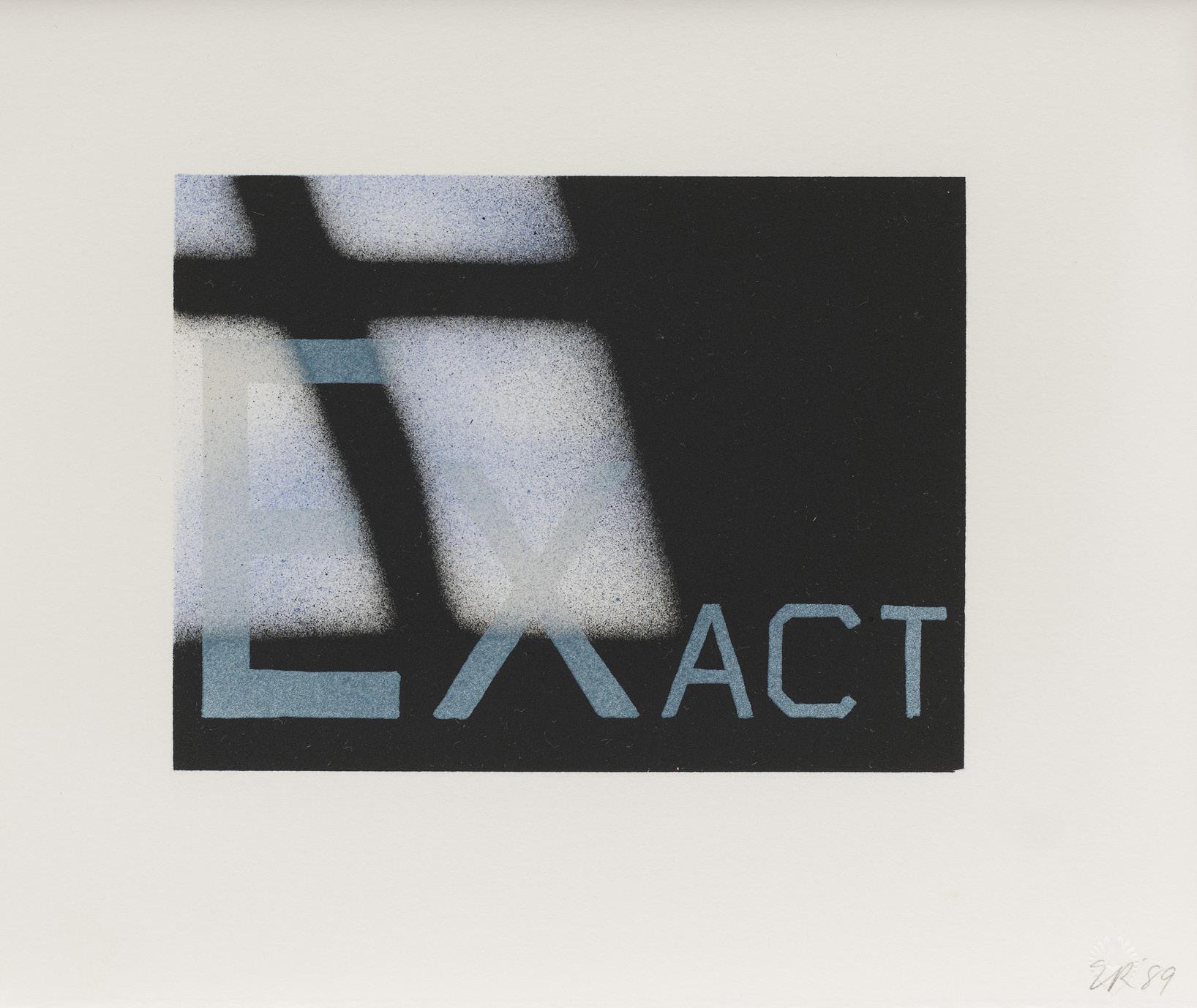
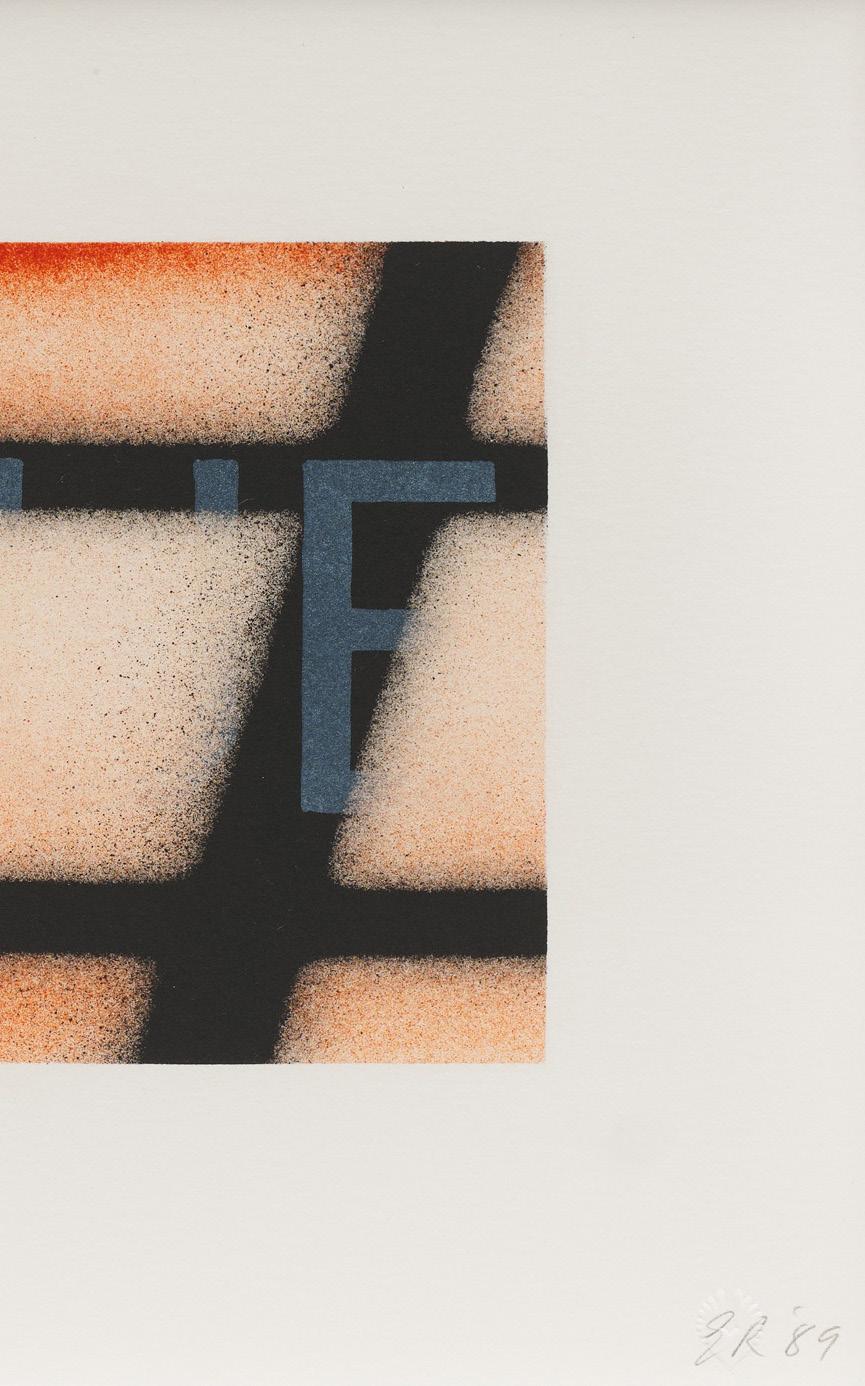
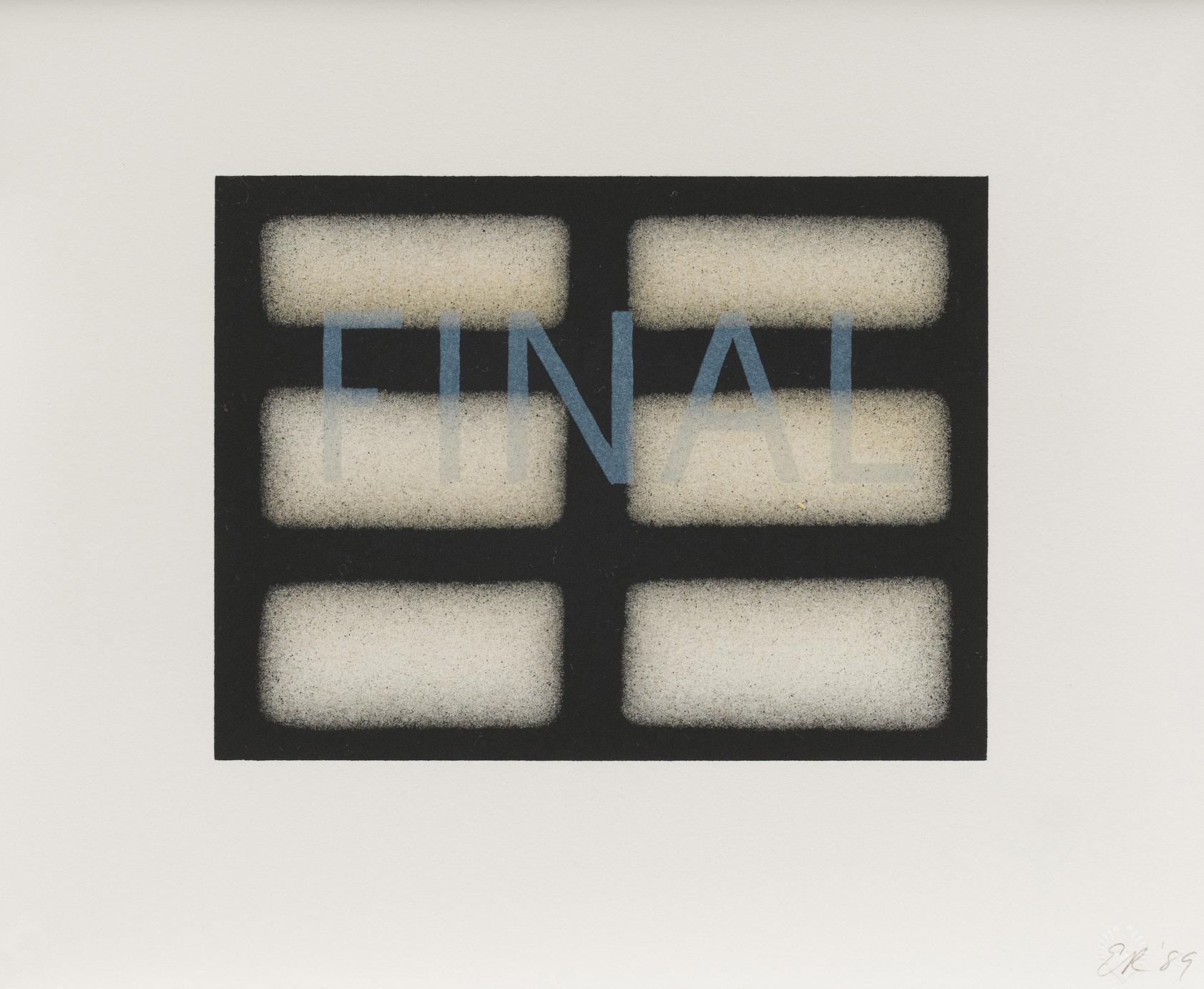
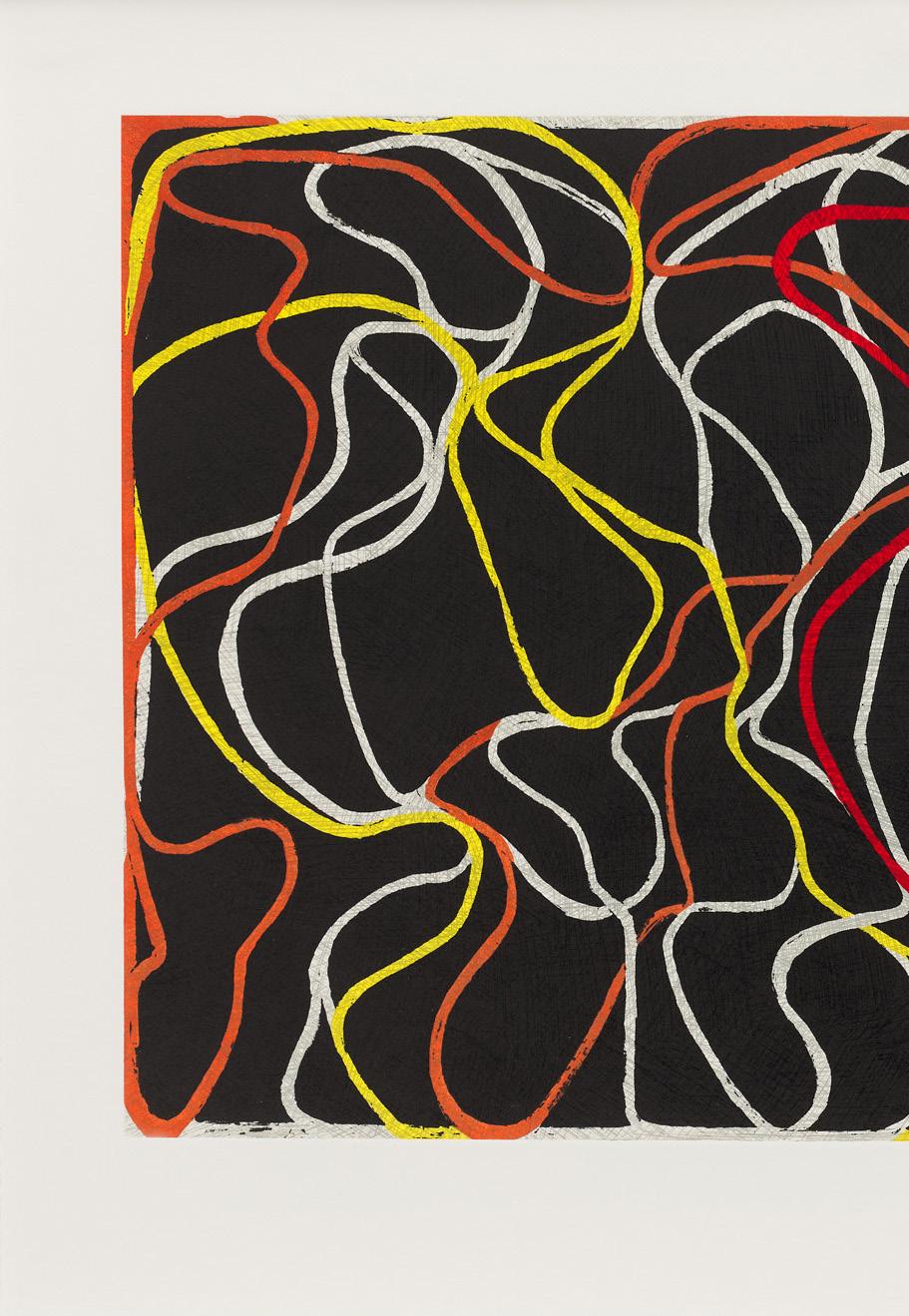
Brice Marden
Beyond Eagles Mere 2, 2001
Etching and lithograph
Sheet size: 22 x 30 1/8 inches (55.9 x 76.5 centimeters)
Printer and Publisher: Gemini, G.E.L., Los Angeles
Edition size: 45, plus proofs
Signed, dated, and numbered in pencil
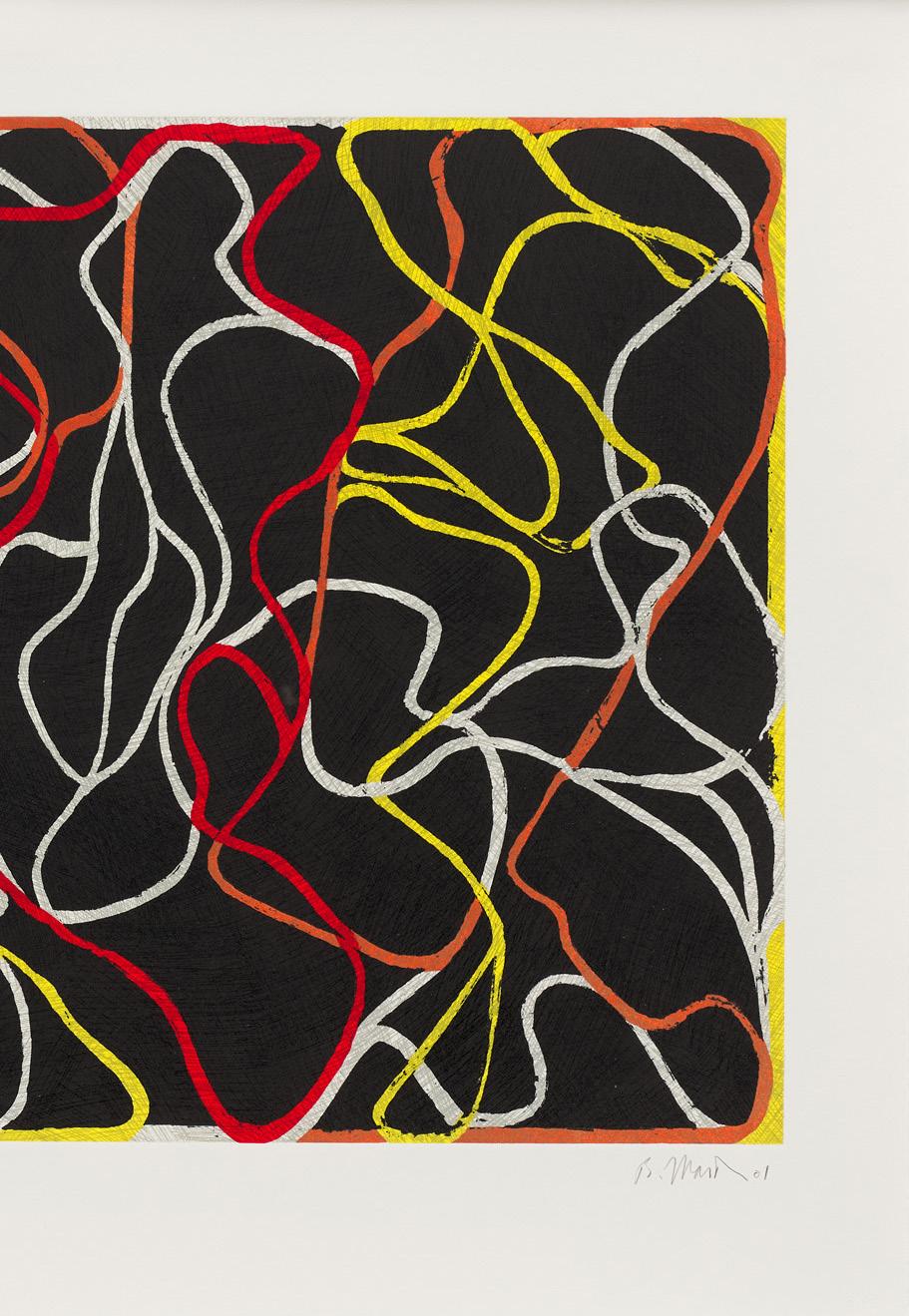
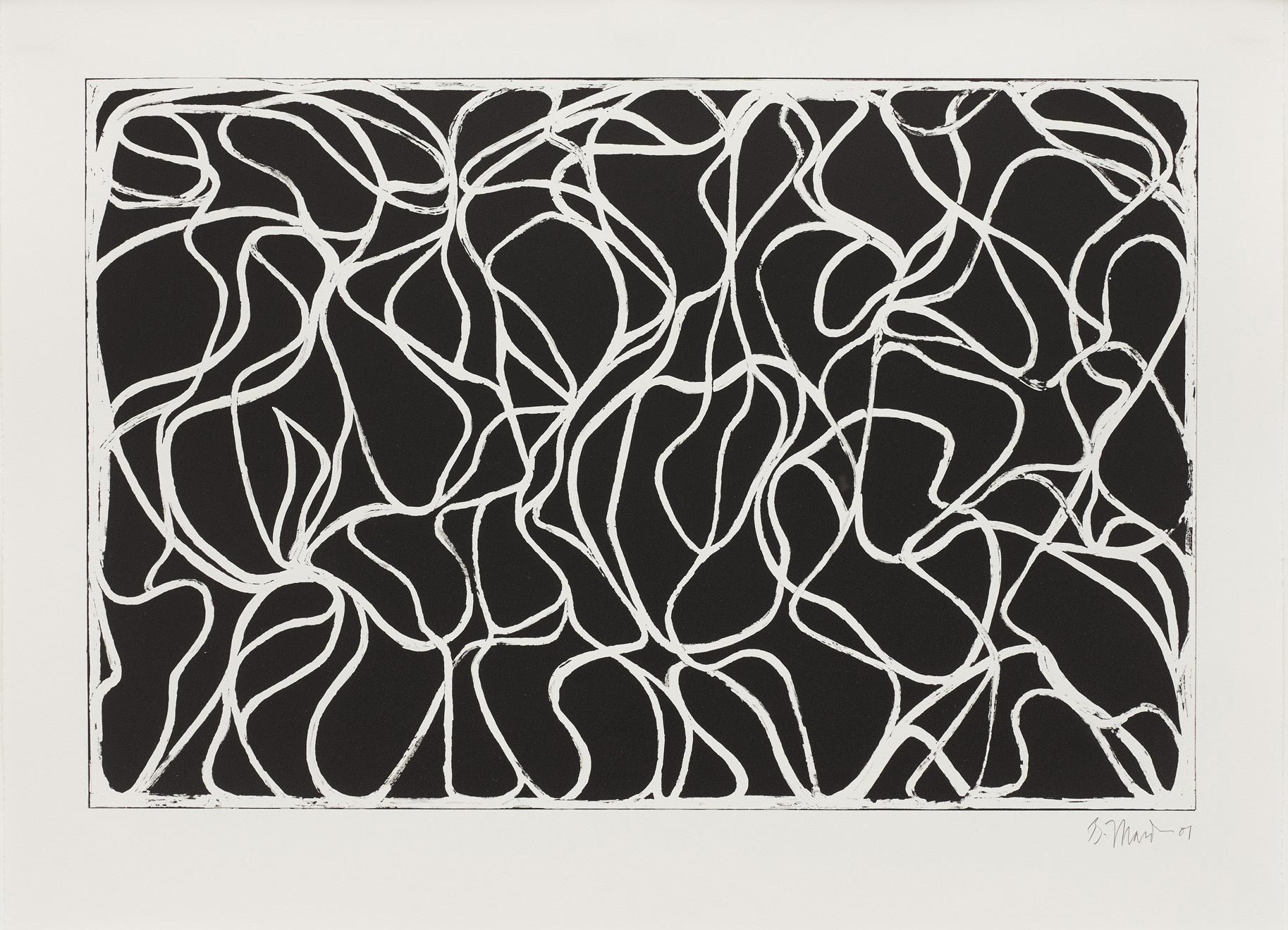
Brice Marden
Muses with Graphite, 2001
Lithograph with graphite
Sheet size: 22 x 30 inches
(55.9 x 76.2 centimeters)
Printer and Publisher: Gemini, G.E.L., Los Angeles
Edition size: 45, plus proofs
Signed, dated, and numbered

Red Line Muses, 2001 Etching and lithograph Sheet size: 22 x 30 inches (55.9 x 76.2 centimeters)
Printer and Publisher: Gemini, G.E.L., Los Angeles
Edition size: 45, plus proofs Signed, dated, and numbered
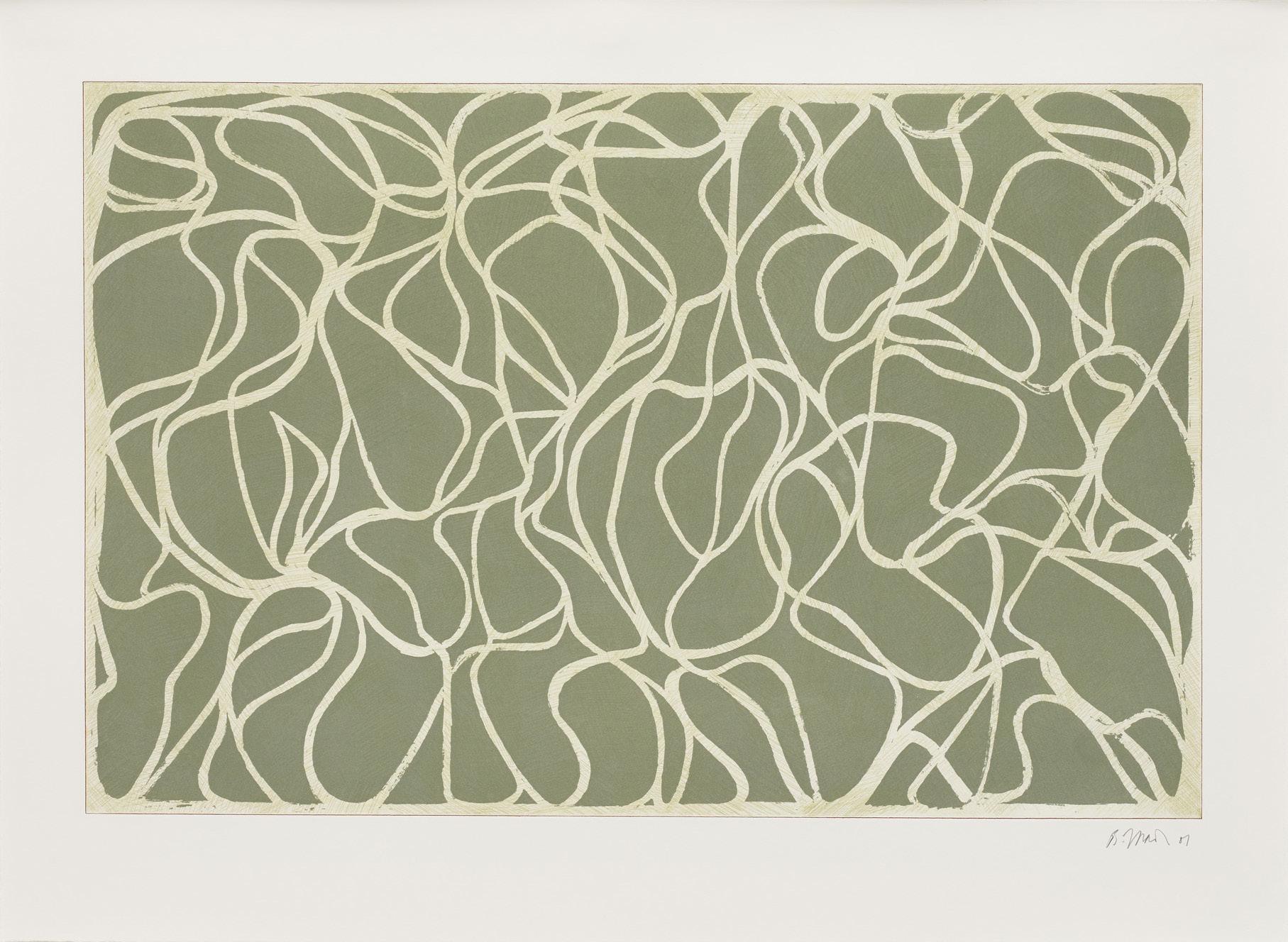
Greyer Muses, 2001
Etching and lithograph
Sheet size: 22 x 30 inches
(55.9 x 76.2 centimeters)
Printer and Publisher: Gemini, G.E.L., Los Angeles
Edition size: 45, plus proofs
Signed, dated, and numbered
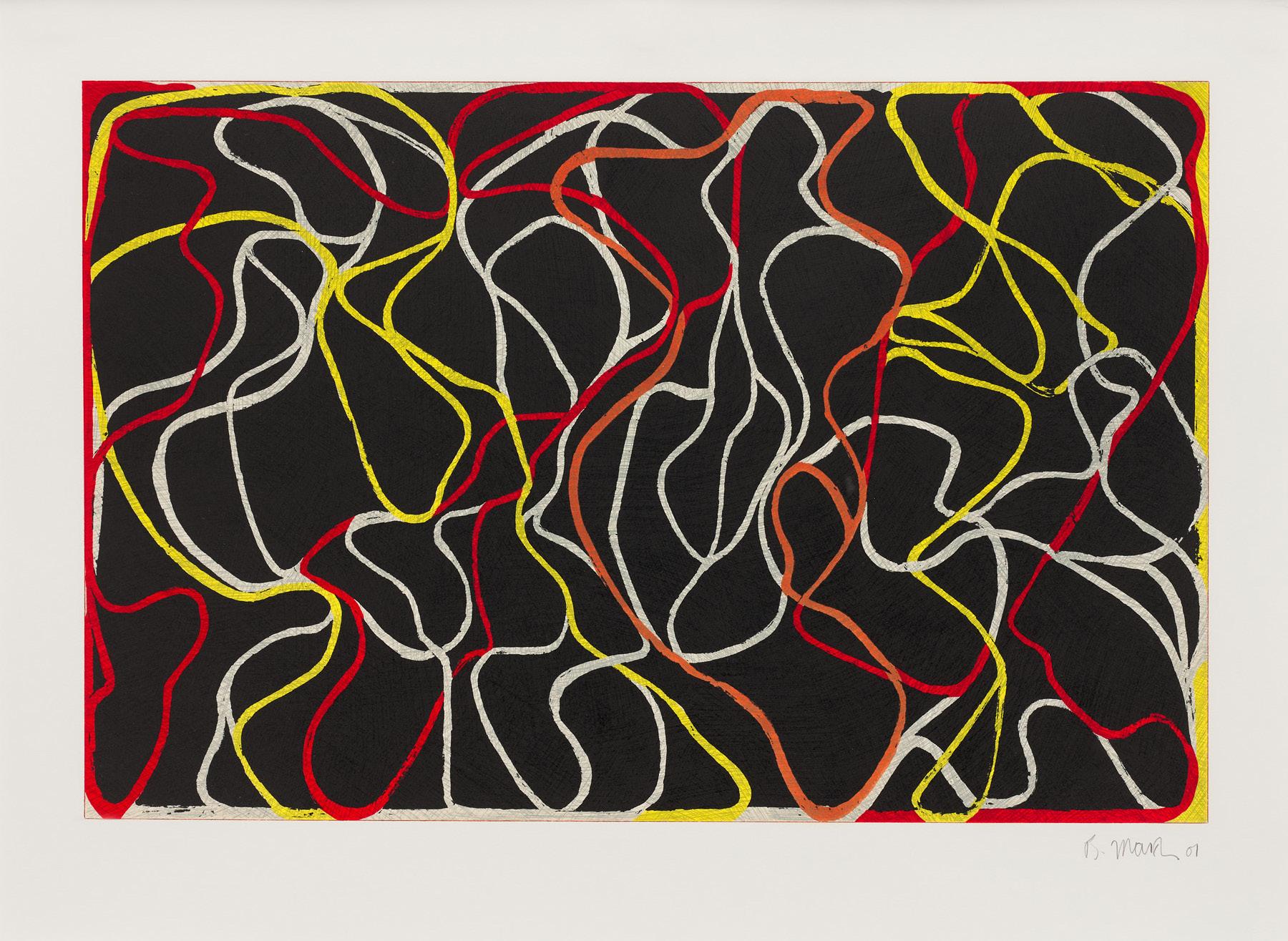
Beyond Eagles Mere, 2001
Etching and lithograph
Sheet size: 22 x 30 1/8 inches (55.9 x 76.5 centimeters)
Printer and Publisher: Gemini, G.E.L., Los Angeles Edition size: 45, plus proofs Signed, dated, and numbered
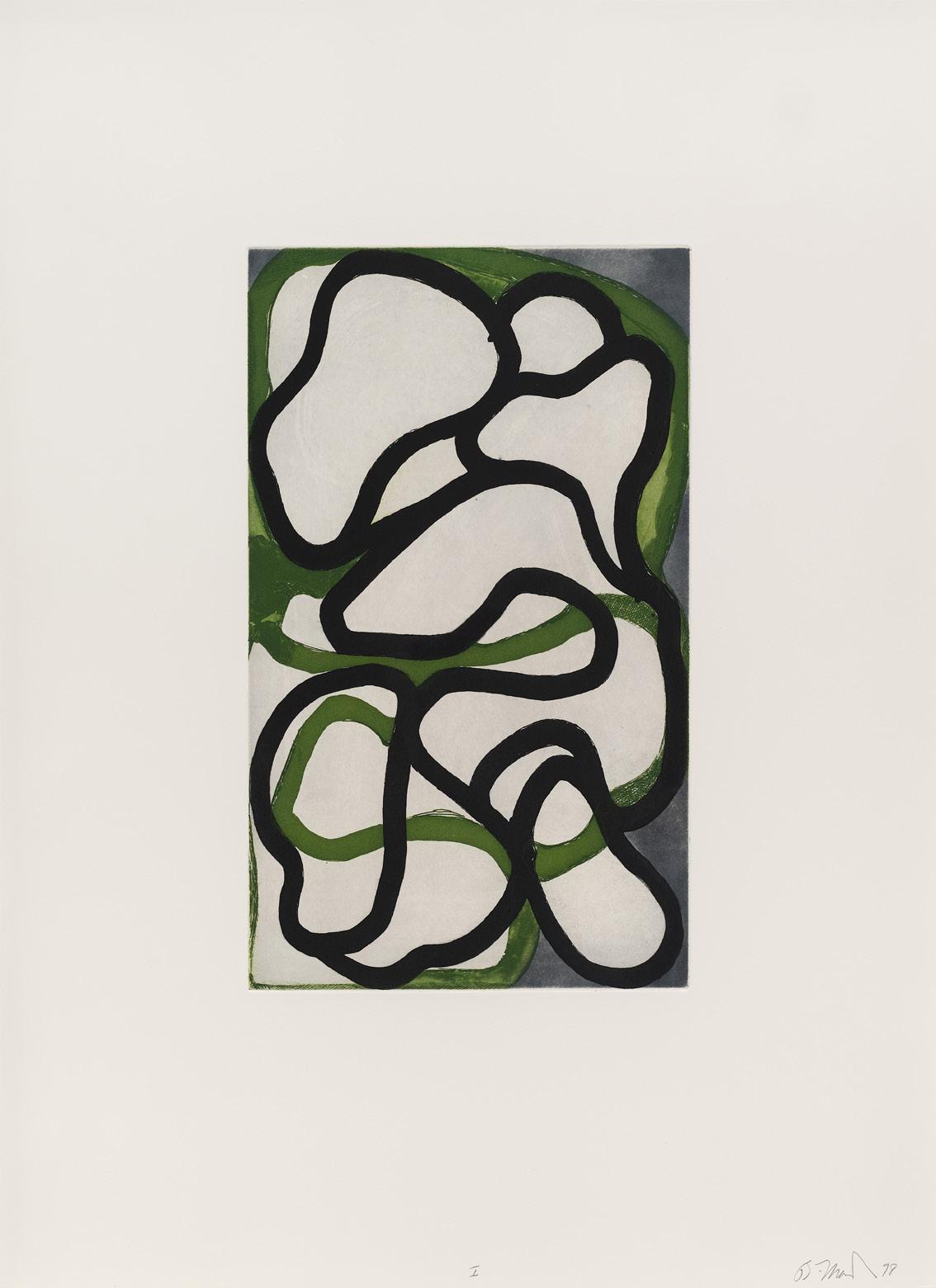
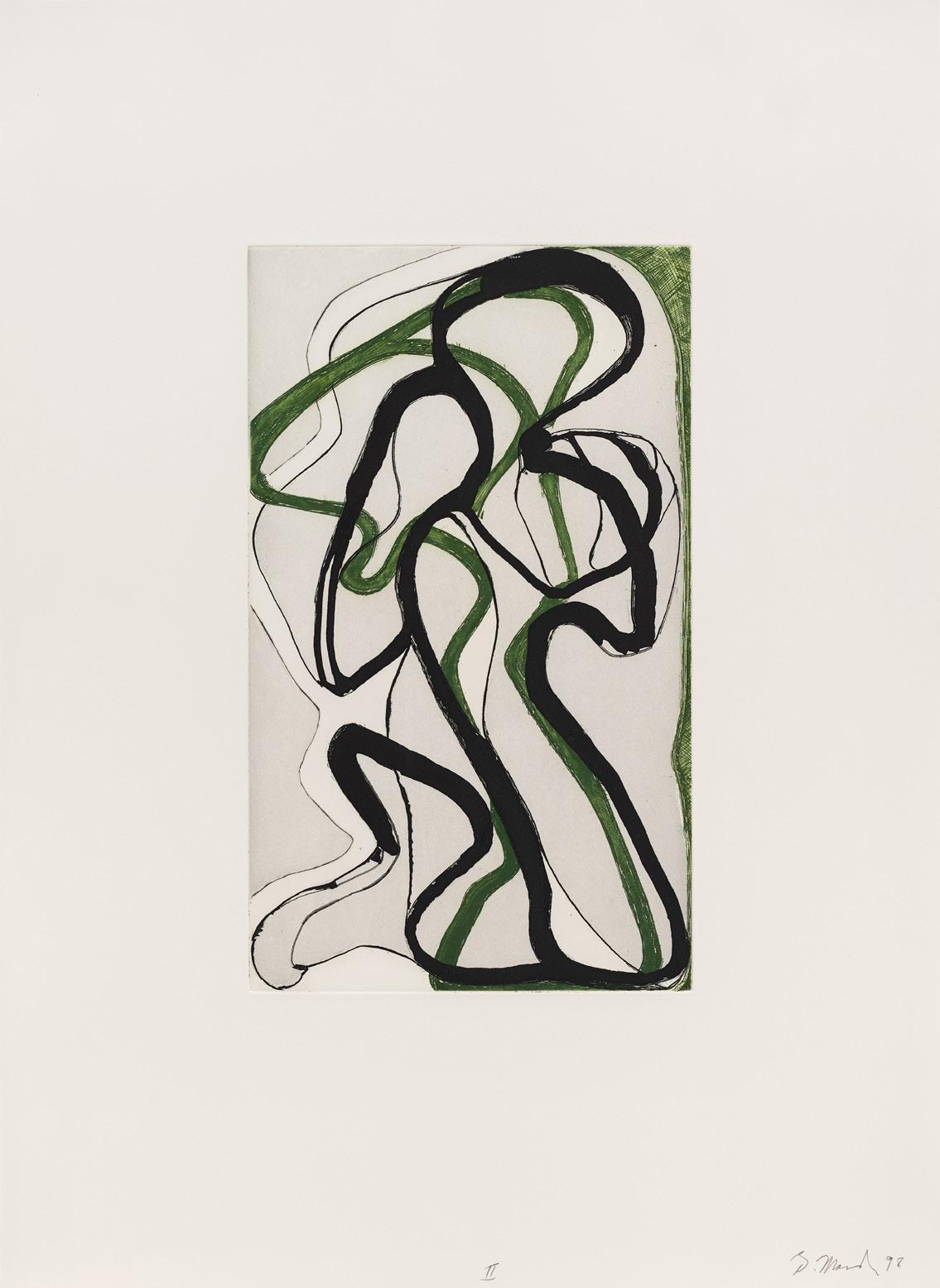
Brice Marden
Suzhou I-IV, 1998
Etchings with aquatint, drypoint, and scraping
Sheet size: 26 x 18 7/8 inches, each
(66 x 47.9 centimeters, each)
Printer: Jennifer Melby, Brooklyn
Publisher: The Artist
Edition size: 45, plus proofs
Each sheet is signed, dated, numbered, and titled sequentially ‘I’ through ‘IV’ in pencil
The complete set of four etchings with aquatint, drypoint, and scraping
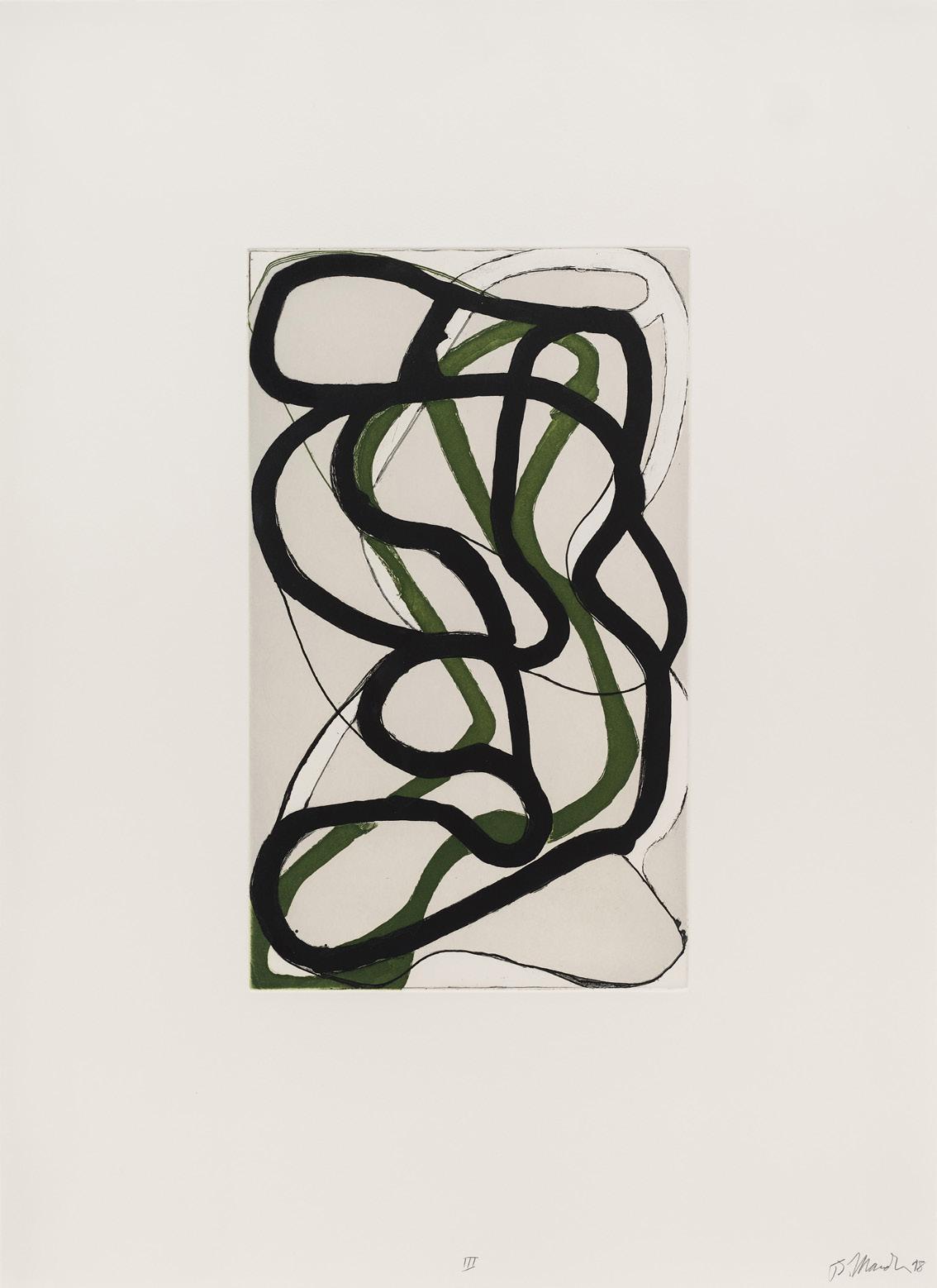
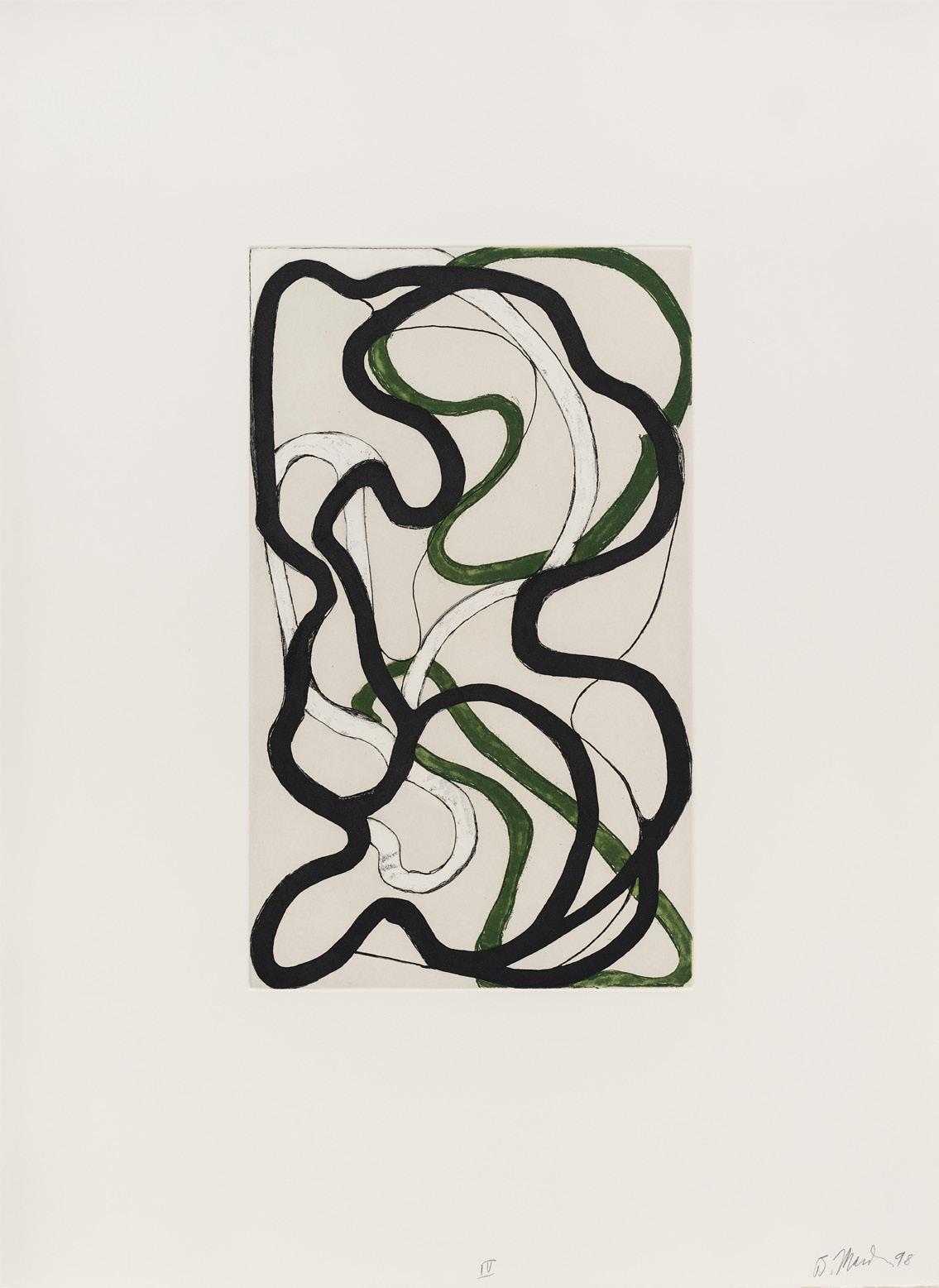
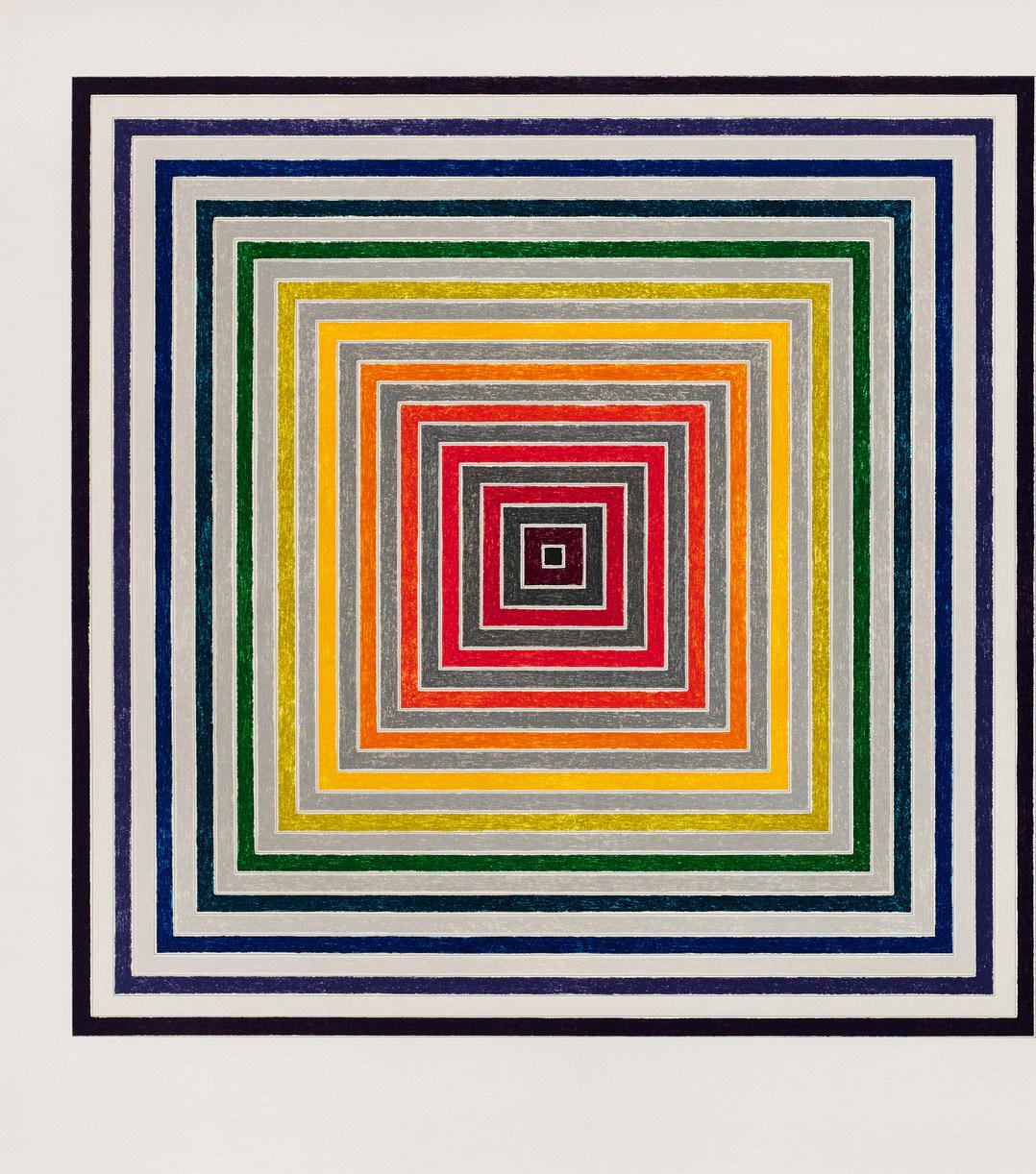
Frank Stella
Double Gray Scramble, 1973
Screenprint
Sheet size: 28 7/8 x 50 5/8 inches (73.3 x 128.6 centimeters)
Printer and Publisher: Gemini G.E.L., Los Angeles
Edition size: 100, plus proofs
Catalogue Raisonné: Axsom 93
Signed, dated, and numbered
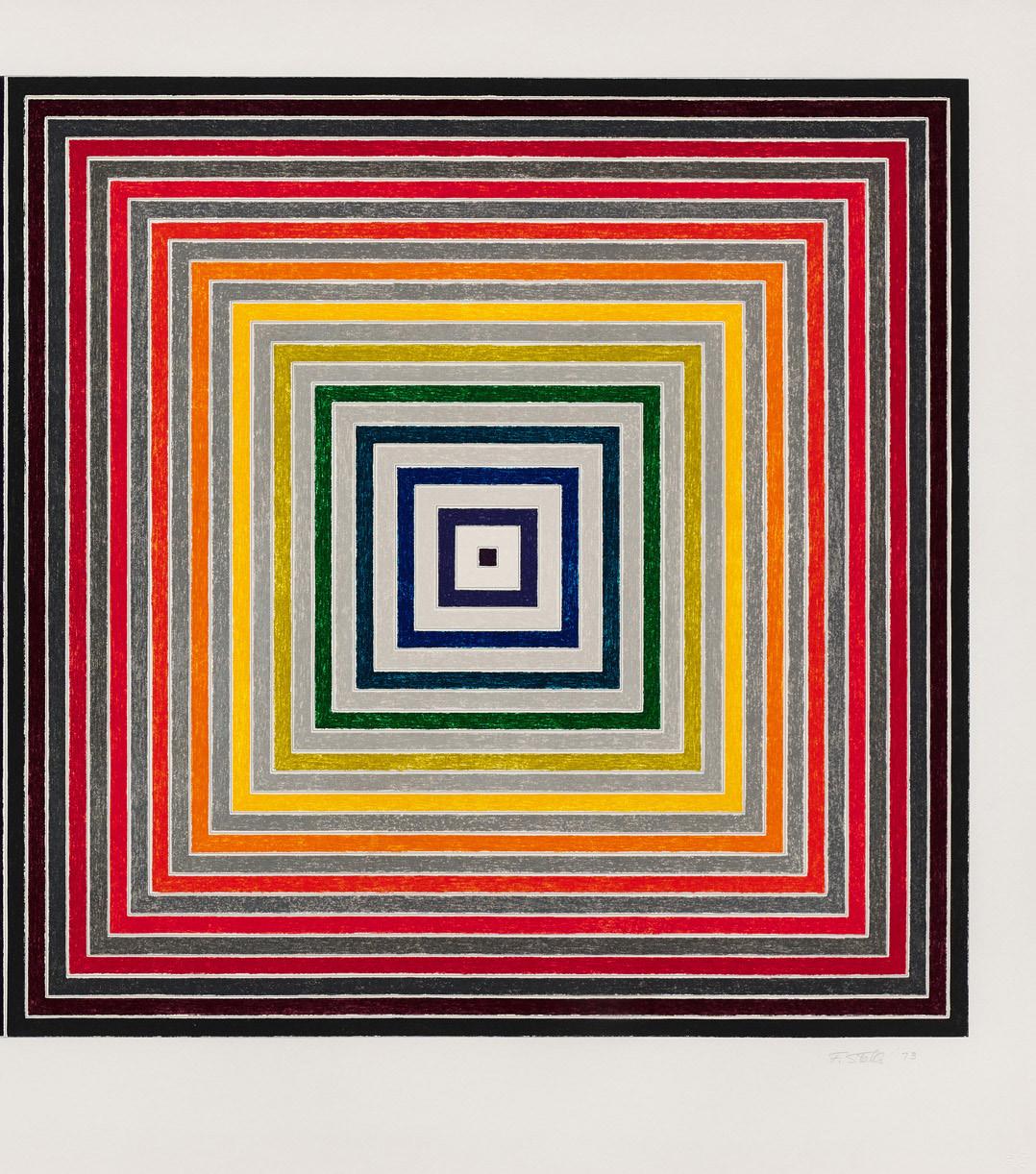

Dan Flavin
(to Don Judd, colorist) 2, 1987
Lithograph
Sheet size: 29 1/8 x 40 3/8 inches (74 x 102.6 centimeters)
Printer and Publisher: Gemini G.E.L., Los Angeles
Edition size: 30, plus proofs
Catalogue Raisonné: Gemini 17.2
Signed, dated, and numbered

Dan Flavin
(to Don Judd, colorist) 3, 1987
Lithograph
Sheet size: 29 3/8 x 40 1/4 inches (74.6 x 102.2 centimeters)
Printer and Publisher: Gemini G.E.L., Los Angeles
Edition size: 30, plus proofs
Catalogue Raisonné: Gemini 17.3
Signed, dated, and numbered
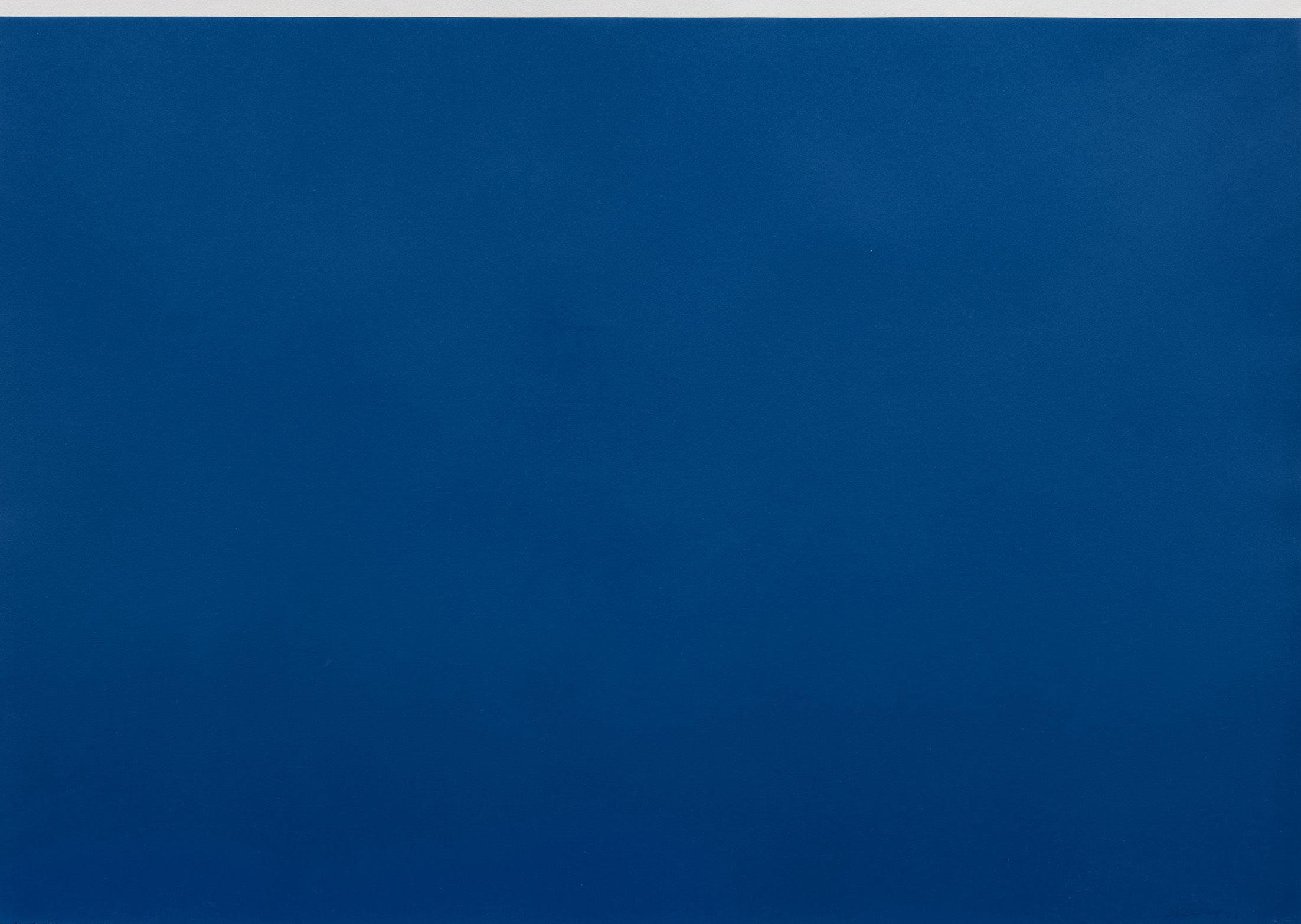
Dan Flavin
(to Don Judd, colorist) 5, 1987
Lithograph
Sheet size: 29 3/8 x 40 1/4 inches (74.6 x 102.2 centimeters)
Printer and Publisher: Gemini G.E.L., Los Angeles
Edition size: 30, plus proofs
Catalogue Raisonné: Gemini 17.5
Signed, dated, and numbered
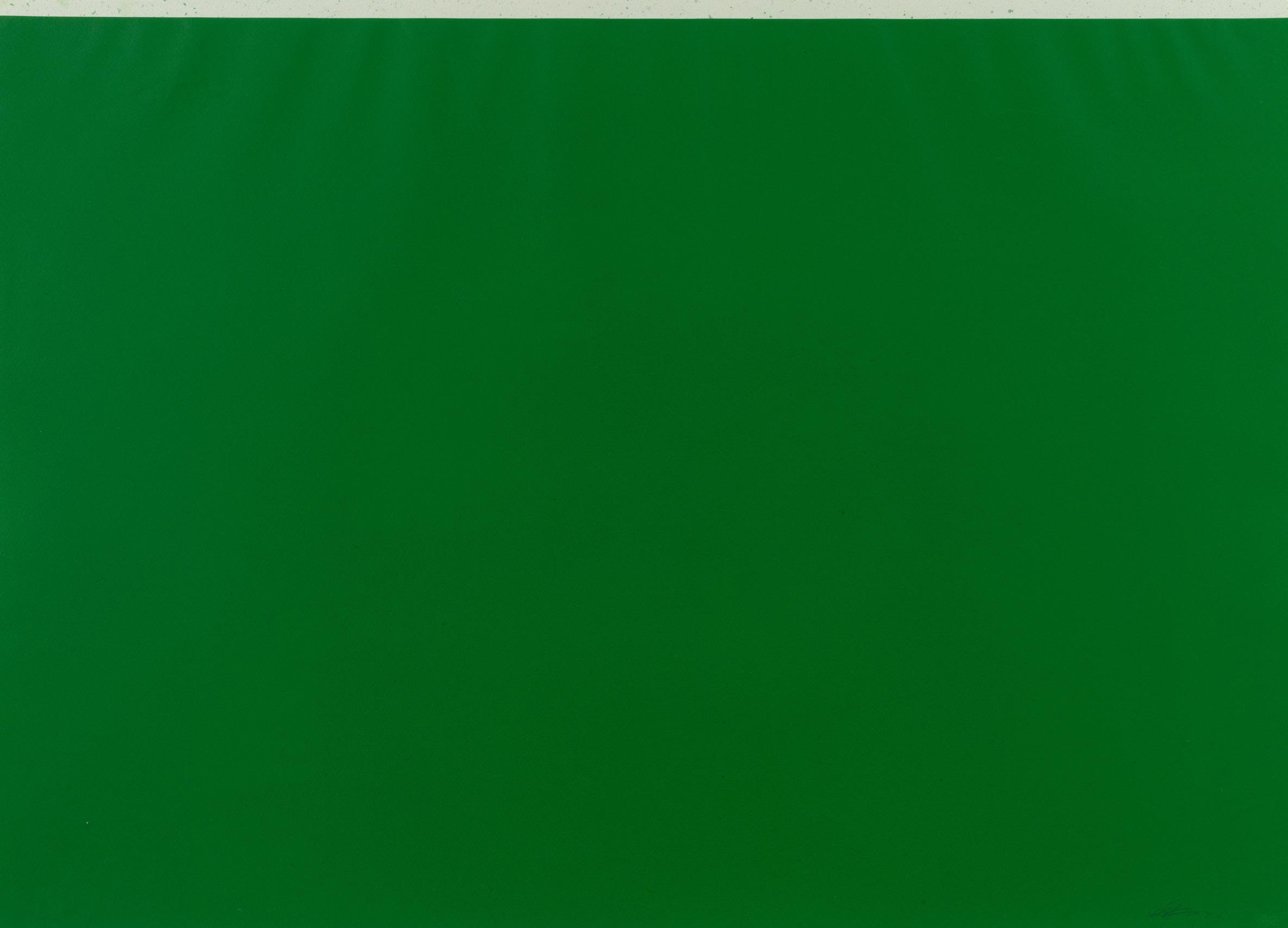
Dan Flavin
(to Don Judd, colorist) 6, 1987
Lithograph
Sheet size: 29 1/8 x 40 3/8 inches (74 x 102.6 centimeters)
Printer and Publisher: Gemini G.E.L., Los Angeles
Edition size: 30, plus proofs
Catalogue Raisonné: Gemini 17.6
Signed, dated, and numbered
December 1984, 1985
Mezzotint
Sheet size: 29 1/2 x 22 3/4 inches
(74.9 x 57.8 centimeters)
Printer: Dorris Simmelink, Gemini G.E.L., Los Angeles
Publisher: Gemini G.E.L., Los Angeles
Edition size: 25, plus proofs
Catalogue Reference: MMA 19, Gemini 9.10
Signed and numbered
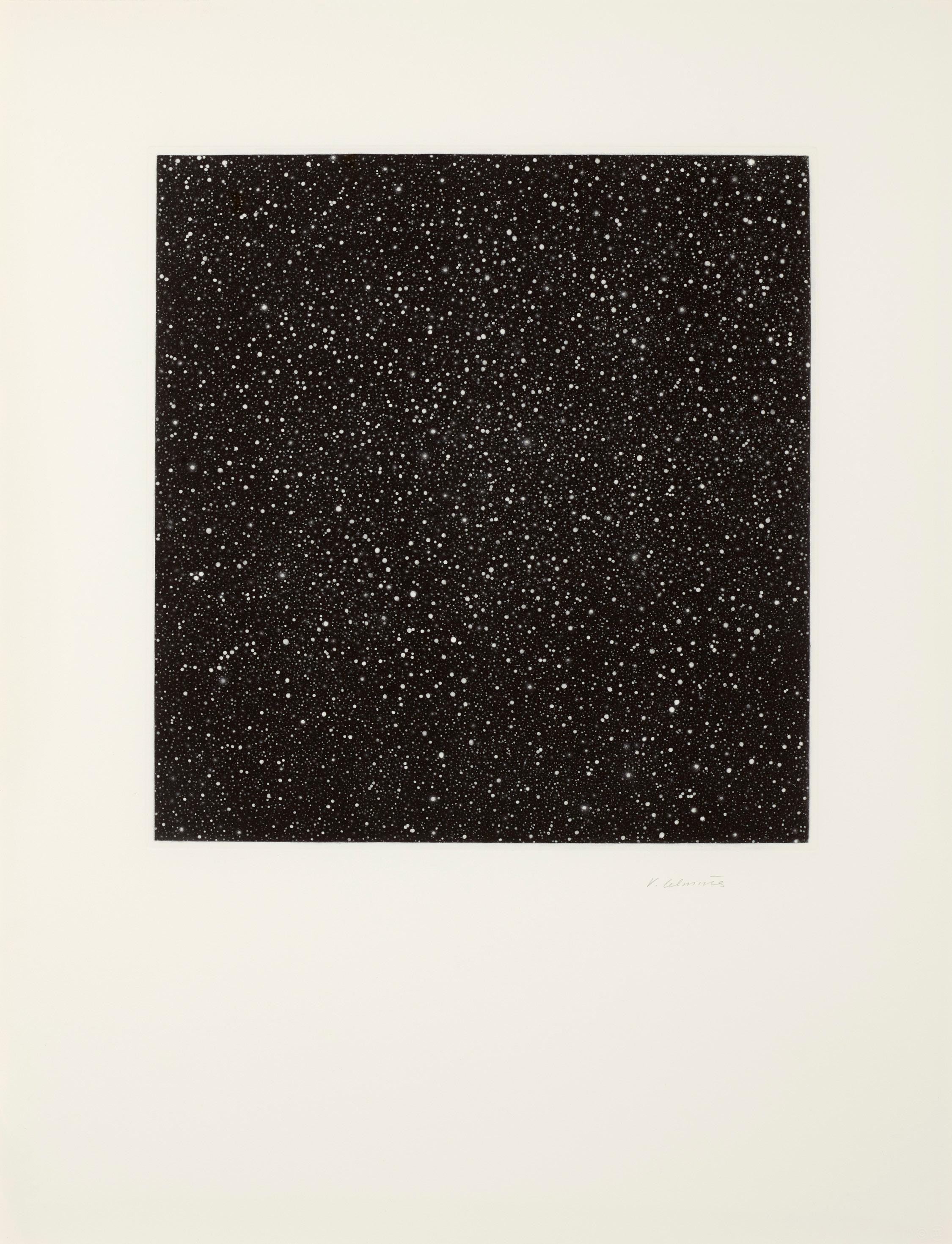
Night Sky Woodcut, 1997
Sheet size: 17 5/8 x 12 1/2 inches
(44.8 x 31.8 centimeters)
Printer: Leslie Miller, Grenfell Press, New York
Publisher: Grenfell Press, New York
Edition size: 30, plus proofs
Catalogue Reference: MMA 40 Signed, dated, and editioned
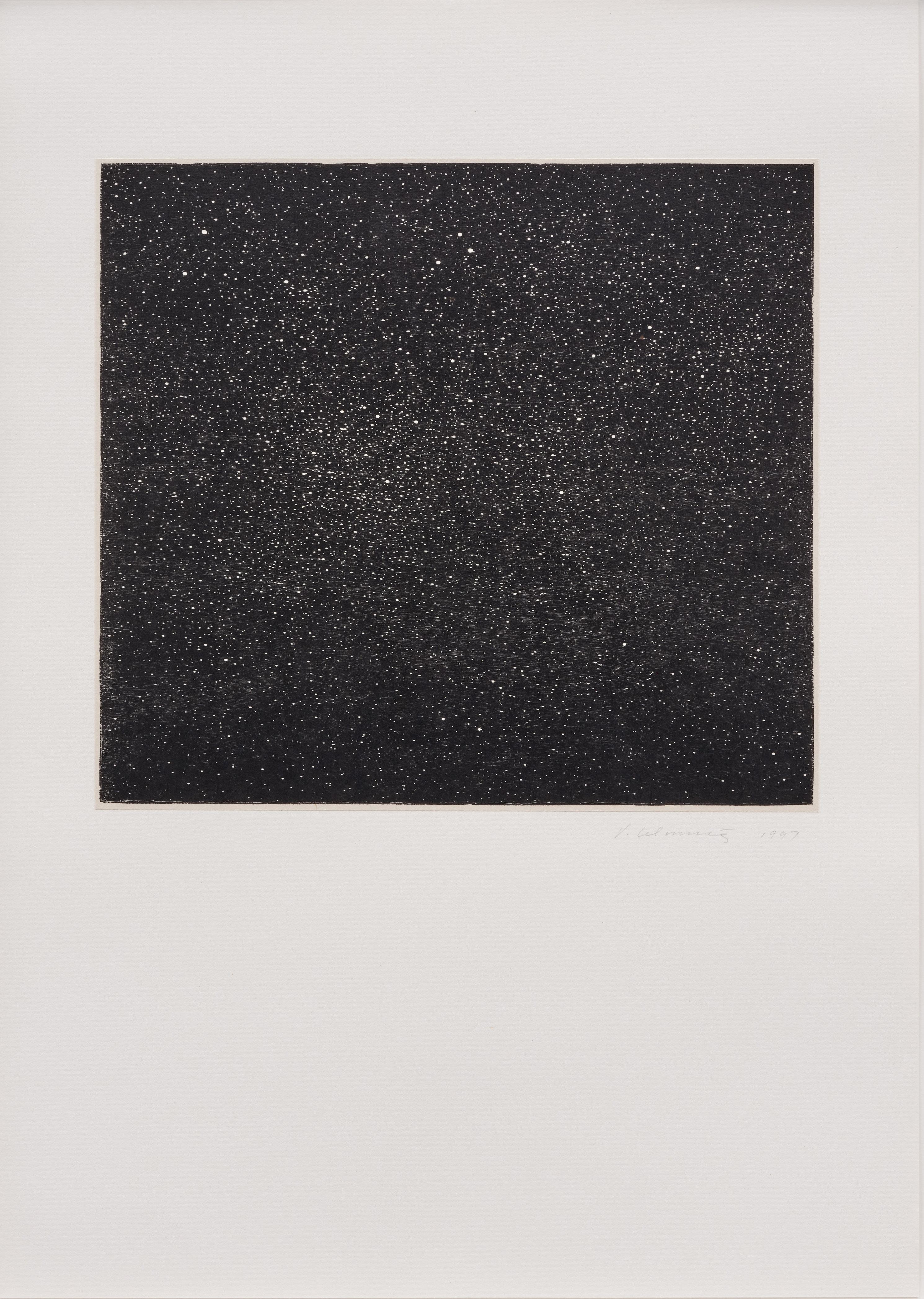
Untitled, 1995
Wood engraving
Sheet size: 16 x 14 inches (40.6 x 35.6 centimeters)
Printer and Publisher: Grenfell Press, New York
Edition size: 47, plus proofs
Catalogue Reference: MMA 38
Signed, dated, and numbered
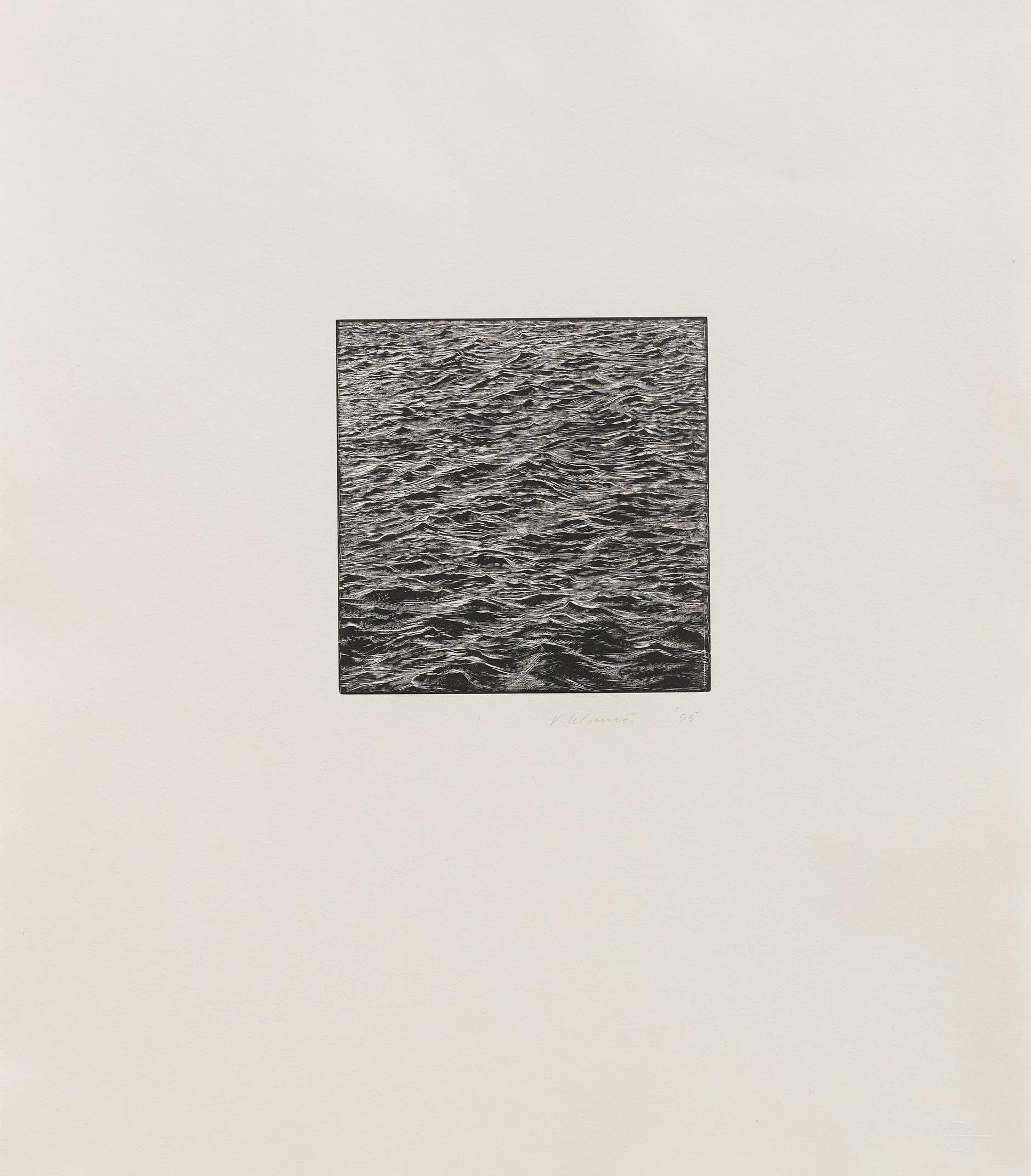
info@susansheehangallery.com
